The Ultimate Southeast Asia Itinerary
06/17/2018 by Ashley Yap 14 Comments
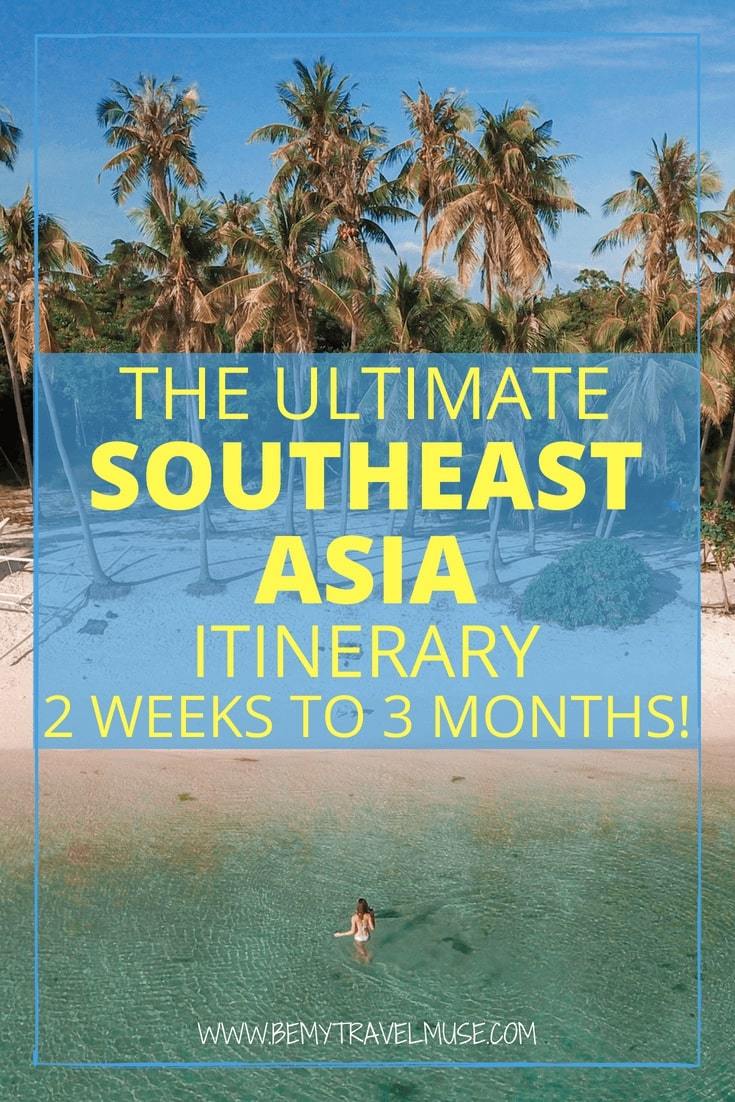
The parallel universe called Southeast Asia draws me in over and over again. Coming to Southeast Asia feels like coming home. Each time I return, I find comfort in the ease of traveling there, the excitement of new discoveries, and the energy hanging in the sweet, sticky air.
I’ve traveled in Southeast Asia for over 2 cumulative years, going from popular spots to places that do not even have an English name yet. Whether you are a budget backpacker, solo traveler, a couple, family, or a group of friends, Southeast Asia’s bound to have something intriguing for you. This could make planning a trip to Southeast Asia overwhelming – there’s just so much to see and do!
So let’s make it easy. Here are a few amazing Southeast Asia itineraries, customized to different interests, ranging from 2 weeks to 3 months:
Table of Contents

2-Week Southeast Asia Itinerary
While two weeks is simply too short to attempt to see all of Southeast Asia, the good news is that you can still get a delicious taste of Southeast Asia all within 2 weeks.
My advice is to pick fewer places to see, and take travel time into account. Some countries like Singapore, Malaysia, and Vietnam are easy to get around, whereas countries like Myanmar and the Philippines require much longer travel times to move from one place to another. Here are a few itinerary suggestions for 2 weeks in Southeast Asia that cover 2 countries:
Best of Both Worlds: Philippines + Singapore
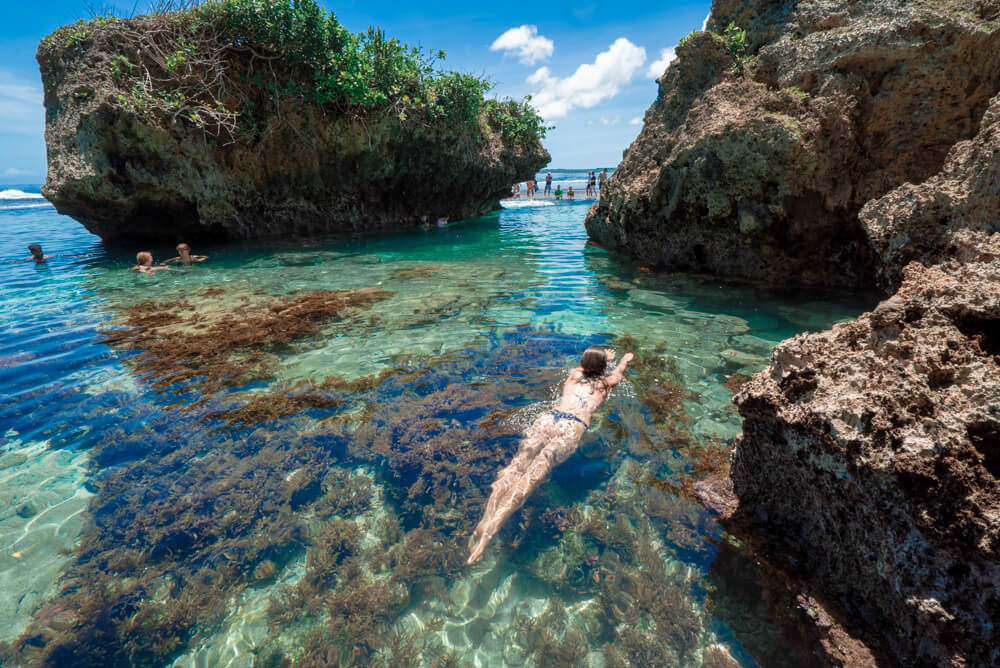
Spend about 10 days in the Philippines and maximize your time in nature, be it the beautiful islands , the most stunning rice terraces, or the amazing waterfalls. You can narrow down the specifics by picking your favorites from this itinerary . Then fly over to Singapore and enjoy the metropolitan city, eat all the food, and have the country’s signature drink, Singapore Sling, at one of the many speakeasy cocktail bars before your flight home.
Hiking Adventures: Borneo + Indonesia
Spend about 4 days in Borneo and hike up to the country’s highest peak, Mount Kinabalu , which requires a minimum of 2 days, then check out the orangutans of Sepilok. Next, fly over to East Java, Indonesia, to hike Mount Rinjani , or Mount Bromo . Spend your last few days relaxing in Bali or Lombok before flying home.
Sun, Sea, and Salt: Southern Thailand + Malaysia
Spend a week in each country. Both countries are home to some of the most gorgeous islands I’ve ever been to. Some of my favorite islands are Koh Chang , The Similan Islands, Koh Yao Noi , Langkawi , The Perhentian Islands, and Tioman Island.
A Cultural Experience: Myanmar + Cambodia
Spend about 10 days in Myanmar, not only because there’s so much to see and do , but also because transportation can be pretty difficult. Expect to spend some nights on bumpy overnight buses. Bagan, Mandalay, and Yangon are awesome for anyone seeking a cultural experience thanks to the beautiful temples and the less touristy feel of Myanmar. Fly over to Cambodia and continue your journey with an awe-inspiring trip to the majestic Angkor Wat (you will need at least 2 full days for that, trust me!), and hang out with the locals before your flight home from Siem Reap.
Overland Travel: Southern Vietnam + Cambodia
Spend a week in each country. There’s a ton of things to do in both southern Vietnam and Cambodia, but it’s also easy to pick and choose based on your interests. My suggestion is to start your trip in Siem Reap and see as much as you can of Angkor Wat in 2 days, and take an overnight bus to Sihanoukville’s Otres Beach for some R&R time, before another bus ride to Ho Chi Minh City. Apart from eating all the food , there’s a lot of history to explore especially for those interested in visiting the Củ Chi tunnels and the War Remnants museum. From there, it’s another bus ride to Mui Ne for some sandboarding fun, and Da Lat to check out some beautiful waterfalls, before flying home from Ho Chi Minh City.
Slow-Paced Travel: Laos + Northern Thailand
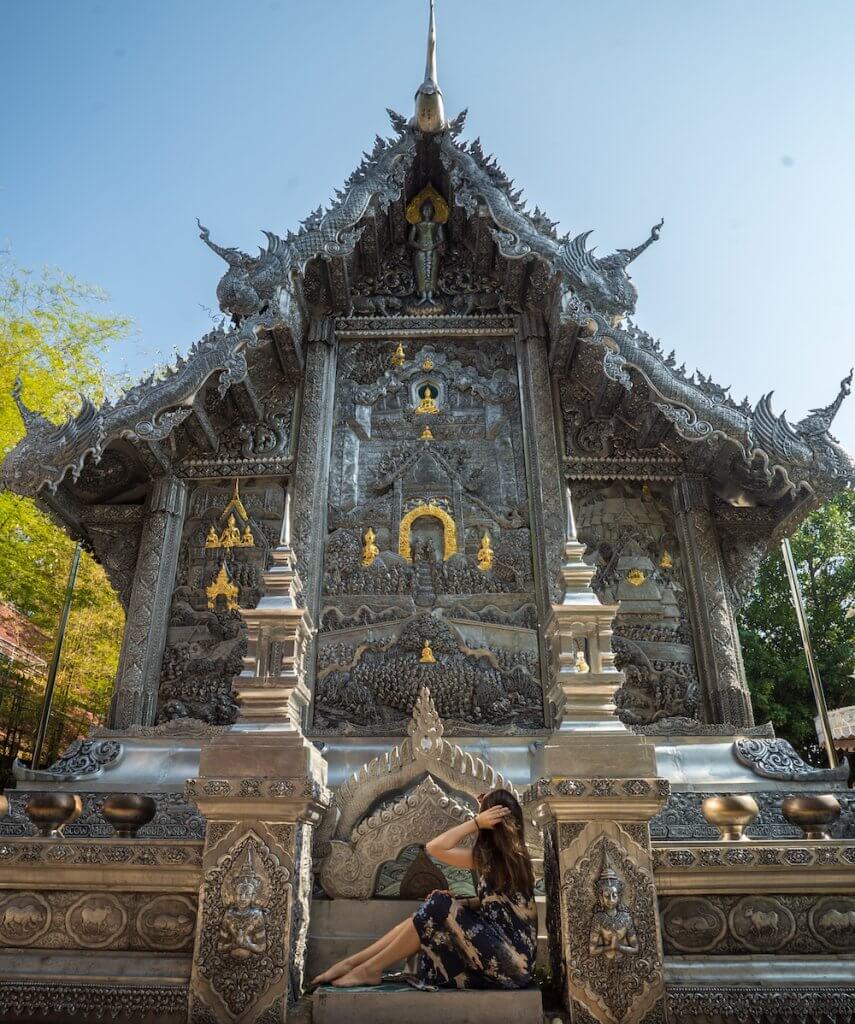
Laos is incredibly slow paced and rustic, which is great for relaxation and discovery. Spend about 9 days in Laos and you will find yourself surrounded by the most incredible waterfalls in the northern city of Luang Prabang, floating down the river on a tube, or motorbiking the Bolaven Plateau down south. Then take a slow boat to northern Thailand, and spend the next few days exploring Pai , savoring delicious local food, and temple hopping in Chiang Mai before flying home.
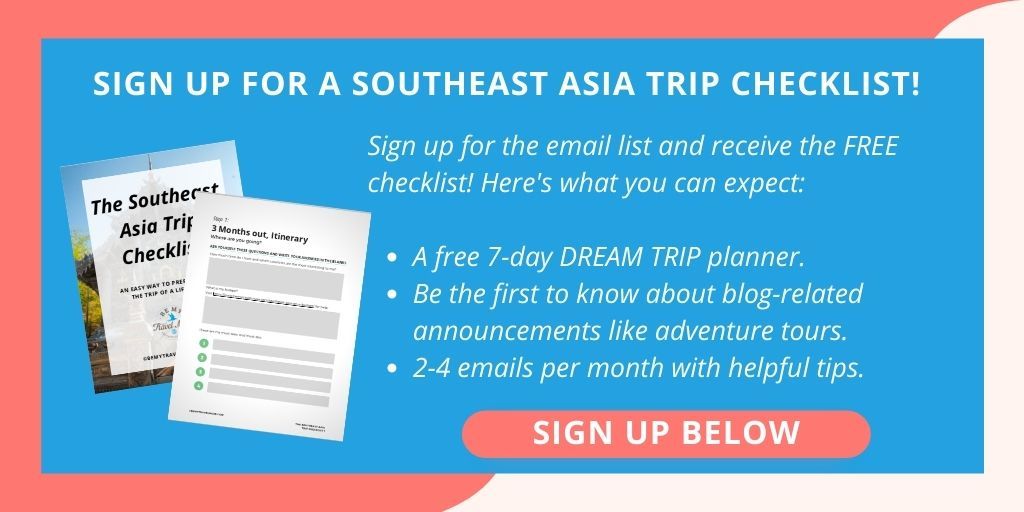
First Name:
1-Month Southeast Asia Itinerary
If you have a full month, I’d suggest picking 1 country and really doing it justice, or picking 2 countries and spending about 2 weeks each. You can refer to the itineraries above and combine 2 of them, or pick 3 countries and spend about 10 days each. Here are some more adventure possibilities:
Island Fever: Philippines + Indonesia
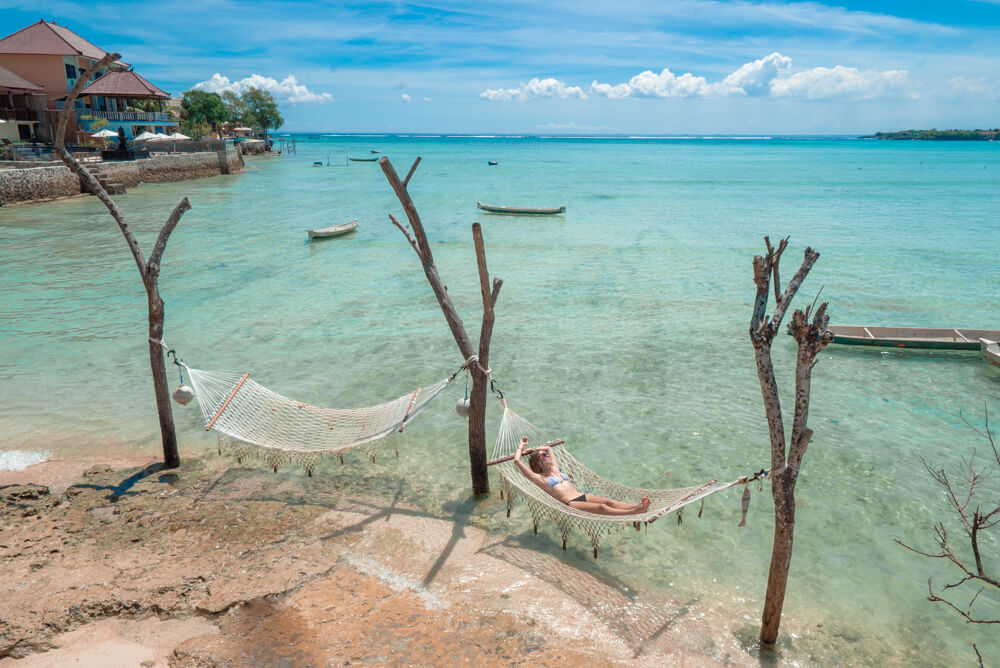
One could easily spend a full month just in Indonesia or the Philippines, and still feel rushed since both are island nations with so much distance to cover. The good news is both have tons of variety and each one has its own unique luster. The Philippines is known for friendly people and stunning beaches, whereas Indonesia is known for having great food, some of the best diving in the world, and unique culture on each island. The good news is both are pretty cheap to enjoy. I suggest either picking one to explore over the course of one month, or spending half of your time in each. Here’s a Philippines itinerary and an Indonesia itinerary to help you narrow down exactly where you wish to go.
If you’re into diving, after much exploration in all of the best spots in both the Philippines and Indonesia, I can confidently recommend Raja Ampat if traveling in October – April and Komodo if traveling in May-September. Both will blow your mind!
Food and Culture: Singapore + Northern Thailand + Myanmar
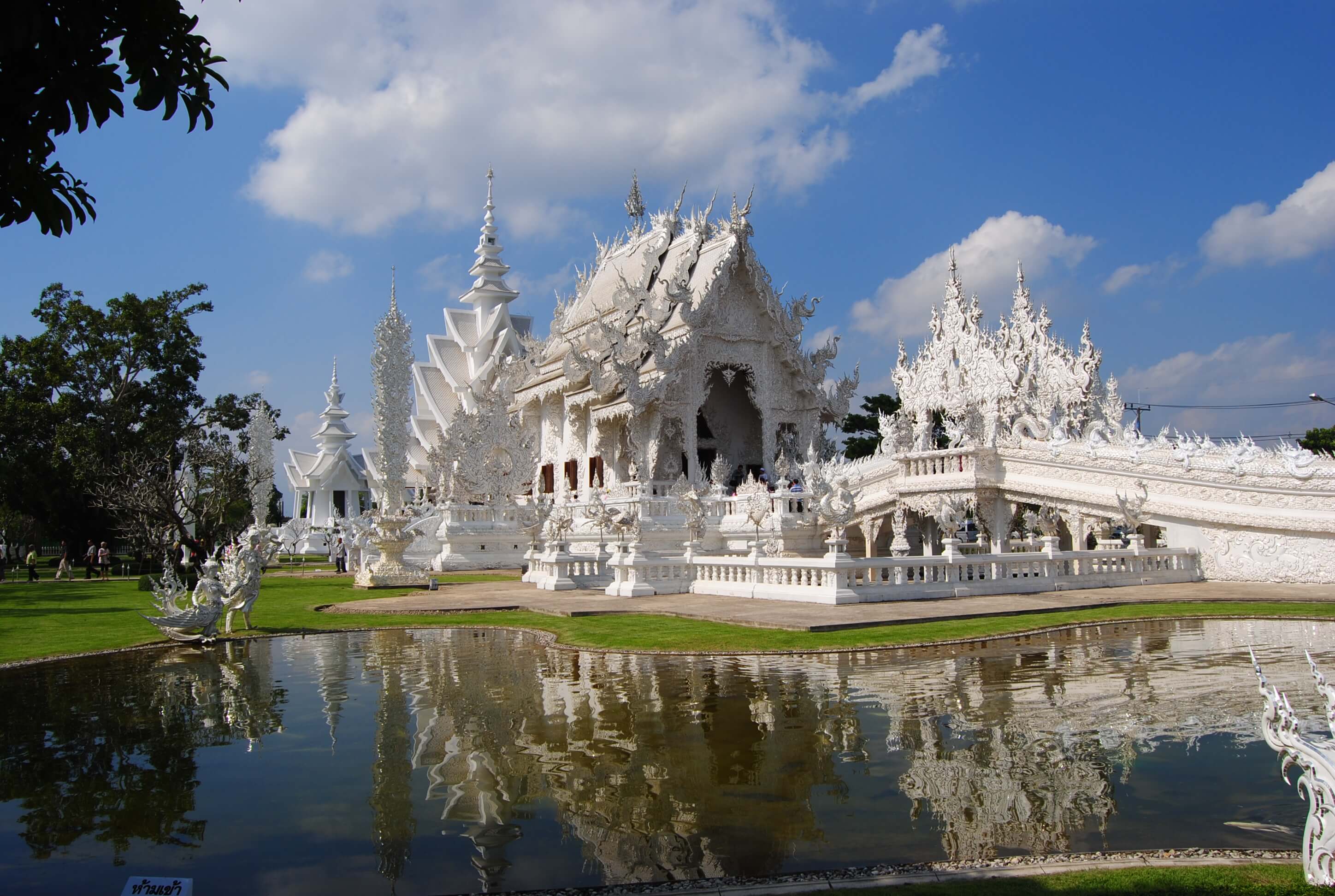
Myanmar is not the quickest to travel through, but it’s also one of the best places in Southeast Asia for cultural exploration, gorgeous temples, friendly locals, and an opportunity to head farther off the beaten path than one can find in places like Thailand these days. With three weeks in Myanmar, you should be able to complete this Myanmar itinerary .
Best of both worlds: Vietnam + Cambodia
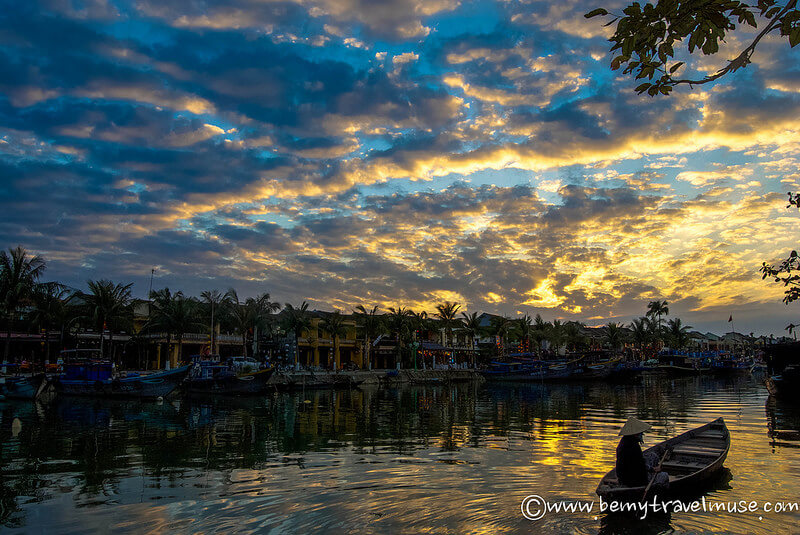
One of the best trips in Southeast Asia is traveling from tip to tip of Vietnam, either beginning in Hanoi or Ho Chi Minh City (but don’t forget to include Sapa, Vietnam !). Give this Vietnam itinerary at least three weeks if you can, then head into Cambodia for Angkor Wat and if you have time, check out the smaller towns like Kratie in Cambodia or head to the coast.
Off the beaten path: Laos + Myanmar
If you want to get away from the typical tourist route and are at peace with missing the Thai islands, focus on Laos and Myanmar, both of which are stunning countries that get fewer visitors. Either give two weeks to each country, picking your favorites from the Laos and Myanmar itineraries , or give one more weight and spend the bulk of your time in whichever calls to you more. Just make sure that at some point, you’re able to get to a major enough city to fly between the two to save time.
3-Month Southeast Asia Itinerary
You’ve got three months in Southeast Asia? Awesome! You can take your time more and enjoy each place you visit a bit more fully and feel less like you’re rushing around. While it may be tempting to try to blast through every country in Southeast Asia within these three months, as many travelers do, I highly advocate taking this time to more deeply immerse in the local culture and explore further than the well known destinations.
Since you have so much more time than the other itineraries, I’d leave a lot more room for serendipity and just pick a few must-sees to plan your trip around.
Here are the places that I recommend based on different interests to help you build a framework:
If You’re into Local Culture
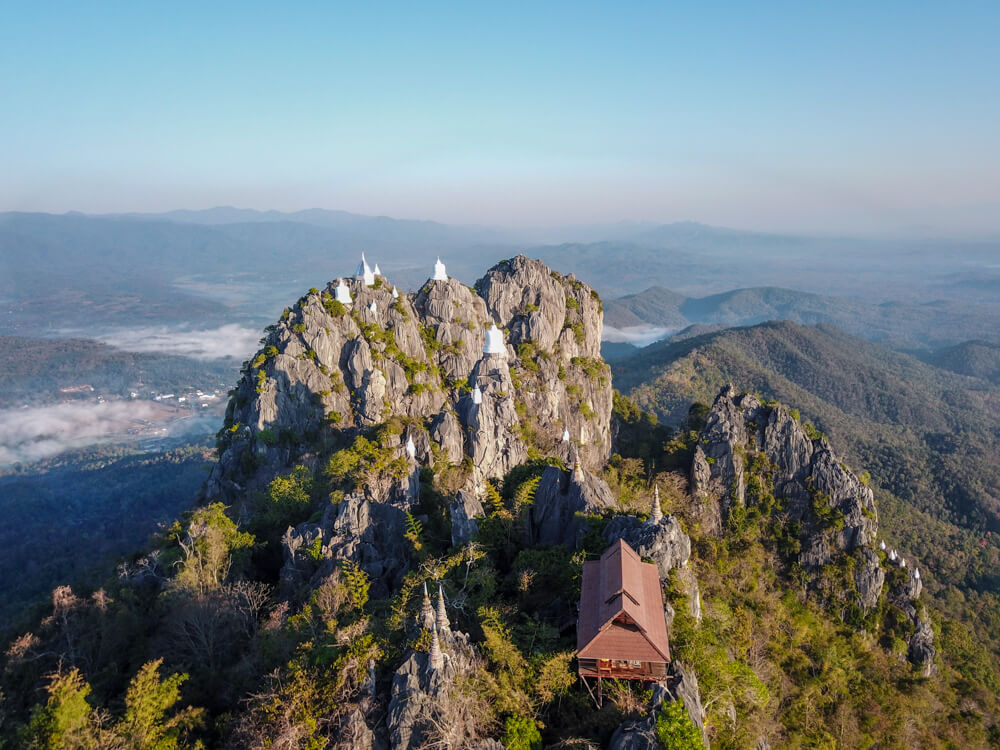
For me, part of the allure of Southeast Asia is the various cultural sites and temples. Most countries have an interesting mix of different history, religions, and beliefs, resulting in different religious sites, styles of architecture, and cuisines. Here are the go-to places if you want to immerse yourself in the local culture:
Bagan, Myanmar: A UNESCO Heritage site and valley of more than 2,000+ ancient temples built during a golden era of Burma in the 12th century, this place is a must-see if you love temples. The best way to explore Bagan is to rent a bike and roam freely. Chances are you will end up in your own private little temple with no one else around to catch a beautiful sunrise or sunset.
Inle Lake, Myanmar: The floating villages, which are essentially neighborhoods on stilts, where locals live in huts built above a network of marsh and grass waterways, is a beautiful place to take a peek at the locals’ daily life. Take a boat and see what it’s like living on water.
Luang Prabang, Laos: Aside from the popular Kuang Si Waterfalls, Luang Prabang is also known for the early morning alms, where hundreds of monks walk along the streets to collect offerings from the locals. It is quite a sight that is worth setting your alarm for. Just make sure you watch it with distance and respect, and not be one of those tourists who shove their big cameras up in the monks’ faces.
Siam Reap, Cambodia: Angkor Wat is perhaps the most recognizable temple in Southeast Asia. Though the ticket prices have increased steeply over the years, you should still consider visiting it, especially if you are interested in temples and ruins.
Chiang Rai, Thailand: The north of Thailand is home to some of the most creative temples I’ve seen, and there are hundreds of them. I promise you won’t get templed out if you pick the right ones to visit, though. My personal favorite is the White Temple , an architectural wonder that started in 1997, and is still undergoing construction until 2070.
Borneo: In Sarawak, the local tribes stay together in a longhouse. By together, I mean with the entire extended family. You can arrange a longhouse homestay with the local communities and experience what it’s like to live as a local tribe. Follow the family around as they go about their day, hang out with the children, and chat with the elders for a unique and unforgettable experience. Similar experiences are available in Sapa, northern Vietnam.
If You’re a Foodie
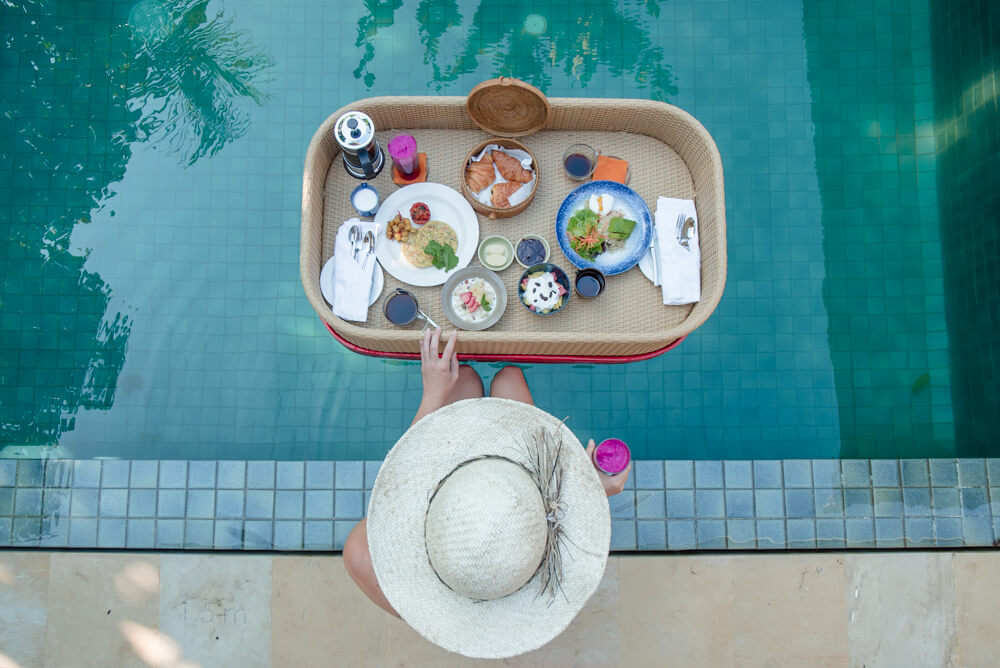
Bangkok, Thailand: So. Much. Food! Whether it’s a local food market, street food stalls, or the restaurants galore in the giant shopping malls, Bangkok is guaranteed to satisfy your appetite. What’s really cool about Thai food is that you can try the same dish at drastically different price points. Pad Thai is a great example – I’ve had them straight from the wok at a night market for less than $1, at local restaurants for a bit more, and at luxury hotels for 5 times the price. To be honest, the street version is always my favorite! Needless to say, being a foodie in Bangkok is a lot of fun. Here are a few more of my suggestions on how to really fall in love with Bangkok.
Chiang Mai, Thailand : Aside from the delicious northern cuisine, Chiang Mai is also a great place to attend a cooking class and bring new skills home. In Chiang Mai, I went with Basil Cookery school which was pretty healthy and very well-run. You can see more about the cooking class and other Chiang Mai favorites here.
Kuala Lumpur, Malaysia : The capital city of Malaysia is a foodie’s wonderland, thanks to the country’s multiracial profile. Spoil yourself and indulge in Chinese, Malay, Indian and international cuisine at a reasonable price range. Immerse in the local culture by checking out a mamak (Indian Muslim eatery) for some awesome supper at night. There is a popular mamak within walking distance from the Petronas Twin Towers, in case you are wondering which one to go to!
Hanoi, Vietnam : Vietnamese food is a powerhouse mix of influences from all over the world. French, Chinese, and Japanese flavors blend with Vietnam’s own unique approach to food to create an unforgettable culinary experience. In Hanoi, the best way to sample the food is through a street food tour. Just ask your hostel / hotel for recommendations! Also, don’t forget to try an egg coffee at Cafe Giang! It sounds strange but it’s probably the best coffee I’ve ever had in my life, and that’s coming from a friend.
Singapore : As it’s the most expensive country in Southeast Asia, one would think that eating in Singapore is an expensive affair. I was very pleasantly surprised at how easy it is to find cheap and delicious street food through the hawker stalls, as well as hippie cafes serving western and even vegan food when I felt the need for a change.
If You’re into Beaches
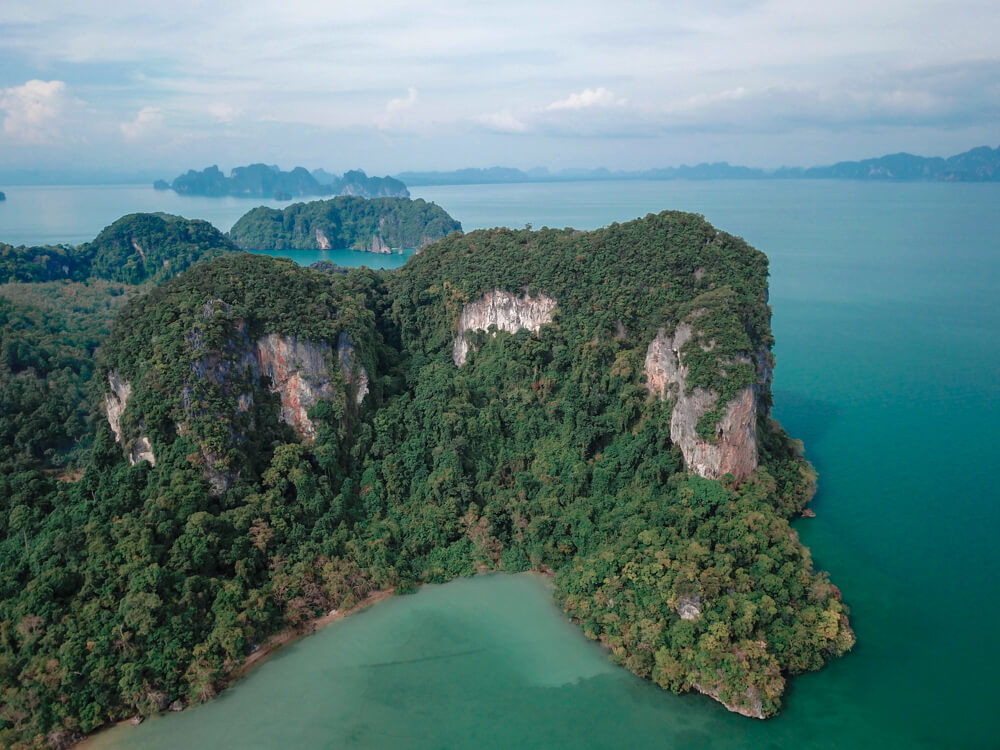
These are not the typical suggestions you probably see that feature Phuket and Koh Samui. I like the places that fly under the radar a bit more, just on the cusp of popularity. They’re amazing because of who they attract, the fact that they aren’t as crowded, but that they offer the same as, or even more than, their more-known counterparts.
El Nido, The Philippines : With beautiful white sand beaches and blue waters, El Nido has everything a beach lover wants. Don’t limit yourself to just the main island, as there are many small islands around it worth exploring. Just search around and book an island hopping tour , and you will find yourself swimming in the crystal clear water, with a chance to encounter whale sharks and manta rays. For a unique experience, you can also camp on the beach.
Siargao, The Philippines : An off the beaten path island that is becoming more popular, but is still a laid-back surf island. Locals will welcome you into their guesthouses with open arms for you to explore powdery, undeveloped nearby islands, local cafes, fish markets, and surf!
The Nusa Islands, Indonesia : You can easily hop from one island to another, which is what makes the Nusa Islands so appealing even for those that are short on time. Each island has a ton of beautiful beaches and things to do. Click here for an awesome Nusa Islands itinerary !
The Gili Islands, Indonesia : Another 3-in-1 package deal, you can hop from Gili Air, to Gili Meno, and to Gili Trawangan . Each island offers a slightly different vibe, but all three islands have one thing in common – gorgeous beaches.
Tonsai Beach, Thailand : Rock climbers, slack liners, and beach bums alike love this hippie paradise. Go there and enjoy, but don’t tell anyone about it, okay?
Koh Chang, Thailand : I love Koh Chang because it’s closer to Bangkok than the southern islands in Thailand, making it a great choice for those low on time, and it’s just as beautiful but less touristy. It’s also lovingly referred to as the ‘last cheap island’ in Thailand. Lonely Beach is the backpacker hangout, though the whole island is worth exploring. It is also, in my opinion, the best island in Thailand for solo backpackers.
Perhentian Islands, Malaysia : These two islands right next to each other are so darn beautiful, and there’s a nice backpacker vibe on the smaller island. Book ahead when heading here, as things fill up quickly. Internet is very limited on the island, which is perfect for those who are seeking for a break from social media and work emails. It’s also great for diving!
If You’re into Hiking
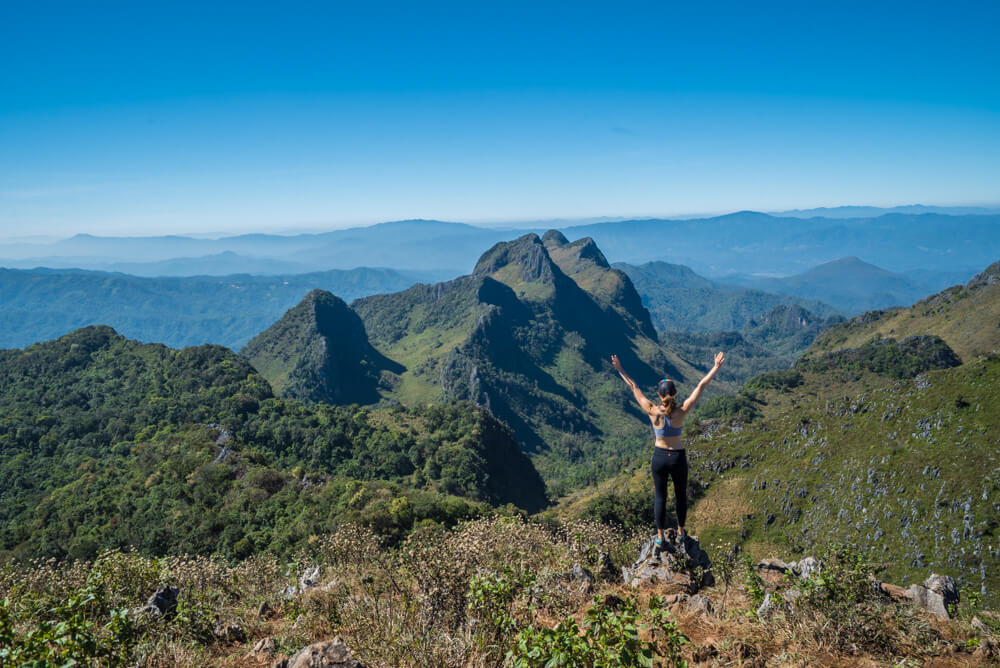
Mount Rinjani, Indonesia : This 3 day/2 night hike was a truly unforgettable experience for me. I recommend showing up on Lombok and booking directly with a tour operator there rather than organizing through a travel agent elsewhere in Indonesia or online. The first two days of the trek are not too challenging, though the last day gets tough, offering a sweeping view from the top of the volcano as a reward. Find the full guide to hiking Mount Rinjani here . I also highly recommend staying in Lombok and exploring the many waterfalls and beaches. It’s one of my favorites in all of Southeast Asia.
Mount Bromo, Indonesia : Mount Bromo is probably Indonesia’s most famous volcano. It sits at the eastern end of Java between Surabaya and Yogyakarta and is quite often lumped in as part of a tour heading out of one of those two cities. There are tons of tour operators selling Jeep tours to Mount Bromo, which is fun to some, but I did it independently and preferred it that way.
Kawah Ijen, Indonesia : Slightly more off the beaten path compared to Mount Rinjani and Mount Bromo, Mount Ijen is perfect for those who want to see something different (note: blue flames!). The volcano itself is beautiful but hiking in with the stars, getting up close to the blue flames and viewing the truly stunning sunrise are what makes Mount Ijen so unique and special.
Mount Kinabalu, Malaysia : Why not hike up to the highest mountain in Southeast Asia? I managed to hike to the top in one day , but since the earthquake, it is no longer permitted. Hikers are required to do a minimum of 2D1N compulsory climb these days. The hike is challenging, almost entirely straight up stairs, but the view on top is absolutely stunning. Given the weather conditions, hikers often make it close to the summit and have to turn back. If possible, leave some room for serendipity just in case you need to stay one more night for the bad weather to pass.
Doi Chiang Dao, Thailand : Doi Chiang Dao is Thailand’s third tallest peak, accessible via a fairly easy drive 1.5 hours north of Chiang Mai and surrounded by mountain after mountain in every direction. It’s a lovely hike worth including in your northern Thailand itinerary. Concrete information online was hard to find, so here’s my guide to hiking Doi Chiang Dao that has everything you need to know!
Kalaw, Myanmar : Many people visiting the popular Inle Lake choose to do a 3-day trek from Kalaw to get there. The trek takes you through valleys and small villages where you’ll stay each night, experiencing rural Myanmar life. The cost is cheap, the views are spectacular, and the trek is life-changing. There are no hot showers, no electricity, and no internet, just pure experiences with the nicest people on earth.
If You’re into Diving
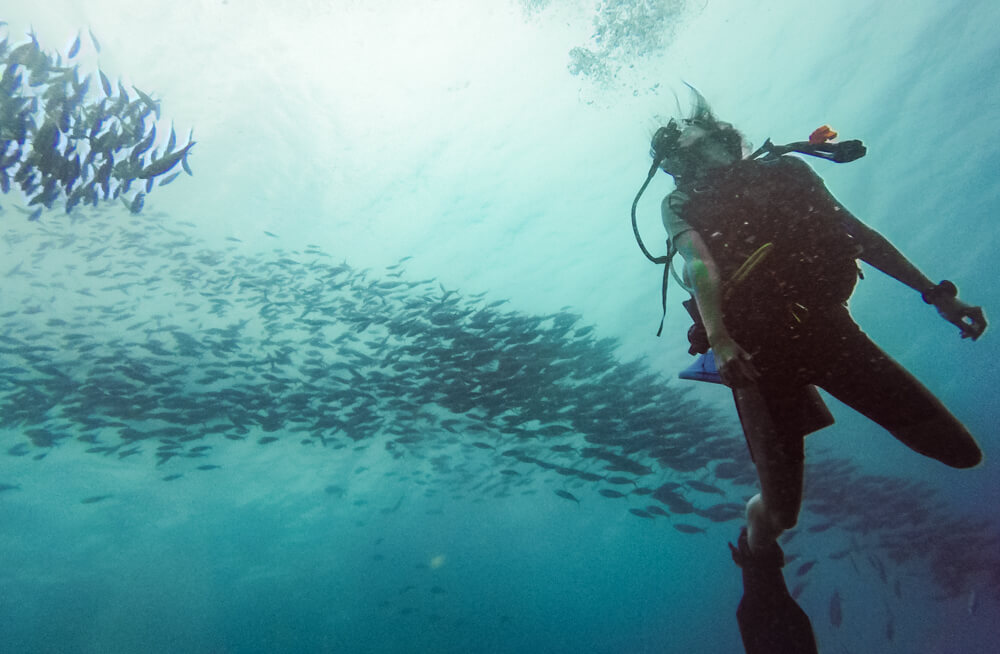
Raja Ampat, Indonesia : The liveaboard diving trip I did in Raja Ampat was the hands down best diving trip I’ve ever done in my life, and this is coming from a girl who has done more than 150 dives! The area was largely uninhabited, where I spent afternoons pretending to be a mermaid, and the time spent under water was incredible, with tons of diversity and abundance of sea creatures. If you want to see Manta rays, turtles, Wobbegong sharks, Mobula rays, Spotted rays, Black-Tipped Reef sharks and Groupers, go to Raja Ampat. It’s worth going the distance for.
Sipadan Island, Borneo : It’s called one of the best diving sites in the world for a reason. I love that they limit the area to only 120 divers per day, which really helps sustain the ecosystem and keeps the site beautiful and safe for both the sea creatures and visitors. Make sure you book at least 2 weeks in advance.
Coron, Philippines : This was another liveaboard diving trip I did in the Philippines and enjoyed thoroughly. If you love wreck dives, Coron is the perfect choice for you. I remember clocking around 10 wreck dives in 6 days!
Tioman Island, Malaysia : So underrated, but so good! The island is dreamy and beautiful, yet you won’t have to share it with too many other people. My guess is that since the restaurant choices are very limited, alcohol isn’t widely available, and you can pretty much forget about getting on the Internet, it keeps the crowds away.
Komodo, Indonesia: If Raja Ampat and Sipadan take the #1 spot for the best diving I’ve done, then Komodo is a very, very close second. The soft corals are colorful and gorgeous and it’s full of sea turtles and the occasional Manta ray as well. Plus, most liveaboard trips combine an excursion to see the Komodo dragons as well.
If You’re Seeking Spirituality
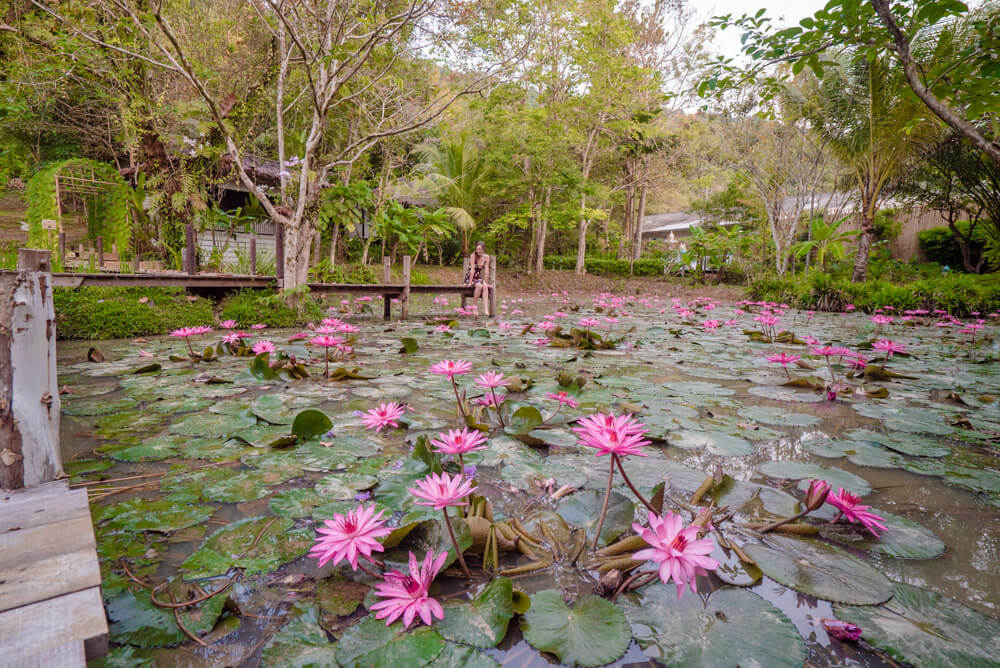
Chaiya, Thailand : I did a 10-day silent meditation retreat at Wat Suan Mokkh, Chaiya district, located in Surat Thani province, close to the popular Koh Samui, Koh Phangan, and Koh Tao. The retreat takes place at a Buddhist monastery in the forest where the attendees don’t speak, use technology, or even read books. They just meditate. Held once a month (from the 1st – 10th), Wat Suan Mokkh is a beautiful place for those who are into spirituality and meditation.
New Life Foundation, Thailand : Though this is more of a place to live and volunteer for a month or longer, particularly for those who are stressed out and just need a little vacation from everyday life, they do hold retreats here from time to time. I attended a silent meditation retreat at the center and found it to be more comfortable and an overall easier experience than Wat Suan Mokkh, though the two are hard to compare as they’re so different. You can read more about New Life here .
Bali, Indonesia : If you’re looking for a yoga retreat, Bali is the epicenter of such things in Southeast Asia. Each month all over the island there are tons of retreats to choose from that focus on wholistic wellness, raw food diets, tantric yoga, and a wealth of other options. You can find them on this booking engine . If you want something a bit more relaxed and remote, look at the Nusa Islands , which are just a 30-minute ferry ride away from Bali.
Siquijor Island, Philippines : The mystical island is full of healers and witches. If you want this experience, the first thing to do is talk to a local if you can. See if you can get him or her to bring you to a legitimate shaman. I spoke with another traveler who did a smoke clearing ritual in the middle of the island with a folk healer, which he gave me a moderately excited review of. You can find them here if it interests you.
If You’re into Wildlife
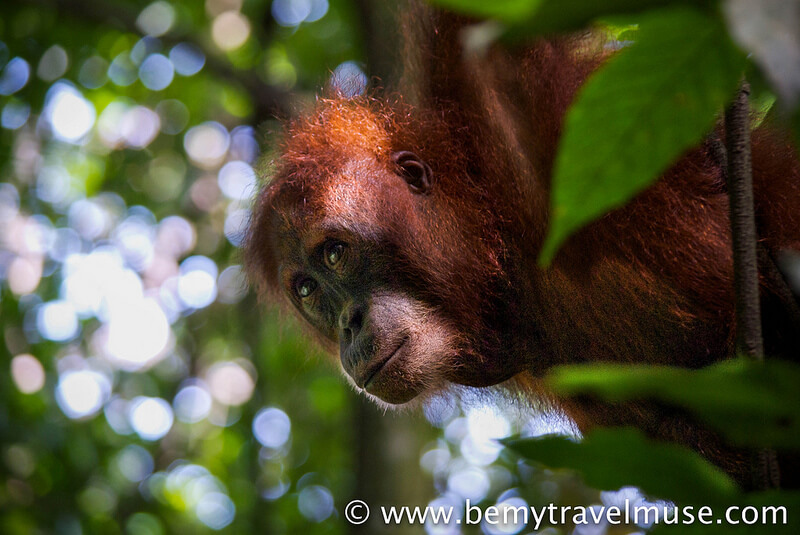
Chiang Mai, Thailand : Elephants are one of the icons of Thailand. Many visitors are excited about interacting with them, but sadly, it has resulted in unethical businesses that involve torturing wild elephants to tame them for entertainment purposes. It’s our responsibility, as tourists, to make sure we’re putting our money into the hands of programs that make their lives better. Elephant Nature Park in Chiang Mai is a highly reputable sanctuary for rehabilitated elephants. If you want to play (feed & bathe only, no riding) with elephants ethically, I recommend checking it out.
Sabah, Borneo: Borneo is a great place for some adventure time deep in the jungle. Danum Valley Conservation Area is a beautiful place known for its beautiful primary forest and wildlife experience. For an experience that will remind you of the Amazon in Peru , check out Lower Kinabatangan River. Finally, Deramakot Forest Reserve is wonderful for many reasons – it is in accordance with good forestry practices, you will have the opportunities to see Pygmy elephants, bearded pigs and orangutans.
Komodo National Park, Indonesia : I had a close encounter with dragons in Komodo . They are the world’s largest, bloodthirsty lizards that roam freely on Rinca Island. This is also the only place on Earth that you can see them, so if you find yourself in Indonesia, be sure to check them out. Other than the Komodo Dragons, you may also chance upon the manta rays, sharks, turtles, and dolphins if you dive!
Bukit Lawang, Sumatra, Indonesia: For an even more authentic orangutan experience, head to Sumatra. I just loved the little jungle town of Bukit Lawang, accessible via Medan, for hanging out, tubing down the river, and of course, jungle trekking to see the orangutans.
If You’re an Adrenaline Junkie
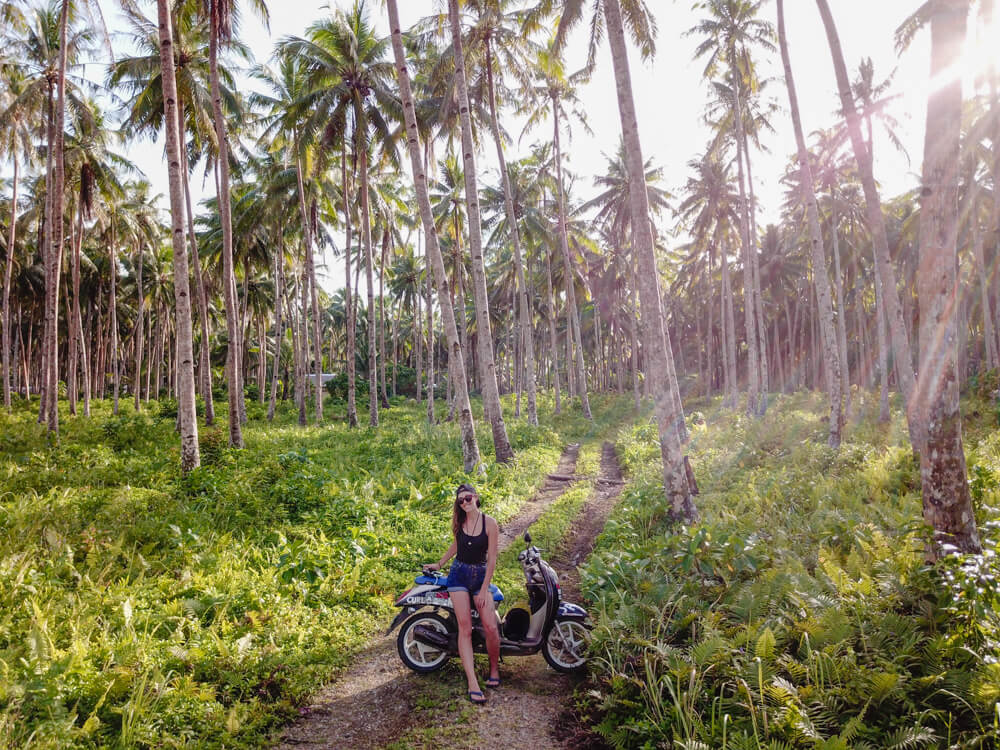
Cebu, Philippines : Many people rave about the Kawasan Falls tour, for a good reason! It’s a thrilling day trip around the area with canyoneering, cliff jumping, jungle trekking, and swimming on the docket. Your experience ends at Kawasan Falls, a picturesque waterfall that plummets into the turquoise lagoon below and has quickly become an instagram favorite. When you see it, you’ll understand why!
Vang Vieng, Laos : With strict rules and regulations imposed on the once deadly tubing that was notoriously popular among backpackers, the activity is now safer and just as fun as before. Other than tubing, kayaking and rock climbing are also popular in that area.
Gibbon Experience, Laos: If trekking and ziplining through a lush jungle and staying in a treehouse is on your radar, check out the Gibbon Experience in Laos. Brochures can be found in almost all hostels, so you just have to ask! It’s also possible to book online .
Country Motorbiking in Vietnam or Laos: If you are comfortable on a motorbike, take a road trip! You get all the freedom in the world, and it’s a great way to experience Vietnam from north to south (or visa versa) or to explore Laos’ Bolaven Plateau, which is basically waterfall heaven.
If You’re into Off the Beaten Path Adventures
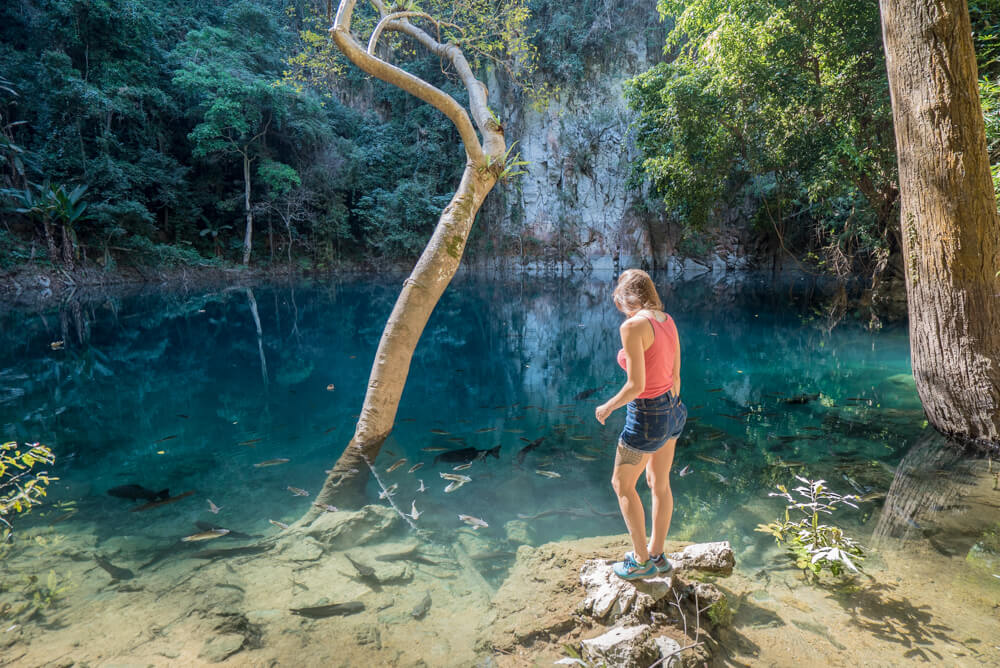
Myanmar: Myanmar has only decided to open up its door to tourism a little 6 years ago. The locals are still getting used to seeing foreigners, and traveling around can be quite challenging and confusing. However, this is a paradise for those who are looking for a journey in Southeast Asia that’s off the beaten path. Just look further from the popular spots like Yangon and Inle Lake, talk to the locals (many young locals are receiving linguistic education from volunteers, and they are encouraged to practice their English with tourists! Just be friendly and respectful), who will be happy to show you around, rent a bike if you are comfortable on one and just ride away. Check this itinerary for the best spots .
Nong Khiaw, Laos : Though only a 4 hour bus ride away, Nong Khiaw is often hidden in the shadow of Luang Prabang’s popular waterfalls and backpacker area. It is a quiet, laid-back village with just a few guesthouses lying around. There are a few hills that make for amazing sunrise/sunset spots, and if you want to go even further, take a 2 hour walk to another village, Huay Bo, for a rustic, wholesome overnight stay with the locals. You’ll wake up to the sound of roosters, walk around a small village with kids running around, women making Laos liquor, and men working away in the fields.
Lampang, Thailand : Lampang is a northern province that is fairly popular among the locals, but not so much with the foreigners just yet. When I did a road trip there I found an emerald lake and had it to myself, until a small group of local cyclists came. I also hiked up to Wat Chaloem Phra Kiat, Thailand’s floating pagodas , and again, had the place mostly to myself except for a few local tourists. What’s keeping tourists away from these spots is the accessibility, but if you are considering renting a car, you will not have any problem getting there.
I gotta say it’s not easy putting this together, there’s just so much Southeast Asia has to offer! But I hope the itineraries are helpful to you, and if you need more information about each of the Southeast Asian countries, check out the destination page , where I’ve included the essential information, accommodation guides, transportation tips, top things to do, and all of the blog posts from each country. Enjoy the journey, and comment below if there’s any other places in Southeast Asia that you think I should visit next!
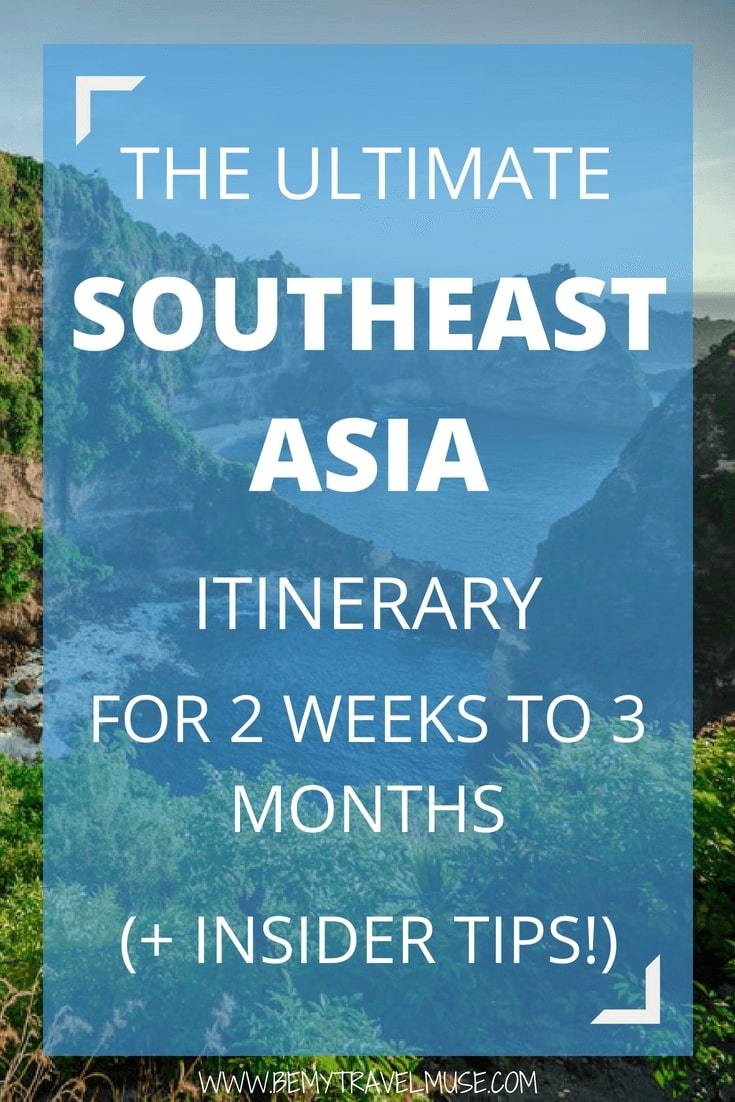
What to Pack for Backpacking in Southeast Asia
Solo female travel in southeast asia: everything you need to know, what 6 months of traveling in southeast asia cost me, leave a reply cancel reply.
Your email address will not be published. Required fields are marked *
Save my name, email, and website in this browser for the next time I comment.
subscribe to our newsletter
This site uses Akismet to reduce spam. Learn how your comment data is processed .
06/17/2018 at 9:05 pm
Great overview of traveling in Southeast Asia! I have a questions for you. If you could ONLY go back to one country, which one would you choose?
Kristin says
06/19/2018 at 9:31 pm
In Southeast Asia? I’d pick Indonesia because it’s so huge and diverse.
Renuka Walter says
06/18/2018 at 7:30 am
I’m amazed! I’m always looking for a trip somewhere in Europe, but I think I should think about planning a trip in Southeast Asia. Lovely pictures!
06/18/2018 at 10:06 am
You have clearly put a ton of effort into this post, very impressive. You are to be commended and I will use this for any travel I do one day in SE Asia, I promise. The beauty of it is in my case I might be restricted to a few countries and limited time so this will help me immensely in planning a custom itinerary. You seem to really have covered your bases, tapped into years of past posts, videos and personal experiences. A beautiful, organized collage. The only thing I could possibly add to this for those who, in addition to outdoor, solo adventure, like shopping binges along the way is that Kuala Lumpur is ranked 4th in the world by CNN as the best city to shop :). Three of the 10 biggest malls in the world are there, they say at least. I’ve heard Bangkok is pretty good too. I don’t know if this is really an addition to this, but a side note :). As another interesting side note: There is a ski “resort” inside a megamall in Penang, Malaysia called “Snowland” or “Snowland at Megamall Penang”. It looks like fun. According to one site I found, it is fun for those who have never done it before and drops 46 meters and has 6 snow machines which keep it at -5 degrees C in the indoor arena, so it feels real too. Have you ever heard of it? There’s also “SnowTown Saigon” but I think that is more for kids and there is a small ski slope for training (it is warmer though, 10-15C). I found these when wondering about snow/skiing in SE Asia and found “snow” here :). Keep up the fine work you are doing!
06/19/2018 at 9:30 pm
There’s a ski resort in Malaysia?! Wow! Never heard of it until now!
09/23/2018 at 1:39 am
I love this post! I’m going to be in Southeast Asia with my boyfriend for 1,5 months this November and December. Though we’d be considered typical backpackers, being young, on a budget and traveling with a backpack (obviously), we are less into partying and more into exploring. We thought about following route:
Week 1 Starting in Hanoi and experience it for a few days Heading over to Chiang Mai, exploring Northern Thailand (including Wat Chaloem, Doi Inthanon, maybe Pai and the Elephant Nature Park)
Week 2 Traveling to Cambodia and taking a few days to visit Angkor Wat and maybe Sihanoukville Flying to Bangkok
Week 3 Exploring Bangkok Doing some island hopping in the south of Thailand
Week 4 Heading over to Kuala Lumpur for a few days Flying to Singapore and do some sightseeing
Week 5 (and half of Week 6) Bali Chill-Out (maybe exploring Nusa Penida)
I am afraid this could be to strict and fast-paced, but we don’t want to miss out on something. Would you recommend skipping Taiwan, which we want to visit before starting in Hanoi, to have one extra week in SEA (maybe for a whole 2 weeks in Bali and another few days in Northern Thailand)? Or skipping Kuala Lumpur for a few days extra on the islands in South Thailand?
Thanks and keep up the good work!
09/23/2018 at 5:49 pm
I would recommend spending more time in fewer countries and then having looser plans while you’re there. I tend to burn out when I’m moving so fast.
Rickey Masters says
12/04/2018 at 11:52 am
where can you go as a person with a hip disability. I am unable to backpack but can ride motorbikes. I understand my limitations but am eager to make 1 trip to as many countries as I can. time is not a limitation and money would be subject to a medium budget. Thank you for your knowledge and help
12/04/2018 at 11:48 pm
Anyone here have suggestions? I can’t answer from personal experience but I’d love to find out as well!
07/10/2019 at 2:31 am
George Town, Penang Island ‘s d food capital of Malaysia ! Kuala Lumpur pales in comparison..
Carlos says
11/27/2019 at 6:20 pm
Great article, the only thing I miss… where to go if you love to party!
11/28/2019 at 8:06 am
Pretty much everywhere! I’m not a party person but the Thai islands, Cambodian coast, most of the major cities and tourist towns will all have party options.
Siim Kuusik says
01/17/2020 at 12:41 pm
As for me and my girlfriend Malaysia so far has been the best country in Southeast Asia so far, because they have 50% Malaysians 30% Chinese and 20% Indians living there, which means they have the BEST foods there in ONE country. And it is cheap!
Ava Brown says
02/09/2020 at 8:26 pm
Nice blog you have here with unique and different thoughts!

Ultimate SOUTHEAST ASIA Travel Guide
Southeast Asia is a fascinating part of the world that offers beautiful islands, beaches, lush jungles, unique wildlife, tasty food and intriguing culture. This Southeast Asia travel guide is designed to uncover some of our favorite places and things about this region and help you plan your own trip to this unique part of the world.
Defining Southeast Asia can be referred to as the region that resides between Asia and Oceania . It is made up of eleven countries including Brunei, Cambodia, East Timor, Indonesia, Laos, Malaysia, Myanmar, Philippines, Singapore, Thailand and Vietnam.
These countries are bordered by China to the North, Australia to the South, the Andaman Sea to the West and the Pacific Ocean to the East.
We’ve spent more time in Southeast Asia than we care to admit, thinking hard on it we’ve spent no less than 9 months traveling the region over multiple trips at the time of publishing this guide.
We’ve visited across all seasons and while we haven’t been everywhere or to every country (yet!), we’ve done enough leg work to offer you some useful insight on travel to Southeast Asia.
Destinations
Southeast asia travel: quick tips, don’t visit southeast asia without:.
UNIVERSAL TRAVEL ADAPTER

GET A GUIDEBOOK

REUSABLE WATER BOTTLE

SOUTHEAST ASIA BUCKET LIST
Philippines island hopping.
Hopping islands in Coron is one of the best things to do in the Philippines or even Southeast Asia for that matter. You’ll experience white-sand beaches and turquoise waters set against green island interiors. It’s idyllic and one of our favorite places in the world.
DISCOVER THE ANGKOR TEMPLES
One of the most impressive ruin sites we have ever seen is the Angkor Temple Complex in Cambodia. We’ve even been twice! Angkor Wat is the most impressive but we enjoy checking out the temples that have been reclaimed by the jungle too.
SEE WILD ORANGUTANS
Southeast Asia is the only place in the world where Orangutans still exist in the wild. It is possible to track orangutans in Sumatra , Indonesia and Sepilok Borneo . Both are off the beaten track but worth the effort. We’ve seen orangutans in both places!
MORE THINGS TO TRY IN SOUTHEAST ASIA
There is no shortage of great things to do in Southeast Asia during your visit and the biggest problem you’ll face is fitting them all into your itinerary.
Each country has its own offering and unique things to check out during a visit, so be sure to look at our country guides once you decide where you’re itinerary will take you.
SPEND SOME TIME IN BANGKOK: (Thailand) Bangkok is the first city in Southeast Asia that we ever set foot in and that was back in 2010 when we went on our honeymoon! We’ve been back to the city 7 times since then and always recommend it to people who want to visit the region. It’s a huge, sprawling megacity with as much modern convenience as you’d find in any major western city. Combine that with the amazing food, Thai culture and abundance of temples and you pretty much have the perfect city.
TOUR TEMPLES IN CHIANG MAI: (Thailand) Heading north is a popular part of most people’s Thailand itinerary and Chiang Mai is worth the effort. The heart of the city lies within a wall with a surrounding moat and touts a series of beautiful temples to explore.
GET A BAMBOO TATTOO: (Thailand) This isn’t for everyone, but if you’ve thought about getting a bamboo tattoo in Thailand , just do it! Both of us did and have nothing but positive things to say about the whole experience.
VISIT THE PHI PHI ISLANDS: (Thailand) One of the most beautiful chain of islands in the Andaman Sea, the Phi Phi Islands are worth a visit despite the harsh backpacker vibe they portray. Yes, backpackers flock here, but there are also plenty of nice resorts to stay at and other islands to tour during the day that are nearby.
TEMPLE HOP IN BAGAN: (Myanmar) (England) Alongside the Angkor Temples in Cambodia, Bagan is the most impressive temple complex in Southeast Asia. Covering 40 square miles, this complex offers up impressive temple structures from three distinct time periods. Our biggest piece of advice? Give yourself at least 3 days to see the best it has to offer.
UNWIND IN PENANG: (Malaysia) The island of Penang, which sits off the western coast of Malaysia, may just be our favorite island in Southeast Asia. It’s a place that blends tropical jungles with white sand beaches and old-world history with Asian culture. It has a little bit of everything and we that is why we love it. From the street art and amazing good in Georgetown to the Monkey beach trek in Penang National Park , we’d visit a hundred times over and never be bored.
TOUR KUALA LUMPUR: (Malaysia) We won’t lie, we have a love, hate relationship with Kuala Lumpur but that doesn’t stop us from going back. The city has a lot of offer travelers, including a delicious food scene, great architecture and the famed Batu Caves just outside the city.
LEVEL WITH HISTORY IN PHNOM PENH: (Cambodia) Travel is so much more than lying on beaches and touring sites, it’s a valuable window into the past too. If you find yourself in Phnom Penh it is worth your time to learn more about the Khmer Rouge genocide that happened in parallel with the Vietnam War. The museums and killing field sites are sobering but a necessary part of learning world history when you travel.
DO THE BUFFALO RUN IN VIETNAM: Starting in Hanoi, the Buffalo Run tour takes you off the beaten track and deeply explores the very best of Vietnam, north of the demarcation line. This is not a well-traveled path, so you’ll feel like you’re the only one there. You’ll stop off in places like Cuc Phong National Park, Trang An, Phong Nha, the DMZ, Vinh Moc Tunnels, Hue and Hoi An.
CRUISE AROUND HALONG BAY: (Vietnam) One of the best things to do in Vietnam is to cruise Halong Bay and for good reason, it’s gorgeous! Massive limestone karsts grow out of bright green seas paired with island accommodation and white sand beaches. It’s a great way to unwind, especially if you have jetlag from the flight to Southeast Asia.
WATCH WILDLIFE IN THE AMAZON OF THE EAST: (Borneo) We are total suckers for a thick rainforest and Borneo delivers. The island is literally known as the Amazon of the East and features some of the most incredible primary rainforests you can find on the planet. With that comes some incredible wildlife viewing, it’s a birders paradise with more than 688 resident and migratory species. You can also see the endemic Proboscis Monkey, orangutans and if you’re really lucky some pygmy elephants.
GO SCUBA DIVING AT SIPADAN ISLAND: (Borneo) If you’re a scuba diver then you likely already know about Sipadan Island . It is arguably the best place in the world for diving and we do not disagree. Pair it with the incredible muck diving and manta cleaning stations around nearby islands like Siamil and Mabul to make the ultimate dive trip in Southeast Asia.
TRACK KOMODO DRAGONS: (Indonesia) There is only one place in the entire world where the world’s largest reptile, the Komodo Dragon , still lives in the wild. This is the Komodo Islands in eastern Indonesia. Not only are these islands absolutely stunning, seeing the dragons is a once in a lifetime experience too. It’s not possible to stay on the islands, so be sure to book yourself a Sailing Komodo Island tour when you arrive in-country.
GET OFF THE GRID IN RAJA AMPAT: (Indonesia) Located off the coast of the remote island of Papua, Raja Ampat is part of Indonesia’s West Papua province. This place is a straight-up paradise. It offers insane jungle hiking through untouched forests, island views, rich culture and some of the most pristine coral reefs we have ever seen. It’s hard to get to and expensive but oh so worth the effort.
EXPLORE BALI: (Indonesia) If you’ve never been to Indonesia before, we’d happily recommend Bali be added to your itinerary. It is one of those Southeast Asia classics that shouldn’t be overlooked. From the beaches in Kuta, the islands of Nusa and the rice terraces that surround Ubud , there are plenty of things to do in Bali during a visit.
CATCH A SUNRISE AT BOROBUDUR TEMPLE: (Indonesia) Another temple, I know, but this one is spectacular and worth the visit. Catching a Borobudur sunrise is almost otherworldly and worth the 3am wakeup call to see buddha silhouettes against volcanos erupting against the sunrise. The temple is located on Java island, not far from Yogyakarta.
FOODIE BUCKET LIST
Southeast Asia is a foodie’s paradise, and the region is an incredible palace to eat your way around. In fact, a big part of Southeast Asia travel is the food, so don’t be afraid to try the local stuff!
Thai cuisine needs no introduction, and Malaysian food is possibly the most underrated in the world. There are lots of curries and noodle dishes, with a great mix of Malay, Chinese, and Indian cuisine to try.
Burmese food involves more curry and noodles, while Vietnam is famous for Bahn Mi and Pho . Indonesia has its fried rice and rendang. Singapore is home to some of the world’s only Michelin-starred street food stalls !
SOUTHEAST ASIA FESTIVALS
Southeast Asia is packed with events and festivals throughout the year, and every country has unique celebrations to offer visitors.
In Vietnam, the biggest celebration is Tet , the New Year in February. Chinatowns everywhere celebrate Chinese New Year around the same time.
In Thailand, you can visit the famed Songkran , a water festival that brings in the Thai New Year in April.
In Bali, you can find processions and parades throughout the year, while in March, the Day of Silence is a unique local occasion to be part of.
The Philippines has more local festivals than anywhere else, a throwback to their Spanish ancestry. The major ones are Sinulog in January and Holy Week before Easter.
Pack like a pro on your trip to SOUTHEAST ASIA!
Popular regions in southeast asia, mainland west.
Thailand is a Southeast Asia travel destination that needs little introduction. The Land of Smiles is home to beautiful islands in the south, rugged mountains in the north, and of course, the thrilling capital, Bangkok. There’s sun, there’s sand, there’s culture, and there’s great food. Myanmar is little visited compared to its Southeast Asian neighbors, but the county recently began to open up to tourism and saw a boom when it did. Myanmar is unlike anywhere else in the region. Explore ancient Buddhist pagodas, visit the cultural climes of Mandalay and see the fading colonial ruins in Yangon .
Malaysia and Singapore are home to the best food you could eat when you travel to Southeast Asia. Visit the foodie stalls and white sand beaches of Penang , and the modern sights of Kuala Lumpur before heading south to Singapore – one of the most modern and exciting cities in the world.
MAINLAND EAST
The eastern mainland is made up of Laos , Cambodia , and Vietnam . Aside from their shared French-colonial history, these countries couldn’t be more different. Vietnam is the rising star of the region, offering an epic adventure if you travel between Hanoi and Ho Chi Minh City. See the scars of the Vietnam War and explore the magnificent nature, scenery, history, and delectable food that this modern nation offers. In Cambodia , a trip is inseparable from the harrowing past ; you’ll learn about the Khmer Rouge as soon as you land in the capital. You can visit the ruins of Angkor Wat or head to the beaches of Sihanoukville. Laos is untouched, but who knows how long it will stay that way. One of the poorest and most rural countries you could visit when you travel to Southeast Asia, Laos is also the most unexpected.
Borneo is one of the world’s largest islands and this unique destination is home to some of the best rainforests on the planet. Borneo offers hiking, mountain climbing, beaches, and diving . The island is divided between three countries: there’s Malaysian Borneo in the north and tiny Brunei. The south is Kalimantan, an Indonesian province.
THE ISLANDS
If you’re looking for island hopping opportunities, snorkeling, diving, and diverse culture, then Indonesia or the Philippines are the best countries to include in your Southeast Asia travel itinerary. Indonesia has Bali , one of the region’s most popular islands, but there’s also the culture and history of Java, relaxation, and slowness on Lombok , the wild nature of Sumatra or Komodo , or the beautiful marine life of Raja Ampat . The Philippines is beautifully diverse, home to the highlands and rice terraces of the Cordilleras, but also the rugged islands of Palawan , including the stunning and popular Coron and El Nido . We will not lie, Indonesia and the Philippines are our two most beloved countries in Southeast Asia. We’ve been back to visit them both, multiple times, and it’s the first place we head each time we return to the area.
SOUTHEAST ASIA TRAVEL BUDGET
Setting a budget for travel to Southeast Asia is highly dependent on your travel style. It is possible to visit just about anywhere across the continent on any budget and still have a great trip. That said, you can make your trip as basic or as luxurious as you desire.
To help you set your budget, we’ve included some base range price estimations for Southeast Asia travel. Of course, keep in mind that prices can fluctuate based on seasons, availability and festivals.
If you’re looking to travel on a budget, be sure to check out the 12 Tips on How to Travel Cheap before you start planning.
ACCOMMODATION: Accommodation is good value when you travel to Southeast Asia. Guesthouses, hostels, and homestays will cost between USD 10 and USD 20 per night (less if you don’t care about the cleanliness). Private rooms can be between USD 20 and USD 50. Above this price range, you can find more luxurious accommodation . Popular resort destinations in Thailand or Bali will charge USD 100 or more per night for fancier hotels.
FOOD: Food is incredibly inexpensive in Southeast Asia; you can find local eats for as little as USD 1 per plate in most countries. Prices go up in touristy destinations (we’re looking at Thailand and Bali again) and western-style restaurants. You still won’t often pay more than USD 10 per meal , however.
TRANSPORT: Local transport is affordable across Southeast Asia, and international transport is equally cost-effective. Buses and trains vary in standards and prices. Local transport will be just a few dollars for day-long journeys, but you pay more for comfort. Mopeds can be hired for between USD 5 and USD 10 per day. Budget international flights can be as low as USD 30 if booked in advance for a two-hour flight.
ACTIVITIES: Activities vary in cost from country to country but expect to pay between USD 30 and USD 70 for a day of diving . You can enjoy a boat tour for around USD 30 a day, or hire trekking guides for a similar price. For the most part, activities are very cost-effective in comparison to western prices.
20 USD PER DAY
Living in hostels, lounging on beaches, and eating local food. If you’re looking to include many destinations in your Southeast Asia travel plans, or want to enjoy lots of day trips and activities, raise that budget to USD 50.
50-100 USD PER DAY
Midrange travelers will be able to enjoy the comforts of private rooms and guesthouses, taxi rides, and tourist buses. You can enjoy street food, restaurants, and plenty of activities. Your money will go far on this budget and you won’t miss much.
200 USD + PER DAY
Luxury travelers can get a lot for their money when they travel to Southeast Asia. Stay in premium resorts in Bali, Borneo, or the Thai Islands. Enjoy restaurant-quality food, private day tours and drivers, and plenty of spa treatments!
WHERE TO STAY IN SOUTHEAST ASIA
Below you will find some of the places we have stayed during our travels in Southeast Asia. These are individual properties that we enjoyed and would recommend to other travelers.
For more in-depth information, be sure to check out the following articles:
- Where to Stay in Bangkok: Best Districts & Hotels
- INAYA Putri Bali Nusa Dua: Resort Review
PLANNING TO BACKPACK SOUTHEAST ASIA?
Southeast Asia is an extremely popular destination for backpacking because you can do a lot throughout the region on a very small budget. We’ve experienced this region on both the high end and budget side, including spending 6 months backpacking during our 2 year RTW trip .
If you’re looking for some breakdowns on how we did this, check out the overviews below.
HOW TO GET AROUND IN SOUTHEAST ASIA
If you’re traveling around mainland Southeast Asia, you can cross most borders overland. You could travel all the way from Hanoi to Singapore overland using buses and trains. The transport varies from cheap, slow local buses to faster, luxury sleeper buses and trains.
The same applies to the Philippines and Indonesia, although you’ll need to combine buses with boats. In the Philippines and Indonesia, you’re often better off flying, as destinations are spread over large areas. If you have time, you can take inter-island ferries.
If you’re visiting Borneo, you’ll need to fly in. You can travel by bus between major cities and destinations in Malaysian Borneo and Brunei, but Kalimanatan is much less developed and more challenging to travel around.
Most land borders into Myanmar are off-limits, so you need to fly into Yangon. From there, you have bus and train connections across the country.
BUS: If time is on your side, there are many instances where taking the bus will be the best option for getting between places. There are usually two classes operating the popular routes, this includes tourist buses and local buses. Tourist buses are usually comfortable coaches with AC and WIFI. Local buses will be rough and not have AC. Both will get you where you need to go.
FLIGHTS: Thanks to budget airlines like Air Asia, Southeast Asia is incredibly well served by low-cost carriers offering regular flights and cheap fares. Major cities, and increasingly, many more regional airports, have connections between one another. In most cases – particularly over longer distances – flying is cheaper than taking the train or bus.
TOP SOUTHEAST ASIA TOURS
Iconic thailand.
15 Days from Bangkok, Thailand Visits: Chiang Mai, Ayutthaya, Kanchanaburi, Khao Sok, Ko Samui, Krabi & Bangkok
EXPLORE VIETNAM
13 Days Hanoi to Ho Chi Minh City Visits: Hanoi, Halong Bay, Mai Chau, Hue, Hoi An & Ho Chi Minh City
DISCOVER SOUTHEAST ASIA
18 Days Bangkok to Siem Reap Visits: Bangkok, Chiang Mai, Luang Prabang, Hanoi, Halong Bay, Ho Chi Minh City, Phnom Penh & Siem Reap
WHEN TO VISIT SOUTHEAST ASIA
Southeast Asia is a vast area that sprawls over both sides of the equator. For the most part, you can expect countries to be hot, humid, and tropical when you travel to Southeast Asia – but this isn’t always the case.
The north of Vietnam is much more temperate and has cold winters, while the same can be said of Myanmar’s northern mountains. However, most areas you will visit during your Southeast Asia travel itinerary will have distinct wet and dry seasons .
North of the equator, the dry season is usually November to April. Most of Indonesia, however, has its dry season from May through to October. The dry season is the best time to explore Southeast Asia; there’s little chance of rain and thunderstorms, and the visibility if you’re snorkeling or diving is perfect.
Even in Indonesia, peak season is from November through to January, and tourist numbers and prices increase dramatically over the Christmas holidays. Try to travel in the shoulder seasons instead;, you might get a little rain, but you’ll escape the worst of the crowds.
For more in-depth information, check out:
Best Time to Visit Bali: Month by Month Breakdown
Best time to visit the philippines: month by month breakdown, inspiration for your next southeast asia trip, safety in southeast asia.
Southeast Asia travel is generally safe, even for first-time travelers (which is why it’s a popular backpacking destination). In touristy destinations, however, you do need to be super-careful of scams and low-level thievery.
This is especially so in places like Bali and Bangkok. On buses, try to keep your belongings close and safe, and on the party islands in Thailand, be careful! Take our advice and be sure you’re prepared. Check out 25 Essential Safety Tips for Travel
Each county has its own laws and customs, so read up before you cross the border. What goes in Thailand might not be so welcome in Malaysia. Some countries are Muslim, others Buddhist, and some Christian – it’s a diverse region!
For personal experiences, check out:
- 5 Reasons Why Bali Is Not the Paradise You Think It Is
- Culture Shock: Our First 24 Hours in Bali
SOUTHEAST ASIA TRAVEL: BOOKING RESOURCES
Southeast asia travel guide: related articles.
Looking for more info? Check out all the articles we’ve written on travel to Southeast Asia and start planning your dream trip.
What To Do in Chiang Mai, Thailand (18 Amazing Attractions, Festivals & Food)
24 amazing malaysia attractions you cannot miss, essential el nido palawan guide: what you need to know, ultimate philippines itinerary for 10 days, 2 weeks or 3 weeks, 21 incredible things to do in the philippines, 15 essential things to do in boracay, 15 stunning things to do in palawan, philippines, ultimate puerto galera, philippines guide: diving & beaches, busuanga island palawan: ultimate guide to the last frontier, culion island palawan: is this the next philippines hot spot, kayangan lake in coron: the philippines most famous photo spot, 15 incredible islands in coron you must visit in the philippines, 20 beautiful places in the philippines for your bucket list, what to wear in bali: the ultimate packing list, 15 awesome things to do in manila (itinerary for first time visitors), 15 best things to do in yangon, myanmar, 35 amazing things to do in southeast asia (across 7 countries), 25 epic & best places to visit in southeast asia, 21 epic things to do in bali.

Your Southeast Asia itinerary: 8 ideas for exploring the region
Book your individual trip , stress-free with local travel experts
- roughguides.com
- southeast-asia-itinerary
Plan your tailor-made trip with a local expert
Book securely with money-back guarantee
Travel stress-free with local assistance and 24/7 support
written by Rough Guides Editors
updated 30.03.2020
You can’t expect to fit everything Southeast Asia has to offer into one trip – or two or three or four, to be fair – and we don’t suggest you try. So, to help you start planning, we’ve put together eight ideas for your Southeast Asia itinerary from The Rough Guide to Southeast Asia on a Budget .
3. Laos and Cambodia
4. bangkok and northern thailand, 5. thailand’s beaches and islands, 6. singapore and malaysia, 7. indonesia, 8. the philippines.
For those taking a big, extended trip around the continent you could join a few together, but remember that the distances you’ll be covering can be vast. Plus, there’s lots to discover off the beaten track.
For a complete guide to exploring the region and up-to-date recommendations of the best hotels, hostels, activities and more, buy the full guide here .
Start in colonial streets of Hanoi (1), the country’s historical, political and cultural capital. Go for a sail around the famed natural wonders of Ha Long Bay (2), before heading to the northern hills to the ethnic minority villages orbiting Sa Pa (3).
Take the train down to imperial architecture of Hué (4), make a day-trip to the DMZ , then move south to charming Hoi An (5). Nha Trang (6) is Vietnam 's pre-eminent beach party town, whereas Mui Ne (7) offers great water-sports and sandy coasts with a more laid-back vibe.
Da Lat (8) is your gateway to the Central Highlands , and from here you can strike southwest to reach bustling Ho Chi Minh City (9). Once you've explored the city, travel to the Mekong Delta (10) where you can visit one of the region's floating markets, before finishing your trip on the island of Phu Quoc (11), a restful place perfect for beach bums and divers.
Kick-off in Yangon (1) for street markets and the glorious Shwedagon Paya , then go to Mawlamyine (2), Myanmar 's third largest city. Catch a boat to Hpa-an (3) before visiting one of the holiest Buddhist sites in the country, Kyaiktiyo (4).
Kalaw (5) is a perfect base for treks to ethnic-minority villages, and traditional life at Inle Lake (6) shouldn’t be missed either. Watch the sunset over Mandalay (7), then head northeast to stroll the botanical gardens at Pyin Oo Lwin (8).
Take the train across the Goteik viaduct to Hsipaw (9), an increasingly popular trekking base and finish with a hot-air-balloon ride over the awe-inspiring temples of Bagan (10).
Begin with the unmissable two-day trip down the Mekong River from Houayxai to Luang Prabang (1), the city of golden spires. Then its off to the stunning natural playground of Vang Vieng (2), before venturing to the country’s quaint capital, Vientiane (3).
Enjoy the pretty French-colonial lanes of Savannakhet (4) and explore the Khmer ruins of Wat Phou near Champasak (5). Set course towards Si Phan Don (6) to chill out for a few days in one of the four thousand islands scattered across the Mekong River. Catch a mini-bus to Cambodia for river dolphin watching in Kratie (7).
An easy bus ride takes you from Phnom Penh (8) to Siem Reap , where the world-famous temples of Angkor (9) beg to be explored. But if you’re feeling a little travel-worn afterwards kick back on the beach resort and offshore islands of Sihanoukville (10) or laze riverside in relaxed Kampot (11).
After immersing yourself in Bangkok (1), Thailand ’s frenetic and thriving capital, chill-out among the rafthouses and waterfalls of Kanchanaburi (2).
Rent a bicycle to explore the ancient ruins of Ayutthaya (3) and then make for the elegant temple remains in Sukhothai (4). To break free of the tourist route head to isolated Umphang (5), where the surrounding mountains are perfect for trekking.
Chaing Mai (6) is always a backpacking favourite, but an amble through the arty night markets and excellent live-music bars of Pai (7) shouldn’t be missed either.
Commence among the old-world charms of Thailand 's Phetchaburi (1), then take a trip to the paradisiacal islands of Ko Tao (2) and Ko Pha Ngan (3) for raging moon parties or a detox.
Trek through the jungle in Khao Sok National Park (4) – one of the most bio-diverse places on the planet – and as you move further south, consider a stop in the slightly ugly tourist village of Ko Phi Phi (5) for undeniably fun all-night parties, snorkelling and diving.
Continue south to the relaxed island getaway of Ko Lanta (6), before winding this itinerary down in the pockets of paradise still remaining in Ko Lipe (7) and the stunning Ko Tarutai National Marine Park nearby.
Singapore (1) is an easy introduction to Southeast Asia with its array of tourist-friendly pleasures. But move on to Melaka (2) for a fascinating mix of cultures and an ideal first stop in Malaysia .
Kuala Lumpur (3) is a must, as is former-colonial George Town (4), with its thriving food and arts scenes. Next, make some time to relax on the beaches of the Perhentian Islands (5) before heading to the rainforests of Taman Negara National Park (6), before catching a ride on the jungle railway to Kota Bharu .
Attractive Kuching (7) is an ideal base for visits to the Iban longhouses , and a journey along the 560km Batang Rajang (8) river into the heart of Sarawak is unforgettable.
Nature and adventure buffs alike will love Gunung Mulu National Park (9), Kinabalu National Park (10) and the wildlife outside of Sandakan (11). Finish this itinerary among the teeming marine life of Pulau Sipadan (12), one of the top dive sites in the world.
There’s plenty to discover by starting in Sumatra ’s Bukit Lawang and Danau Toba (1), the famous orang-utan centre, soaring volcanoes and island retreats among them.
Take time to explore Indonesia ’s capital, Jakarta (2), before moving on to Java cultural heart: Yogyakarta (3), the best base for the temples of Borobudur and Prambanan . Take a pre-dawn hike up to the crater rim of still-smoking Gunung Bromo (4), adventure the many wonders of Hindu Bali and hop over the Lombok (6) and the Gili Islands for adventures in paradise.
Enjoy close encouters with Komodo dragons in Komodo and Rinca (7) before heading to the mountainous landscapes of fertile Flores (8). Finish up on Sulawesi , immersed in the flamboyant festivals and fascinating culture of Tanah Toraja (9).
Start by soaking up the compelling energy of Manila (1), a convenient gateway to some of the country’s more inaccessible areas.
Check out the shipwrecks and prehistoric landscapes of Palawan (2), before you pass through Cebu city (3) on your way to Camiguin (4), a small volcanic island home to a bohemian arts scene and some amazing adventure activities.
Surfers flock to the acclaimed reef breaks of Siargao (5), while the captivating sunsets and limited electricity at both Malapascua and Bantayan (6) typifies island living at its best.
Boracay (7) also shouldn’t be missed, home to some of the world’s most beautiful beaches and nightlife rivalling Manila . Conclude this itinerary in the cool mountain villages of the Igorot tribes in the Cordillera (8), nestled among jaw-dropping rice-terrace scenery.
- Nature & Wildlife
- Authentic Experiences
- Coasts & Islands
- History Culture Heritage
- National Parks & Reserves
- Off the Beaten Track
- Walking Hiking Trekking
- Boats & Sailing
- See & Do
Planning your own trip? Prepare for your trip
Use Rough Guides' trusted partners for great rates
Ready to discover tailor-made travel?
Get support from our local experts for stress-free planning & worry-free travels.

50 Essential travel tips for first time backpackers visiting Southeast Asia
- July 27, 2023
- curious goose
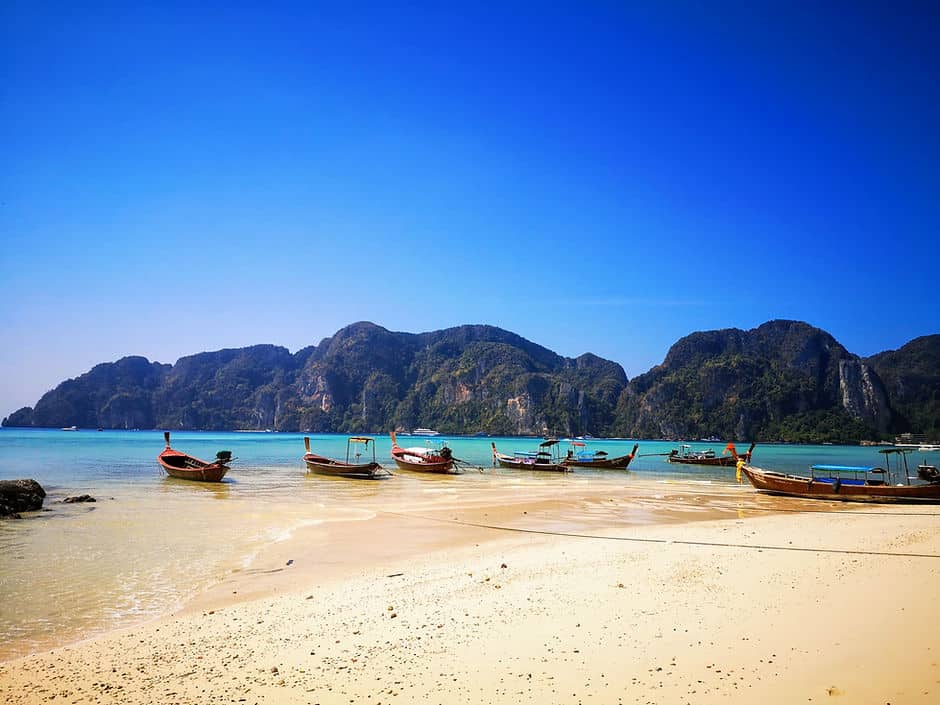
This post may contain affiliate links. I will receive a small commission if you use these links.
Make sure you read these essential tips for Southeast Asia to help plan your trip.
Southeast Asia is one of the most popular destinations for backpackers. It’s easy to see why – gorgeous sandy beaches, cultural temples, delicious food and bustling cities makes for an attractive mix. It’s also a safe and cheap place to travel, meaning that Southeast Asia is a great place for first time travellers getting to grips with backpacking and those on a budget.
Southeast Asia has been on my bucket list for years and in 2022, I spent 7 months travelling in Thailand , Vietnam , Cambodia, Malaysia and Indonesia. Based on my experience, I’ve put together 50 essential travel tips to help you plan your trip to Southeast Asia. These tips cover everything from what food and drink to avoid, to how to keep track of your budget while travelling and travel hacks to make life on the road easier.
These travel tips for Southeast Aisa will prepare you for a great trip and hopefully help to prevent you from getting into any tricky situations!
50 Essential travel tips for first-time backpackers visiting Southeast Asia
Practical information for travel in southeast asia, managing your budget and finances when travelling in southeast asia, top tips for getting around in southeast asia, food and drink in southeast asia, local cultures and traditions in southeast asia, travel health, packing tips.
- Lastly…things to remember when travelling
Travelling takes a lot of organisation and planning. Here’s a few hacks to help you have a smoother travel experience.
1. Get yourself a sim card as soon as you land
Often the best sim card deals can be found in the arrivals hall at the airport, with a ‘tourist sim’. I’d recommend getting a sim card as soon as you arrive in the country, especially if you are taking public transport from the airport / ferry / bus terminal to your accommodation. Most likely, you will be dropped off at a location in the centre of town (or at the side of the road as I experienced several times!) and having the internet to figure out where you are is very helpful.
2. Download an offline version of google maps before you arrive at a new place
Even if you have a sim card with data, you might not always have a signal to access the internet. Make sure that you download an offline version of google maps, covering the area you are travelling to. You might need to download several if the area you are travelling to is vast. Another handy tip is to ‘pin’ key locations onto your map, such as your accommodation, attractions, bus terminals and places to eat! That way, if you can’t access the internet you’ll still be able to find your way to key services and attractions.
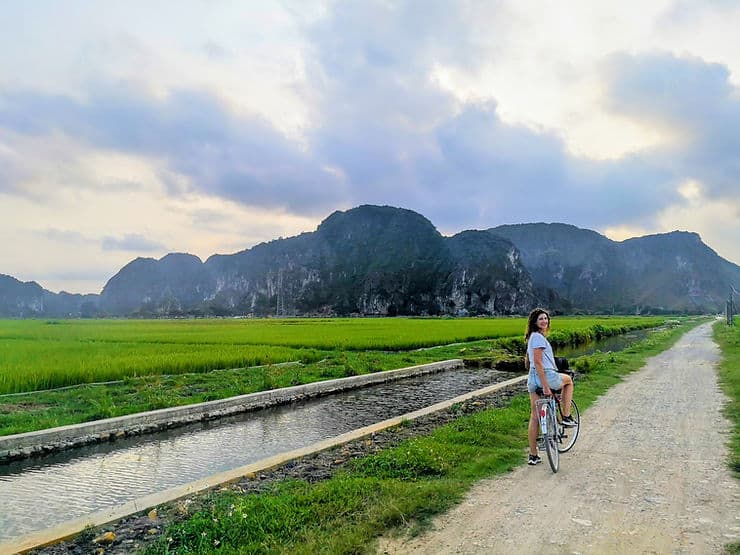
3. Screenshot or note down your accommodation booking confirmation and address
Don’t rely on being able to access the internet to retrieve the information of your accommodation. You’d be surprised how many travellers get off a bus in a new town and don’t know the address or even the name of the place they are staying at and can’t access their emails as they don’t have internet! Take a quick screenshot of your accommodation and travel bookings, or write the important information down in a notebook or in the notes folder on your phone.
4. Print any important documents you need to enter a country
For entering many of the countries in Southeast Asia, you’ll need a visa (and may need other supporting documents too). It always helps to have a printed copy of any important documents as well as the electronic version on your phone. This way, if your phone gets lost / stolen / runs out of battery, you’ll have a backup copy. If you are travelling between countries, your hostel or hotel might be able to print documents for you, or they can usually point you in the direction of a printing shop.
5. Be aware of scams
Travelling in Southeast Asia is an amazing experience and most of the local people you meet will be welcoming, friendly and helpful. However, you will also encounter locals who will try to take advantage of travellers. The most common scams usually involve taxi or tuk-tuk drivers, or money exchange kiosks. When travelling around in Southeast Asia, always negotiate the price and be clear on what the price covers. Only change money in authorised exchange kiosks – your accommodation should be able to help you with this.
How do you know if something is a scam? Usually you can tell if something doesn’t feel right. If you don’t feel comfortable and are unsure, just say no and move on. It also helps if you do your own research and plan beforehand. For example, if you research how much a specific A to B journey should cost in a tuk-tuk and the price you are being quoted is over double, you know they are trying it on.
6. Don’t put tissue paper down the toilet
As a general rule, putting tissue paper down the toilet is a no-no in Southeast Asia. There are some exceptions to this rule, for example in more modern, and usually more upscale resorts. However, in most places, the pipes cannot cope with the paper and they will block, which is not nice for anyone. Use the bin provided or embrace the water gun!
7. Read reviews
Whilst it’s not a good idea to get hung up on one negative review out of 10’s of positive ones, reading reviews is definitely worth doing. Whether this is for accommodation, attractions or transport. Filter the reviews to ‘Newest first’ and make sure you know what to expect before you part with your money.
8. Check the weather when planning your trip to Southeast Asia
Generally speaking, October – March is the best time to travel in Southeast Asia as this is the dry season and the weather is cooler and more manageable. However, research the individual countries you want to visit to plan which month would be best for you to travel.
9. Plan your route but allow for flexibility
Whether you are visiting one country or several countries in Southeast Asia, plan your itinerary beforehand. Having a rough plan of your route is a good idea so that you have an idea of what you would like to see within your time frame. However, don’t be rigid with your plans. Be flexible and embrace opportunities to visit places you hadn’t included in your original itinerary. Having unexpected experiences is one of the best things about travelling!
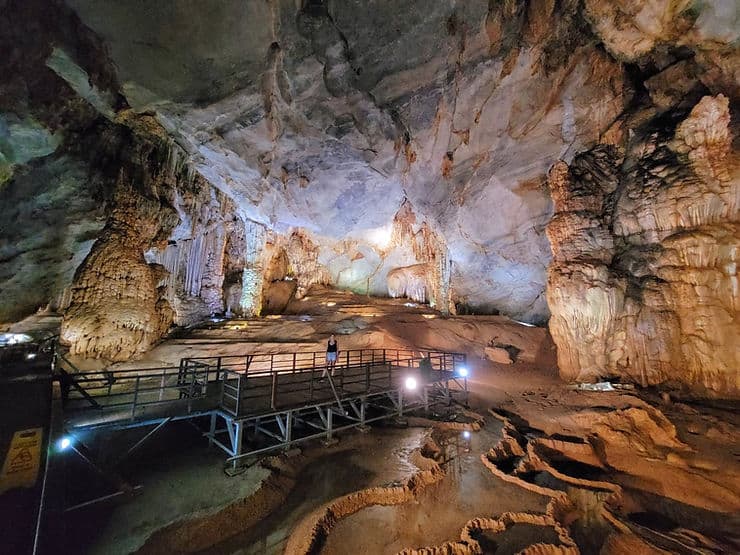
Budgeting for your trip is one of the most important things you can do, both before and during your travels. Make sure that you read these top tips to help you manage your budget and keep track of your spending when travelling.
Need help saving for your dream trip? Check out my 12 super simple tips for how to save for full time travel
10. Have a couple of good debit cards
One of the most important things you will need when travelling is a safe way to access your money. Instead of using your normal bank debit card, which may have expensive fees for use overseas, get yourself a new debit card, purely for travelling. I use a Starling Bank debit card, but I’ve also heard good things from travellers about Revolut and Monzo too. Instead of having all your money on your travelling debit card, simply ‘top it up’ when you need and keep just a small amount on the card. That way, if you lose the card, or it gets stolen, you don’t risk losing a lot of money. For this same reason, having two debit cards you can use in this way is also a great idea (just make sure you keep them in different places!).
11. Pay for large items on a credit card
When booking things like accommodation, travel (especially flights) and activities, always use a credit card. Credit cards offer a much higher protection on spending and if something goes wrong with the supplier (for example, if the service provider goes out of business), your credit card company can help you to claim your money back. I have a Halifax Clarity credit card which is great for travelling and using abroad. Shop around and find a credit card with low or zero exchange fees or charges for using it overseas.
12. Always carry some cash
When travelling in Southeast Asia, it’s a good idea to always have a bit of cash on you. If you are travelling to more remote areas, or buying something from a local shop or stall, you will need to pay for it in cash. Just be aware that many of the ATM’s in Southeast Asia charge for withdrawing money and they have a limit for how much you can withdraw, which is annoying!
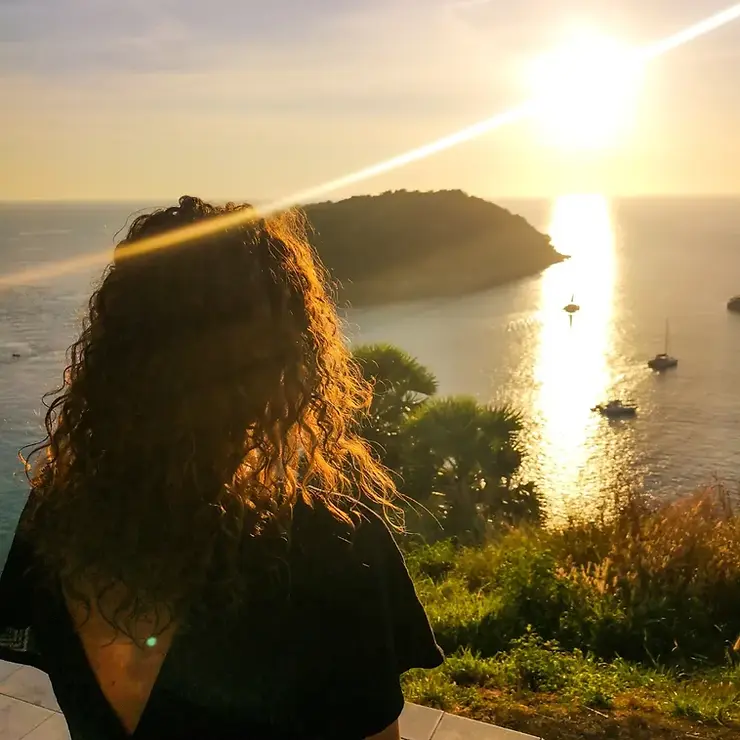
(Image: Windmill Viewpoint, Phuket, Thailand)
13. Make sure you can access your bank account if you lose your phone
Most of us manage our bank accounts via an app on our phones. However, what happens if your phone is lost or stolen? Make sure that you know how to access your bank account online or over the phone.
14. Set yourself a travel budget and track your daily spend
Possibly THE most important element of travelling is budget management! It doesn’t sound exciting (and it’s not!), but it’s vital if you don’t want your trip to end abruptly because you’ve run out of money.
When planning your trip, do your research and set a daily budget. This should be based on the prices of accommodation, food, transport and activities in your destination and also what kind of experience you want to have (on the scale of budget backpacker – luxury holiday). Read my step by step guide on How to budget for full time travel and create your own Travel Budget (you can also download my FREE Travel Budget Spreadsheet Template).
Make sure you record your daily spend to keep you on track. I use the free version of @travelspendapp . Managing your budget means that if you’re careful in some places, you can splurge on more expensive trips in others, such as an overnight luxury cruise to Halong Bay in Vietnam
15. Take advantage of travel rewards programs
There are plenty of rewards programs available to savvy travellers. One of my favourite reward programs is the Booking.com genius program. The more qualified bookings you make through your Booking.com account, the more genius points you can earn, which can get you discounts and upgrades on certain hotels, transport and experiences.
Another great rewards program, if you are from the UK, is Topcashback . Simply login to your Topcashback account and make your booking with one of the travel providers via the Topcashback site to earn cash back on your purchase.
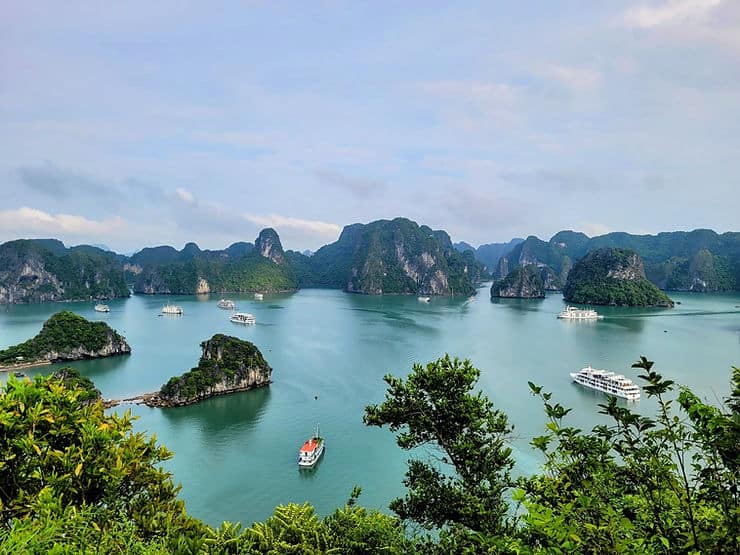
Southeast Asia is a large, diverse continent and even the individual countries within Southeast Asia are massive, so you’re going to want to travel around and explore as much of it as possible. Getting around in Southeast Asia is not always the most straightforward, so here’s some tips to help you navigate public transport.
16. Shop around for the best deal on public transport
During the 7 months I spent in Southeast Asia, I booked a lot of my bus and ferry journeys online. One of the best booking platforms for transport in Southeast Asia is 12go . Camboticket in Cambodia is also another good option. (For booking tours, Viator , Get your Guide and Klook are all great platforms). But don’t just rely on websites. Speak to your hotel or hostel and get their advice. Sometimes they can tell you about transport routes or tour companies that don’t appear on the larger comparison websites. Whatever you are booking, shop around and get a couple of prices for the best deal.
If you are travelling a longer distance, or between countries, don’t assume that travelling by plane will always be more expensive. Sometimes a flight can be cheaper, or a similar price to a long distance train, especially if you have carry-on only bags. It’s also worth taking into consideration the journey time. If a flight is only £30 more but takes 14 hours less than the bus, it may be a better option for you.
17. Travelling from A to B is not as easy as it sounds!
Travelling from A to B sounds easy (and it should be!), however travelling from A to B in Southeast Asia usually ends up being a lot more complicated than it needs to be! Don’t be surprised if you are asked to change buses several times throughout your journey as different drivers and companies take over each section of the trip. I took a journey in Thailand from Railay in Krabi to Koh Samui which took 12 hours and consisted of 1 boat, 5 buses, 1 ferry and a taxi (which was 4 more buses than expected!) Try to stay patient and go with it, it won’t make you feel any better getting stressed about it.
18. Give yourself plenty of time for transfers
As I’ve mentioned, travel in Southeast Asia is usually not a simple process. Often journeys depart later than scheduled and will take a lot longer as the drivers make random stops along the way. If you are planning a journey that has transfers with different companies (for example, a bus journey followed by a ferry), make sure that you leave plenty of time between each leg of the journey, as you are most likely going to be late!
19. Prepare for delays or things to go wrong
You can see a theme emerging here! Most journeys in Southeast Asia are late, or delayed, or there’s been a miscommunication with your booking. Try to be patient and polite with the locals. Most local people I encountered in Southeast Asia were incredibly warm and friendly and willing to help. So, be respectful and don’t be rude if things don’t go to plan, it’s all part of the travelling experience!
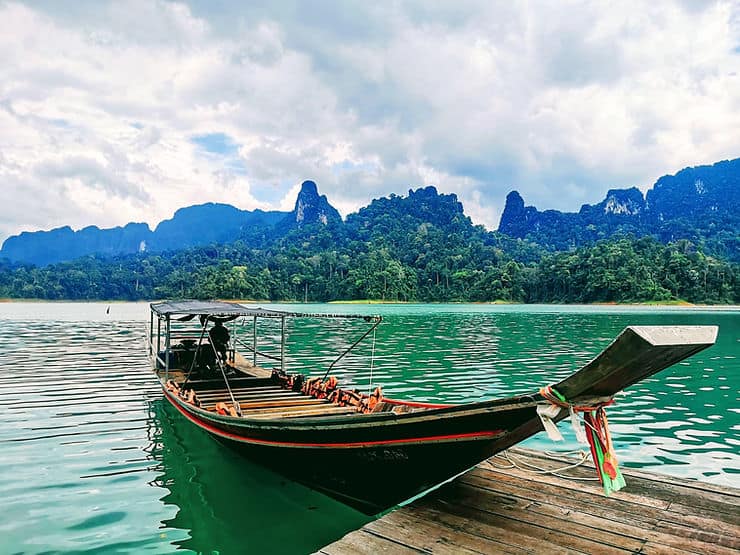
20. Don’t expect formal booking confirmations for public transport
If you’re the kind of person who likes to have written confirmation of everything, then prepare to get out of your comfort zone! As someone who is super organised and over-prepared, I had to learn to accept that formal booking confirmations don’t always exist in Southeast Asia when booking transport. Instead, you’ll be given a flimsy paper slip as confirmation, which at some point will be taken off you and replaced with a coloured sticker (which may later be replaced with another sticker!) They do love a sticker, especially in Thailand! Just take photos of your paper slip or sticker in case you lose it and you’ll be fine.
21. ALWAYS negotiate when ordering a tuk-tuk or taxi!
Rule no.1 when travelling in Southeast Asia – always negotiate! In some of the larger cities you can use Grab, Uber or Gojek which is great as it gives you an idea of what the cost should be. Even if you are getting a ride with a local driver, use the price on Grab/Uber/Gojek to help you negotiate. If that is not available, ask your hostel or hotel how much the prices should be so you have an idea of what is a good price and what is a bad price.
22. Get an international driving licence
If you are considering hiring a car or scooter in Southeast Asia, get yourself an International driving licence. If you are from the UK, you can pick these up in the Post Office for £5. Make sure you keep your licence and your international licence with you at all times when driving. Occasionally local police may stop you and ask to see your licence and if you don’t have it (or the correct one), they may fine you.
23. Don’t feel pressured into riding a scooter
Travelling in Southeast Asia and riding a scooter seem to go hand in hand (if you believe everything you see on Instagram, or read in some blogs). However, don’t feel pressured to ride a scooter if you don’t feel comfortable. The roads in Southeast Asia are uneven and windy and the traffic can be crazy, with people cutting you up and zig-zagging down the road. It is absolutely possible to travel in Southeast Asia without riding a scooter if you don’t want to. If you do want to ride a scooter, make sure your travel insurance covers you and always wear a helmet.
24. Have motion sickness tablets with you on travel days
Even if you don’t normally feel travel sick, you may find yourself feeling queasy. Many of the roads in Southeast Asia are quite hilly and windy and the drivers can be fast and erratic. Also, if you are on a small minibus, it is usually hot and cramped, making you feel even worse. (If you are in the north of Thailand, the Chiang Mai – Pai bus is notorious for making people feel ill). Buses aside, you will likely be taking several boats and ferries during your time travelling in Southeast Asia and some of the boat crossings can be bumpy. Make sure that you have some motion sickness tablets with you for your journey. These can be picked up cheaply from 7/11 in Thailand and also most pharmacies or shops.
25. Pack warm clothing in your day bag on travel days
If you are travelling long distances on a coach or sleeper bus, make sure you keep a warm top or hoodie with you. The buses in Southeast Asia are renowned for having the coldest air conditioning!
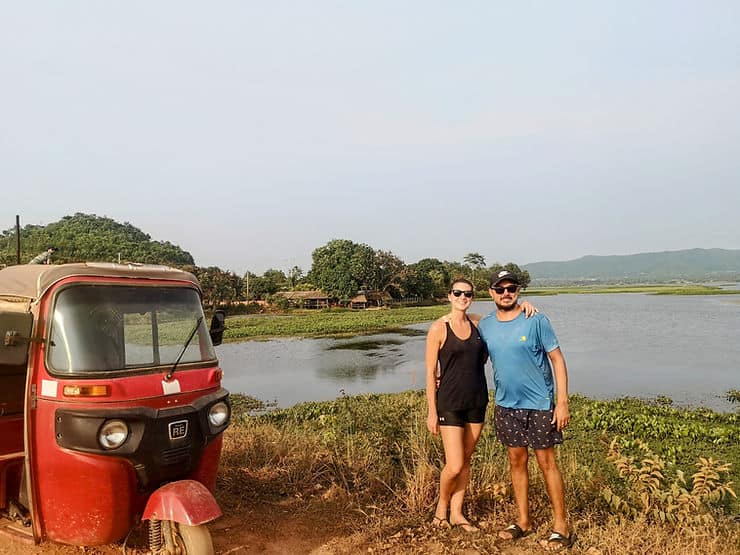
Sampling the food and drink in a new country is all part of the travelling experience and one of the best parts of visiting Southeast Asia is to eat the local food. Here’s a few tips to keep you safe and avoid the dreaded traveller’s belly!
26. Don’t drink the tap water
Unless you want to spend a couple of days being ill, don’t drink the tap water! Bottled water is very cheap to buy, Unfortunately, this does often mean that you will be using a lot of single-use plastic, which is a big problem in Southeast Asia. Some larger cities such as Bangkok, Phuket and Chiang Mai in Thailand have filtered water machines where you can top up your refillable water bottle for a fraction of the cost.
27. Be careful of the fruit!
It can be hard to stay healthy when travelling and the fruit in Southeast Asia is delicious, however, just be careful where you buy it from. There’s plenty of street stalls selling pre-cut fruit. Most of it will be fine, however you don’t know how long it has been sitting there getting warm and also whether it has been washed in clean drinking water. Eating dodgy fruit can make you really sick and wipe you out for several days – believe me! Try to pick places where they cut the fruit fresh in front of you, or buy whole fruit which you can peel/cut yourself.
28. Eat the street food!
The street food scene in Southeast Asia is brilliant (plus its great for your budget too!) The street markets are a lively buzz of noise and smells, creating a great atmosphere. Make sure you go to as many street food markets as you can, it’s all part of the Southeast Asia experience! If you buy meat from a street vendor, make sure that they fry it / cook it in front of you. Eating meat that has been left out for a while is another thing that could leave you chained to the bathroom for a day or two.
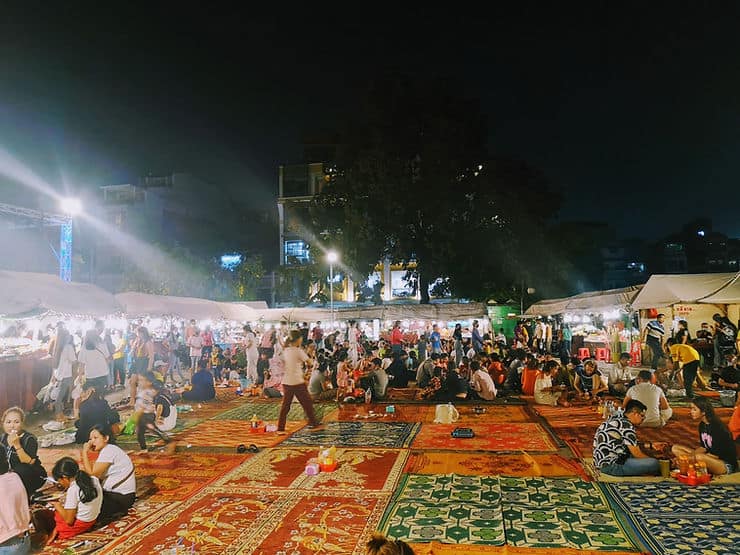
29. Try local dishes
When you visit somewhere new, make sure you know what the local dishes are and try them. Ask the locals you meet what food you should eat whilst you are there. There’s often regional variations of national dishes too.
30. Don’t be put off by the interior (or lack of!) a place
Some of the best food I’ve eaten in Southeast Asia has been whilst sitting outside on a tiny plastic stool at a metal table! In my experience, the small, family-run local restaurants have the best food and even better, they are the most budget-friendly too!
31. Bring a reusable water bottle and bag
As I’ve mentioned, some of the larger cities and towns in Southeast Asia do have places where you can top up your reusable water bottle. There are also some cafes which will allow you to top up for a small charge. Reusable water bottles are also vital for taking on some of the amazing hikes Thailand has to offer. Tip – buy an insulated bottle to keep your water cool!
Take a reusable cotton tote bag too for your shopping, rather than asking for a plastic bag each time you go to the shop. This foldable tote bag is perfect as it has a zip to keep your valuables secure too.
32. Check the spice level!
Spicy food in Southeast Asia is on a different level! A ‘mild’ dish is comparable to a medium in the UK. Don’t be afraid to ask for no chilli or for a dish to not be spicy.
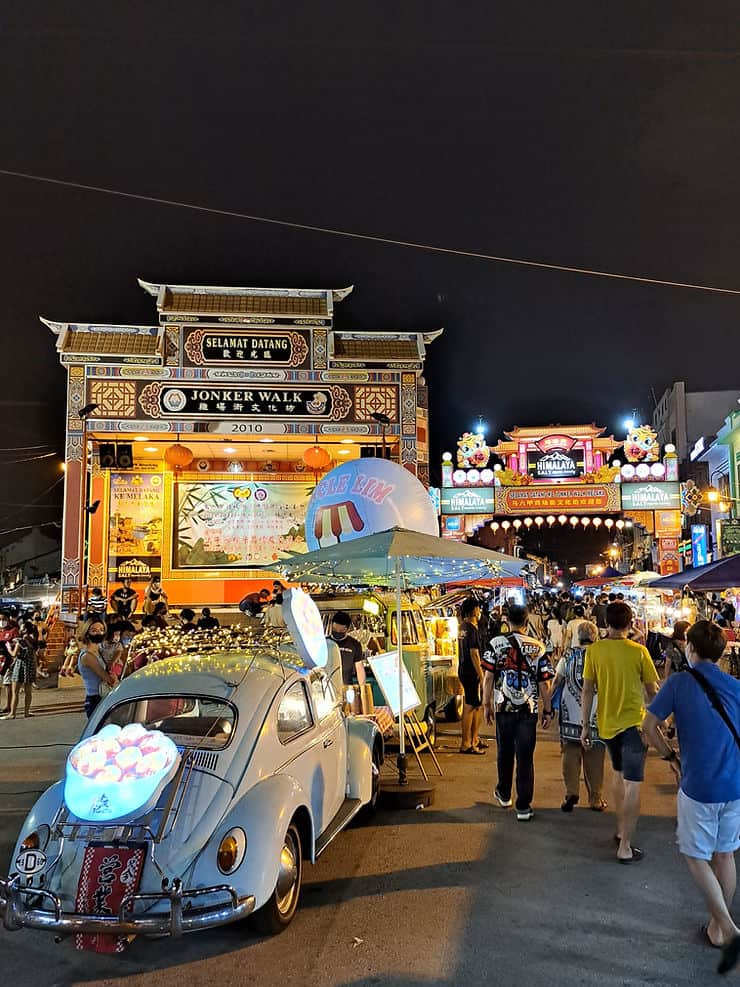
Experiencing a different culture and learning about the history and traditions of a place is one of the best bits about travelling. Read these four things you must do to make sure that you are respectful and get off to a great start with the locals when travelling in Southeast Asia.
33. Learn basic phrases
If you are travelling in another country, even just for a couple of weeks, it’s a great courtesy to know a couple of key phrases, such as Hello and Thank You. Even though English is widely spoken across Southeast Asia, locals love it when you try to speak a little of their own language and will be happy to teach you some new phrases.
34. Be respectful
Southeast Asian culture is very different to western culture and each country in Southeast Asia has their own traditions and cultural differences. Make sure that you know how to behave in certain situations and be respectful. For example, women should not approach, converse with or touch Monks. Women also cannot enter certain shrines or temples whilst menstruating.
Travelling to Bangkok? Make sure you visit these three temples
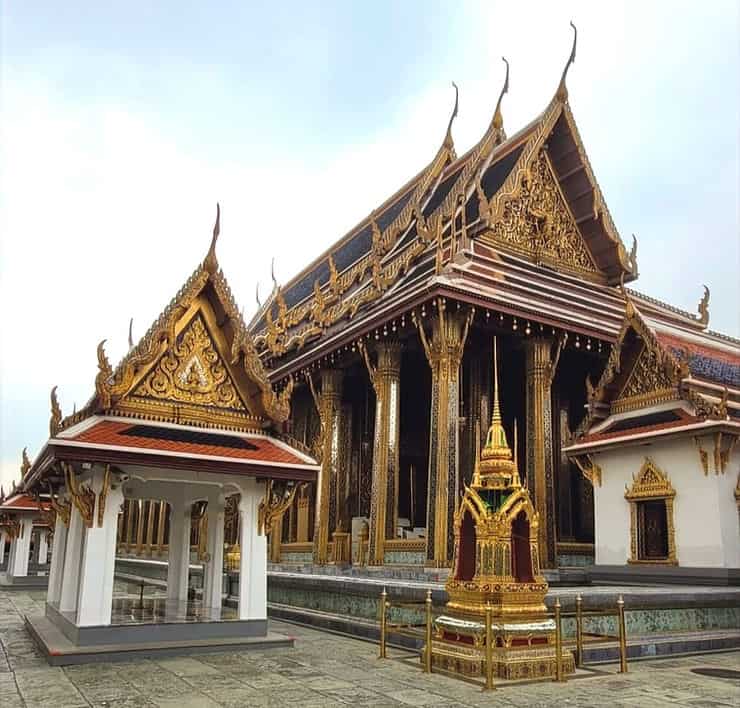
35. Dress appropriately
Whilst both men and women should make sure that they are respectfully dressed when entering a temple or government building, this mostly applies to women. Whether you’re exploring Ankor Wat , in Cambodia or the Grand Palace in Bangkok, women must always cover their knees and shoulders when visiting a temple.
When bathing in certain spots, it is respectful to cover up. Wearing a bikini is acceptable at most public beaches and in your hotel or hostel pool, however, if you are visiting a local bathing spot, you will notice that Southeast Asian women wear shorts and a t-shirt to bathe in. It is polite to do the same.
36. Take off your shoes
This is common practice in many places throughout Southeast Asia, but it is mostly associated with Thailand. Shoes should always be removed before entering a temple, but you will also need to remove shoes before entering other places too. If you are staying in a small guesthouse, or homestay, it is polite to leave your shoes outside. This is the same if you enter a small, local shop and even when you travel on certain boats and buses (especially the sleeper buses in Vietnam).
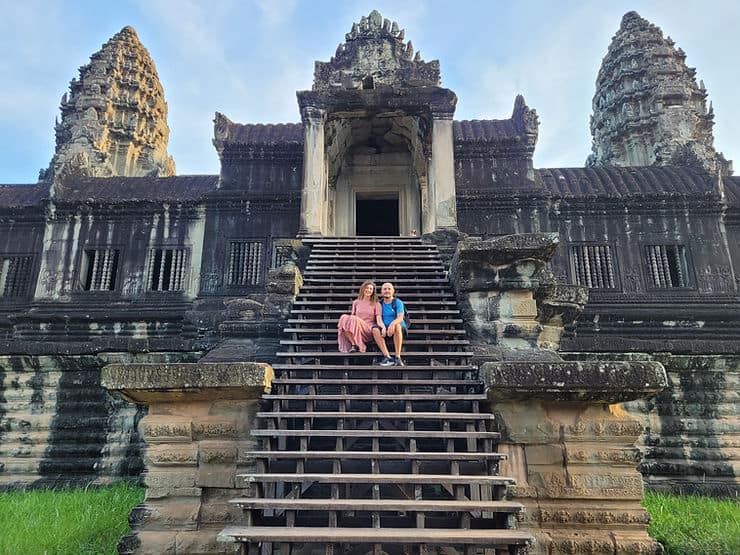
Prepare for your trip to Southeast Asia by making sure that your health requirements and needs are taken care of before you travel…
37. Check what vaccinations you need before you go
When planning a trip to any new country, it is important to make sure you have received all the relevant vaccinations beforehand. If you are in the UK, you can check the NHS website to see which vaccinations are recommended for the country you are visiting and which vaccinations you can get for free on the NHS.
38. Stock up on sunscreen
Suncream is not widely available in Southeast Asia, especially if you are travelling away from the main tourist holiday destinations. It is also very expensive. You will find lots of ‘sun serums’ or ‘daily lotions with spf’ – be careful with these, whilst they do offer some level of protection, they are not full sun creams and are not recommended for using while sunbathing. If you are only travelling for a short amount of time, take several bottles with you from home, if you have room.
39. Take any medication / feminine products with you
If you are travelling to some of the smaller islands, or more remote places in Southeast Asia, there is not always a large pharmacy available. So, if you need medication, make sure that you bring it with you and restock it before you run out. Feminine products can be expensive too, so if you can, bring these with you.
40. Always carry medication for ‘travellers belly’
It’s not nice to talk about but almost every traveller will experience an upset stomach at some point during their travels in Southeast Asia (no matter how careful you are). Although the best advice is to rest and let the bug ‘pass through’, that is not always possible, especially if you have a bus journey to get through. With that in mind, carrying some tablets for diarrhoea will be a lifesaver!
41. Always have a toilet roll with you on travel days!
This goes hand in hand with the above – most toilets in Southeast Asia don’t have toilet paper and there’s usually a small fee for using them, so carry some small change too.
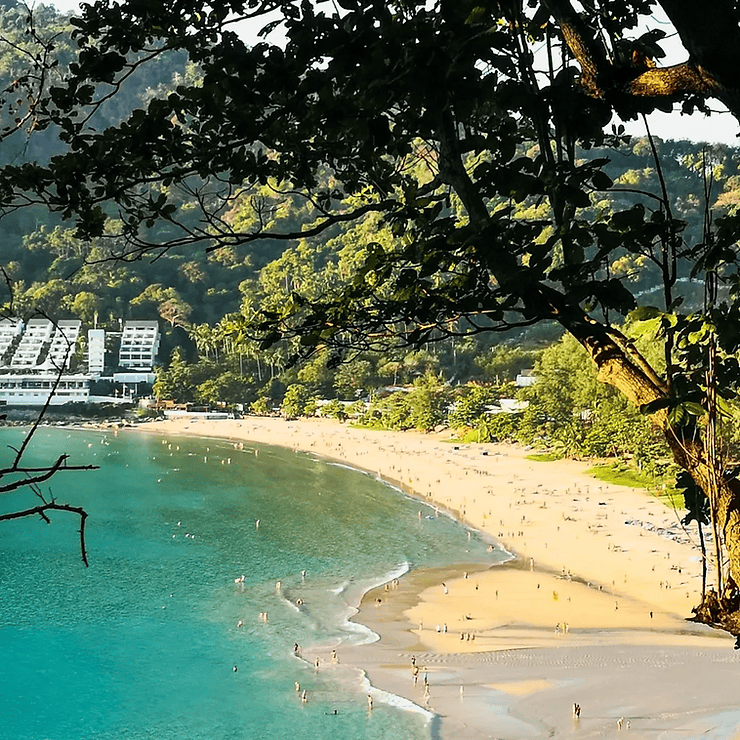
Depending on how long you are travelling in Southeast Asia for, your packing list will vary. This is also true if you are planning a long trip and are visiting other places outside of Southeast Asia too. So, rather than include a full packing list in this post, here’s a couple of top tips to help you pack better.
42. Take a Scarf or sarong
A scarf or sarong is one of the most versatile items you can pack in your bag. It is great for covering your shoulders in a temple, laying on at the beach, throwing on over a bikini, using it as a pillow on travel days or keeping you warm on the buses! Plus it takes up virtually no space in your bag!
43. Pack layers
You definitely don’t need as many clothes as you think you do, and you will end up wearing the same things over and over! Pack light things that you can layer and roll up small in your bag. In terms of shoes, one pair of trainers, one pair of flip flops and one pair of Birkenstock or chunky walking sandals will be suitable for pretty much everything in Southeast Asia. I lived in my Birkenstocks for pretty much the whole year!
44. Leave room for new clothes!
Don’t go shopping for everything before you leave home. The clothes in Southeast Asia are so cheap and let’s face it, most of the clothes you will buy at home will most likely come from Southeast Asia anyway! If there’s anything you’ve forgotten or wished you had packed, you will more than likely be able to buy it in Southeast Asia.
45. Be savvy with your chargers
There’s nothing worse than having a bag full of cables and charging wires! A lot of devices will accept the same charger cable and this is a great way to reduce the number of wires you take. For example, my laptop wire will fit my phone and my Go pro, meaning I only need one wire for three devices. (I do also have a single USB cable that will plug into an adaptor so I can charge two things at one, but this takes up hardly any room). I’d also recommend putting your wires into a small organiser case , so they are easy to locate in your bag.
46. Embrace the packing cube!
Packing cubes are a lifesaver when it comes to packing for travelling. Even if you are sceptical about it at first, you will soon realise how handy they are. It’s a great way to separate (and easily locate!) your clothes in your bag. They also help to condense things down in your bag!
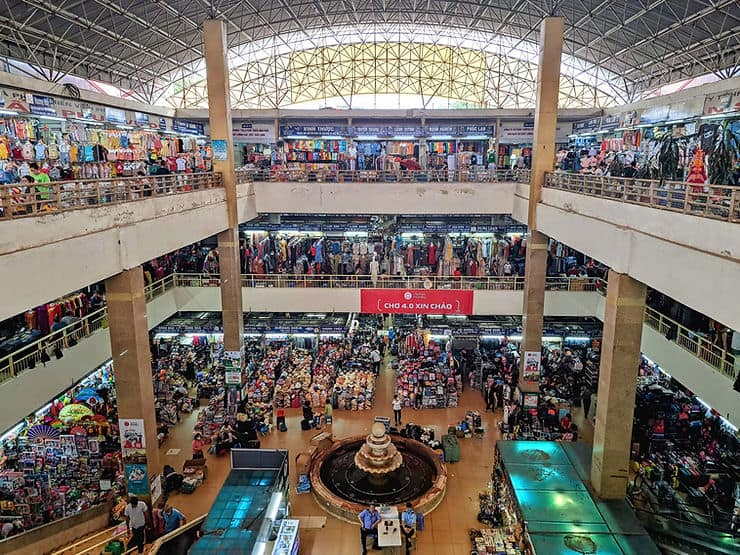
Making the decision to go travelling can be scary but it is also super exciting! Have the best time and remember that comparison is the devil!
47. Chat to others
One of the best parts of travelling is meeting other like-minded travellers. There’s a reason that Southeast Asia is one of the best places to travel solo. There’s so many great hostels and Facebook groups, where you can meet up with other people.
48. Everyone has bad days when travelling
You will have THE BEST time travelling, but there will also be some days that don’t quite go to plan and other days where you are tired or may feel homesick. The best advice I can give you is not to dwell on those days, it is completely normal and usually after a good night’s sleep and a comfy bed, you will feel much better.
49. Don’t compare your journey to others
Everyone’s travel experience is different and your trip will be unique to you. Don’t get caught up in comparing your journey to everyone else’s, just enjoy and embrace your own travel experience.
50. Have fun!
Travel is one of the best things you can do (in my totally biased opinion!). Whether you’re travelling in Southeast Asia for a few weeks or a few months, relax, go with the flow and HAVE FUN!
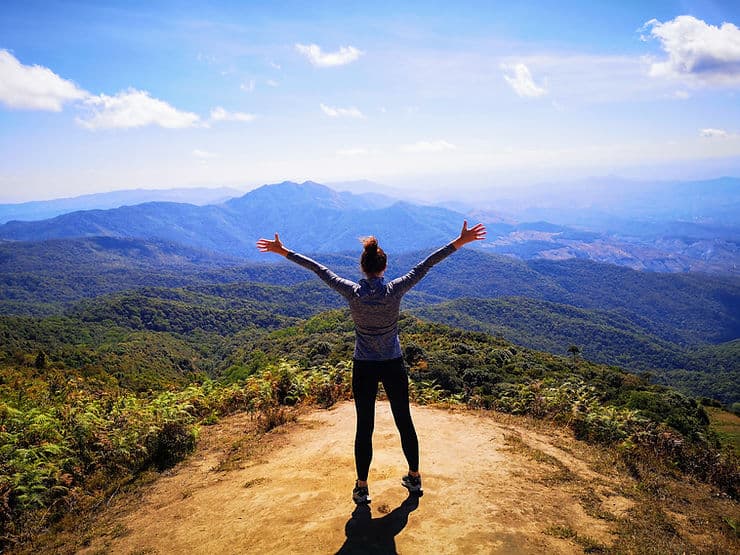
Related Posts
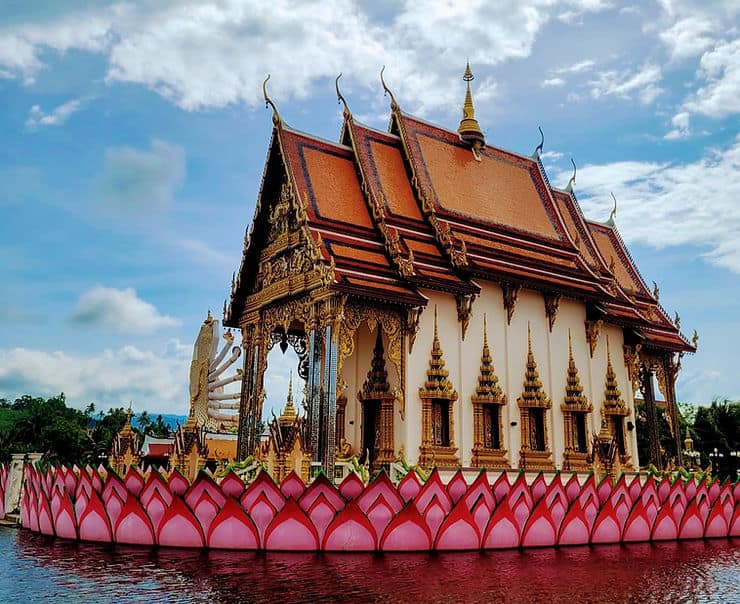
Top 15 things to do on Koh Samui, Thailand
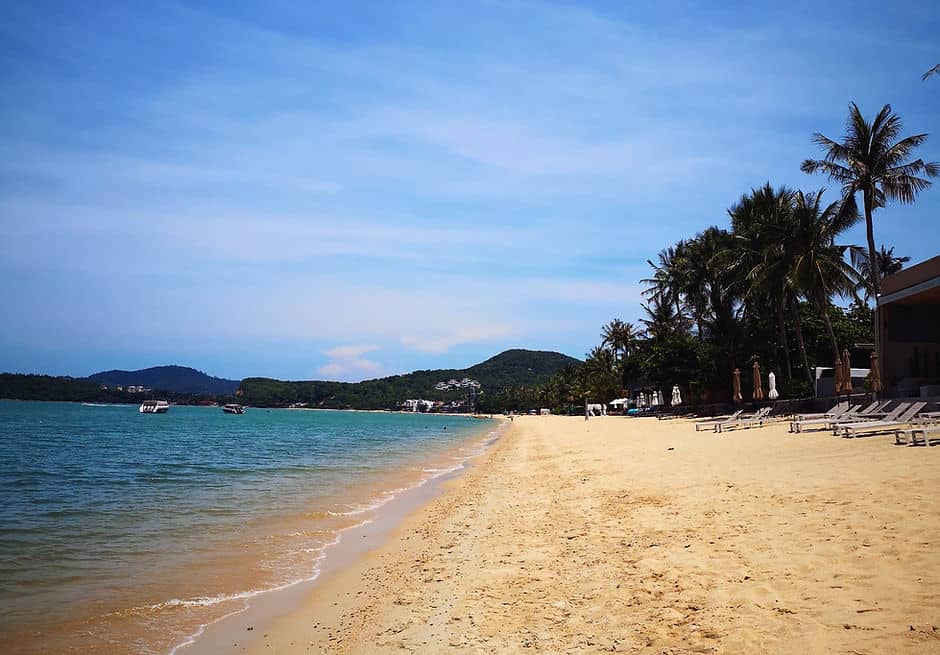
A guide to visiting Koh Samui, Thailand
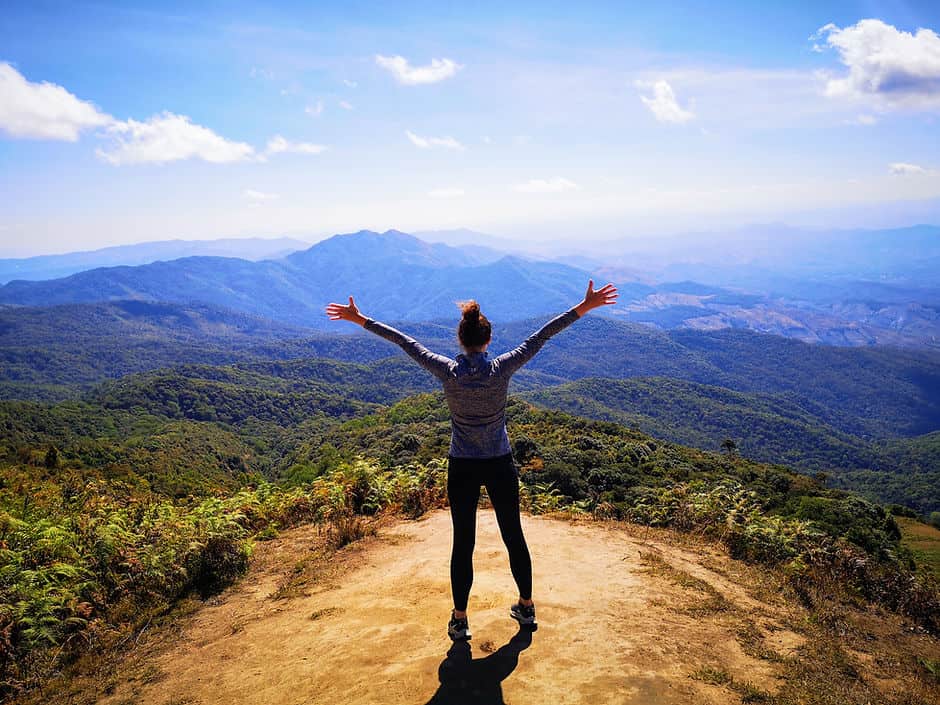
10 Unmissable hikes in Thailand
Nomadic Matt's Travel Site
Travel Better, Cheaper, Longer
Southeast Asia Travel Guide
Last Updated: November 27, 2023

Backpackers have been traveling through Southeast Asia since the late 1960s and early 1970s, leaving a well-worn trail around the region.
Starting in beautiful Thailand, the trail makes its way to up-and-coming Laos, through Vietnam, and to the temples of Angkor Wat. It then winds back into Thailand, where people head south to party in the Thai islands before moving down to Malaysia and Singapore.
There are a few variations to the trail, but this is what it mostly covers.
I’ve been visiting this region since 2004 and spent years living in Thailand . I love backpacking Southeast Asia and have written extensively about it as I know it like the back of my hand.
It’s an especially great region for new travelers because it’s easy to travel around, it’s safe, and there are lots of other travelers you can meet. But it’s also perfect for veteran travelers too as there are tons of off-the-beaten-path destinations that the standard backpacker trail doesn’t cover.
In short, Southeast Asia has something for every traveler — and every budget.
This Southeast Asia travel guide will help you travel the region like a pro, ensuring you save money and make the most of your time in this fun, gorgeous, and lively corner of the world.
Table of Contents
- Things to See and Do
- Typical Costs
- Suggested Budget
- Money-Saving Tips
- Where to Stay
- How to Get Around
- How to Stay Safe
- Best Places to Book Your Trip
- Related Blogs on Southeast Asia
Click Here for Country Guides
Top 5 things to see and do in southeast asia.
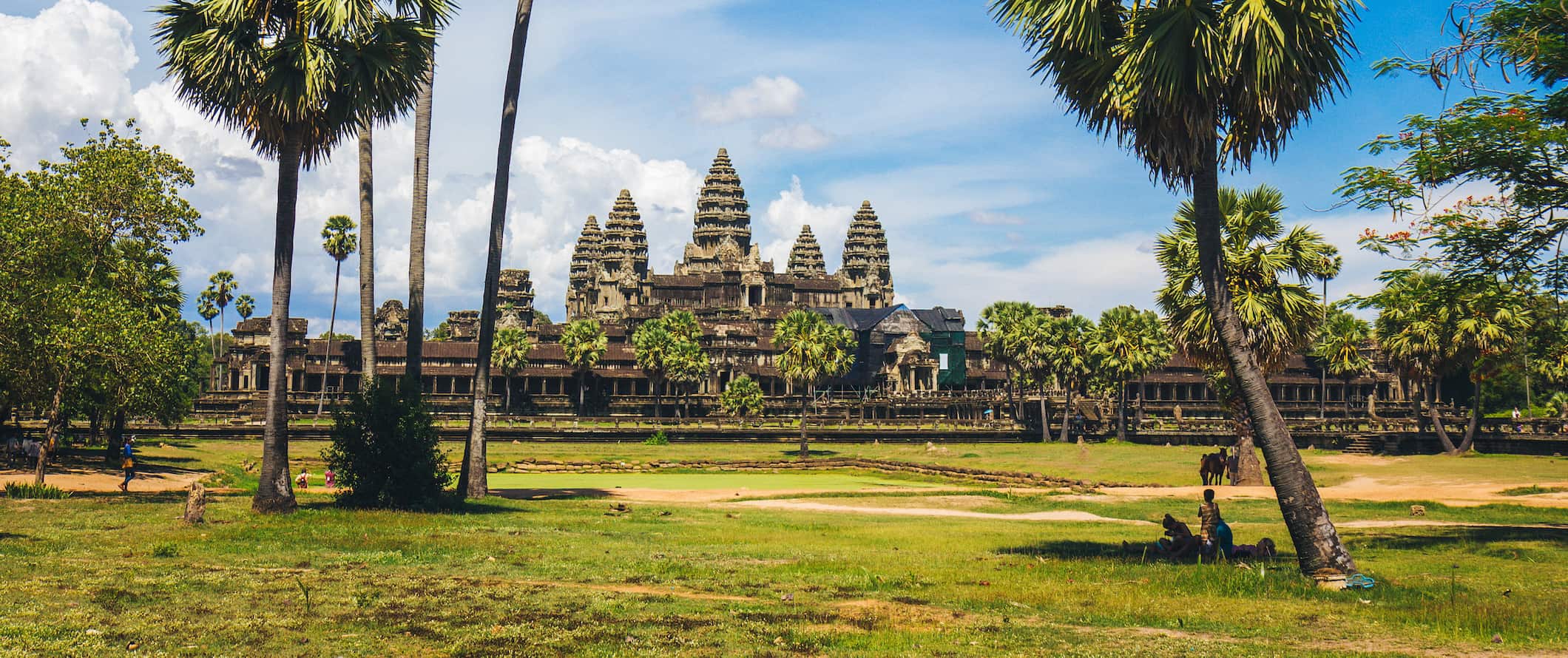
1. Admire Angkor Wat
One of the greatest human creations in history, the Angkor Wat temple complex is best explored over the course of a few days. The area is a UNESCO World Heritage Site created by the Khmer Empire and absolutely enormous. Temples to visit include Angkor Wat, Bayon Temple which has 216 gigantic stone face carvings, and Ta Prohm. I spent three days here and that simply wasn’t enough. A one-day pass is $37 USD, while a 1-week pass is $72 USD. If you’re here for multiple days, be sure to hire a driver and see some of the more out of the way ruins away from the main temple complex (and the crowds).
2. Explore Bangkok
Bangkok is the hub of travel activity in Southeast Asia. You can get anywhere you want from here. Though I hated it at first, the more I’ve spent time here the more I love it. Bangkok is like an onion whose many layers need to be peeled back. Some things not to miss include the spectacular Bangkok Grand Palace, Wat Pho, Chatuchak Market and Asiatique, and a canal trip on the Chao Phraya River. This is a city for foodies and wild nightlife.
3. Relax on some tropical islands
No visit to Southeast Asia would be complete without a visit to at least one of the thousands of tropical islands in the region. My top five include the Perhentian Islands (Malaysia), Rabbit Island (Cambodia), Ko Lanta (Thailand), and Boracay (Philippines). Lombok Island (Indonesia) has a chill vibe with unspoiled, perfect “desert island” beaches. There’s so many islands to visit. Be sure to add at least one to your trip. The country guides will have more information for you.
4. See Ha Long Bay
Sailing trips to this island-filled bay with stunning emerald waters, limestone formations, and marine life give you an appreciation for the natural beauty in Vietnam. Tours from Hanoi start at around $110 USD for two-day trips and increase from there. I love the colorful grottoes, hanging stalactites, and stalagmites of Surprise Cave (Sung Sot), Fairy Cave (Tien Ong), and Heaven Palace (Thien Cung). Make sure you go with a reputable company though as some of the cheaper boats are less than ideal. If you’d rather just visit for one day, day trips from Hanoi cost $55 USD.
5. Wander Kuala Lumpur
Other things to see and do in southeast asia, 1. go jungle trekking.
This region of the world is covered in amazing jungles with diverse wildlife, plentiful camping opportunities, and cool waterfalls. The best jungle treks are found in northern Thailand, Western Laos, and Malaysian Borneo (the latter are also the hardest and most intense). Some of my favorites include Danum Valley (Borneo) for its incredible wildlife; Ratanakiri (Cambodia) for its pristine wilderness and thousand-year-old trees; and Pu Luong Nature Reserve (Vietnam). Costs vary but jungle trekking generally costs $30-50 USD per day.
2. Attend the Full Moon Party
The biggest one-night party in the world welcomes up to 30,000 people with a party that stretches until dawn. Cover yourself in glow paint, grab a bucket of booze, and dance the night away with new friends on the island of Ko Phangan in Thailand. As the name would suggest, the party is on the night of the full moon. If you miss it, there’s always the half-moon party, quarter-moon party, and black-moon party. Really, every night is a party on Ko Phangan . Just avoid the flaming jump rope that occurs — I’ve seen people get burned badly!
3. Learn to dive
There are many great dive sites around the region for those interested in underwater exploration. You can learn to dive here at a fraction of what it would cost back home too. Some of the best places are Ko Tao (Thailand), Sipadan (Malaysia), as well as Gili Islands (Indonesia) and Coron, Palawan (The Philippines). A typical diving course is completed in three days. A PADI course typically runs $275 USD in Thailand, including three nights’ accommodation, though at smaller schools you can often negotiate down to $250 USD. Day trips for certified divers start at $165 USD. For information on Ko Tao, check out this blog post .
4. Eat street food in Singapore
Singapore is a foodie’s heaven. Try the hawker stalls of Singapore as well as Little India and Chinatown for some of the best and cheapest food in Asia. If you’re looking for a nice place to sit down and eat, eat at Singapore’s famed restaurants during lunch when restaurants offer discounts, making them a great deal. You’ll also find the most affordable Michelin-starred restaurants here (Tian Tian Hainanese Chicken Rice and Hawker Chan), offering world-class meals for just a couple of bucks!
5. Overload on temples
You can’t turn a corner without seeing a Buddhist temple in this part of the world. You’ll get temple overload at some point but visit as many as you can as each is unique to the country and region of the temple. There are so many places with high concentrations of ornate and beautiful temples. Check out Chiang Mai’s Wat Doi Suthep Temple and hike up the 300 steps to the golden Chedi that’s 600 years old!; Bagan’s Shwesandaw Pagoda from the 11th century with its stunning golden dome; Angkor Wat’s Ta Prohm is covered in iconic vines and enveloped in ancient jungle roots; Hue’s colorful Thien Mu Pagoda is perched atop a lush green embankment; Hoi An’s Quan Cong Temple with incredible Chinese architecture with hand-carved beauty and skill, and Luang Prabang’s Vat Xieng Thong with its golden, canopied roof. Most are free to enter, however, dress codes are enforced (you need to have your shoulders and legs covered).
6. Dive Sipadan
Located off Malaysian Borneo, Sipadan is one of the best dive sites in the world. If you have your dive certificate, make sure you venture out here. I absolutely love this area because it’s teeming with live turtles, diverse cave systems, sharks, dolphins, colorful coral, bright fish, and everything in between. Not a lot of people make it to this part of Malaysia, but it’s worth it to go the extra mile and make your way off the tourist trail a bit. Don’t miss Barracuda Point and The Drop-Off. Keep in mind that only 176 permits to dive at the island are issued each day, costing 140 MYR per person. The resorts on the neighboring islands each get a specific number of permits per day and require divers to stay with them for a few days. So you’ll need to stay at those resorts and dive into the surrounding areas before they can get you a Sipadan permit.
7. Fall in love with Bali
Bali is the most popular destination in Indonesia, and its famous Kuta beach is known for its wild parties and surfing ( though I think it’s overrated ). However, there is much more to Bali than just wild nights and sun-soaked days. If you’re a thrill seeker, hike up to the top of Mount Batur, an active volcano, for a breathtaking sunrise. Paragliding and white water rafting are also super popular here, as is surfing (it’s an affordable place to learn if you’ve never done it). There are also lots of hot springs to enjoy, the Ubud Monkey Forest (a popular temple and nature reserve home to hundreds of monkeys), and numerous places to scuba dive, including the Liberty wreck and Manta Point.
8. Take in Ho Chi Minh City
Frantic, chaotic, and crazy, Ho Chi Minh City in Vietnam is the embodiment of the controlled chaos that rules Southeast Asia. You can’t quite figure out how this teeming mass of people and cars work together, but it does. Highlights here include touring the tunnels used by the Viet Cong in the 1960s, taking in the view from the Saigon Skydeck, eating your way through the street food scene, and seeing the city’s numerous temples.
9. Admire the sunrise over an Indonesian Volcano
One of the most popular tourist attractions on Java is Mount Bromo and its National Park. Don’t miss out on getting a photo of the smoldering Bromo volcano as it lies surrounded by the almost lunar landscape of the Sea of Sand. Get up early to catch one of the most memorable sunrises of your life. If you’re there in mid-August, you’ll be just in time to see Upacara Kasada, the traditional Hindu ritual of the Tenggerese, a Javanese tribe of the region.
10. Hike in Khao Sok National Park
Located in southern Thailand, Khao Sok National Park is constantly rated as one of the best parks in Thailand, with incredible trekking, camping, limestone karsts, cooling rivers, and a glistening lake. Visit for semi-challenging hikes, tons of wildlife, walking paths, and breathtaking sunsets. Park entrance costs around $6 USD while full-day guided tours are $95 USD. I highly recommend spending at least one night here to get the full experience.
11. Visit Kampot
Most people come to Kampot to enjoy the scenic riverside views, as well as the rolling hills that surround the city. Since you can explore easily enough on foot or by bicycle, Kampot is a great place to slow down and relax. There’s not much to do here but have lazy days by the river, chill, and eat (don’t miss the famous Rusty Keyhole for BBQ!). Don’t miss the pepper farms, as this region of Cambodia is filled with pepper farms where you can learn about the history of the spice, see how it is grown, and pick up what is considered some of the finest pepper in the world. Tours are usually free.
12. Take a cooking class
Food from this region is as varied as the countries themselves and learning how to cook a few dishes is a great souvenir of your time here. Even if you don’t plan to cook back home, you can still spend a day making and eating scrumptious food. Most big cities have cooking schools offering classes of 2-6 hours, often including a trip to the local market beforehand to select ingredients. I absolutely love cooking classes and urge you to take one at least once. They are a fun experience!
13. Take a food tour
If you’d rather eat instead of cook, taking a food tour is a fun way to gain insight into the region’s amazing noodle dishes, fresh seafood, sweets, and street food while learning about the history and culture behind the cuisine. Most major cities in Southeast Asia offer food tours. These include tours around local markets, street stalls, and tours to locally-owned restaurants and cafes where you can sample the local cuisine and connect with a local chef. If you’re nervous about street food, this is a great way to try some in a controlled setting. Tours usually last 2-4 hours and include multiple stops and several different dishes, with prices costing $40-75 USD per person.
14. Visit an elephant sanctuary
While riding an elephant is on many a Southeast Asia bucket list, once you know how much the animals suffer from abuse in order to provide these rides, you might think twice about taking one. An even better way to interact with elephants is to volunteer at or visit the Elephant Nature Park near Chiang Mai in Thailand. It’s a phenomenal place, allowing you to give back to the community and these magnificent animals all at once. After coming here, you will understand why you should NEVER ride an elephant. A one-day visit costs $70 USD.
15. See The Killing Fields
A visit to Choeung Ek, also known as the Killing Fields, may not be the most cheerful way to spend an afternoon, but it makes for an educational and memorable experience. Over 3 million people were killed by Pol Pot’s regime, including countless women and children. I recommend getting a guide so you can really understand what you’re seeing as you explore the area. Also, this horrific tragedy took place less than 50 years ago and is still very present so please be respectful as a visitor. The site is located 10 miles from Phnom Penh. Half-day guided tours start at $66 USD.
16. Swim with Whale Sharks in Donsol
If you’re in the Philippines, check out the Donsol Whale Shark Interactive Ecosystem Project because there are not many experiences quite as adrenaline-inducing as swimming with a whale shark for the first time in crystal waters. These incredible creatures are around 45 feet (14 meters) long and yet incredibly gentle and curious. I loved floating at the surface being able to look below and see them slowly swim below me. Get some people together and rent a boat for a half day, explore the area, and go ‘shark-seeing’ for a good cause.
For a ton more information, visit my country specific travel guides for more detailed information on each place:
- Cambodia Travel Guide
- Indonesia Travel Guide
- Laos Travel Guide
- Malaysia Travel Guide
- Singapore Travel Guide
- Thailand Travel Guide
- Vietnam Travel Guide
Southeast Asia Travel Costs
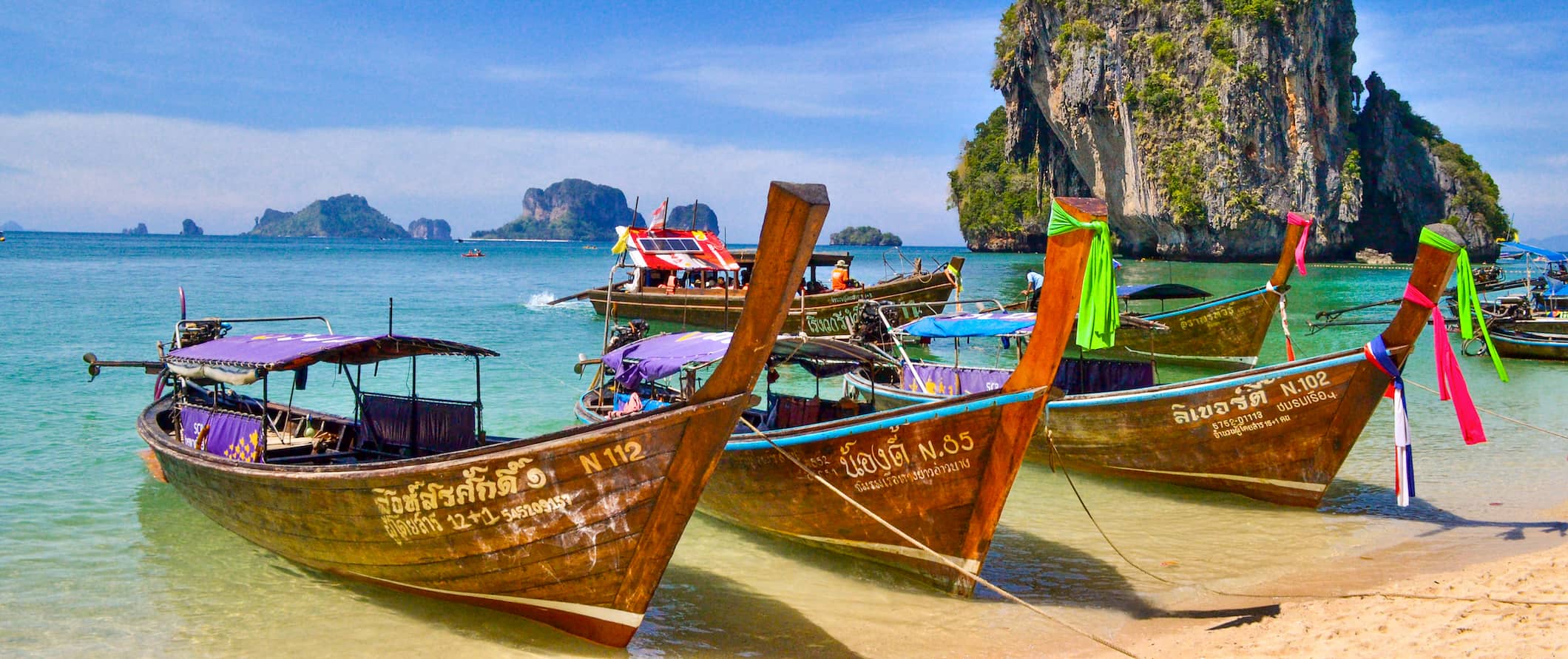
Accommodation – Accommodation in Southeast Asia is really cheap, making it the perfect place to travel if you are on a budget. Hostels are plentiful, as are budget guesthouses and hotels. It’s also very cheap to splash out here if you’re in need of some luxury.
Generally, you can find hostel dorm rooms for as little as $6-8 USD in Cambodia and $3-6 USD in Laos. In Thailand, 4-6-bed dorm rooms are $8-12 USD, while in Vietnam you can expect to pay $5-7 USD. In Indonesia, prices range between $5-10 USD for a 4-6-bed dorm room. Expect to pay at least $15-20 per night for a private room with air conditioning. Free Wi-Fi is standard in most hostels, free breakfast is common, and many hostels even have pools. In more remote areas, hot water isn’t common so make sure to check in advance if that’s an issue for you.
Simple guesthouses or bungalows throughout Southeast Asia generally cost $12-20 USD per night for a basic room with a fan (sometimes air conditioning) and hot water. If you want something nicer that includes a more comfortable bed and a TV, expect to pay $25-35 USD per night.
For backpackers, budgeting around $10 USD per night for accommodation is pretty safe no matter where you go in Southeast Asia. If you’re looking for a higher-end hotel room with more amenities, expect to pay $20-50 USD per night for a room. Anything over that is luxury territory.
Camping is available in certain areas, usually for just a few dollars per night for a basic tent plot without electricity. However, this is about the same price as hostels so it’s not really any cheaper.
Food – While each country’s cuisine varies, overall, Southeast Asian food is aromatic, spicy, and flavorful. Typical spices and herbs include garlic, basil, galangal, cilantro, lemongrass, kaffir lime leaves, chilies, and fish sauce. No matter what region you’re in, you can expect to find a variety of curries, salads, soups, noodle dishes, and stir-fries.
Rice and noodles are central to Southeast Asian food, while the meat is usually pork, chicken, fish, or seafood, which is everywhere on the islands and coastal areas.
While traveling Southeast Asia, street food is the most popular food and cheapest option. On average, these meals cost $1-5 USD. You find these stalls throughout this region lining most streets and every market. They are ubiquitous in the region. In Singapore, street food (from “hawker stands” as they’re known there) costs around $4-5 USD for a meal. Even if you go into small local restaurants, the price doesn’t increase that much.
Food that costs $2 USD at a street stall generally only costs $4-6 USD at a local restaurant. If you went into a restaurant in Thailand, you’d pay around $3-4 USD for a pad Thai that would have cost $1-2 USD on the street.
In Cambodia, street food is around $1-2 USD, while restaurants charge around $3-5 USD for a dish like amok (a coconut milk dish) or luc lac (pepper gravy beef).
Western meals, including burgers, pizza, and sandwiches usually cost around $7-10 USD. But these generally aren’t that great. If you want something that actually tastes as it does back home, expect to spend at least $10-12 USD for your meal.
While cheap, alcohol can take a bite out of your budget if you’re not careful. Those $1-2 USD beers add up! Wine and cocktails are more expensive, generally around $3-5 USD. A cappuccino is typically around $2 USD. Bottled water is plentiful and costs less than $1 USD.
There’s a growing cutting-edge foodie scene in the region and, if you want to splurge, you can do so on some really good meals. Big cities like Bangkok, KL, and Singapore, all have world-class Michelin star restaurants as well some incredible fusion restaurants.
Since dining out is so cheap in the region, there’s no point in grocery shopping unless you’re looking to get some pre-made salads or fruits. Additionally, a general lack of kitchens in most hostels and hotels makes it difficult to cook even if you wanted to. If you do purchase your own groceries, expect to spend around $25 USD per week for basic groceries like local produce, rice, and some meat (while avoiding expensive imported items like cheese and wine).
Backpacking Southeast Asia Suggested Budgets
On a backpacker budget of $45 USD per day, you can stay in hostel dorms, eat out at local markets and street stalls, limit your drinking, do mostly free activities, minimize paid activities, and use public transportation to get around. You’re not going to be able to splash out but you’ll be able to live the typical backpacker experience without really stressing over expenses.
On a mid-range budget of $85 USD per day, you can stay in budget hotels or private hostel rooms, eat more restaurant meals, do more paid activities like cooking classes, take some taxis, and enjoy a few more drinks. You won’t live large, but you won’t be missing out either.
On an upscale budget of $150 USD or more per day, you can stay in nicer hotels with more amenities, eat out as much as you want, do more paid tours including private tours, hire a driver, fly between destinations, and basically do whatever you want. The sky is the limit with this kind of budget!
You can use the chart below to get some idea of how much you need to budget daily, depending on your travel style. Keep in mind these are daily averages — some days you’ll spend more, some days you’ll spend less (you might spend less every day). We just want to give you a general idea of how to make your budget. Prices are in USD.
Southeast Asia Travel Guide: Money-Saving Tips
Backpacking Southeast Asia is cheap. There’s little opportunity to spend a lot of money since everything is already so inexpensive unless you intentionally are trying to splash out on fancy meals and high end hotels. The two reasons why most travelers end up overspending is that they eat a lot of Western food and drink way too much. If you want to save money while traveling in this part of the world, cut down on your drinking and skip the Western food. While country guides have more specific ways to save money, here are some general ways to save money in Southeast Asia:
- Stay with a local – Accommodation is cheap in Southeast Asia but nothing’s cheaper than free! Use Couchsurfing to stay with locals who have extra beds and couches for free. You’ll also meet great people who can show you around and share their insider tips and advice.
- Book tours and day trips as a group – You have more negotiation power when you’re with a group of people buying multiple spots or tickets. Traveling alone? Meet a friend at a hostel and see if they want to join the same tour as you. I’ve met some great friends over the years doing this and highly recommend it.
- Don’t book in advance – Don’t book any tours or activities before you get to your destination. They’ll be much cheaper when you arrive as you’ll be able to negotiate a lower price as you’ll find companies are often offering the same tour and competing. Anything you see online is more expensive than you need to pay!
- Eat on the street – The street food is the best food. The food is the best and cheapest you’ll find. It’s a great way to try new foods and get to chat with locals as well. This is where locals eat so if you want insight into local culture, good food, and savings, eat the street food. Look for where locals are eating to ensure that it’s safe to eat.
- Bargain hard – Nothing is ever at face value here. Bargain with sellers as most of the time, the price they’ve quoted is way higher. There’s a haggling culture in the region so play the game and save some money. It’s important not to convert it in your head to your own currency because it will usually sound cheap even though you might still be getting ripped off. You’ll never get the local price, but you might come close!
- Minimize your drinking – Drinks really add up. Even with cheap drinks, if you’re not aware, you’ll end up spending more money on beer than on food and accommodation. If you want to drink, head to the supermarkets, drink at the hostel, or check out the local happy hours.
- Pack a water bottle – A water bottle with a purifier comes particularly in handy in Southeast Asia since you can’t usually drink the tap water. Save money and thousands of plastic bottles and get a bottle that can purify the tap water for you. My preferred bottle is LifeStraw as it has a built-in filter that ensures your water is always safe and clean.
Where to Stay in Southeast Asia
I’ve been traveling Southeast Asia since 2005 and have stayed in hundreds of places. Here are some of my favorite places to stay in Southeast Asia:
- The Siem Reap Pub Hostel (Siem Reap)
- Onederz Siem Reap (Siem Reap)
- Mad Monkey Siem Reap (Siem Reap)
- Onederz Sihanoukville (Sihanoukville)
- Monkey Republic (Sihanoukville)
- Onederz Phnom Penh (Phnom Penh)
- Sla Boutique Hostel (Phnom Penh)
- The Magic Sponge (Kampot)
- Indigo House Hotel (Luang Prabang)
- Sa Sa Lao (Luang Prabang)
- Sanga Hostel (Pakse)
- Nana Backpackers Hostel (Vang Vieng)
- Dream Home Hostel (Vientiane)
- Traveller Bunker Hostel (Cameron Highlands)
- De’Native Guest House (Cameron Highlands)
- Kitez Hotel & Bunks (Kuala Lumpur)
- Sunshine Bedz Kuala Lumpur (Kuala Lumpur)
- Ryokan Muntri Boutique Hostel (Penang)
- Mad Monkey Hostel (Bangkok)
- D&D Inn (Bangkok)
- Kodchasri B&B (Chiang Mai)
- The Royal Guest House (Chiang Mai)
- Green Leaf (Khao Yai)
- Lonely Beach Resort (Ko Chang)
- The Sanctuary (Koh Phangan)
- Na-Tub Hostel (Koh Phangan)
- Pineapple Guesthouse (Phuket)
- Dream Lodge
- The Pod Capsule Hostel
- The Scarlet
- Under the Coconut Tree Guesthouse (Hoi An)
- Fuse Beachside (Hoi An)
- Pretty Backpackers House (Da Lat)
- Hanoi Old Quarter Hostel (Hanoi)
- Luxury Backpackers Hostel (Hanoi)
- The Hideout (HCMC)
- City Backpackers Hostel (HCMC)
How to Get Around Southeast Asia
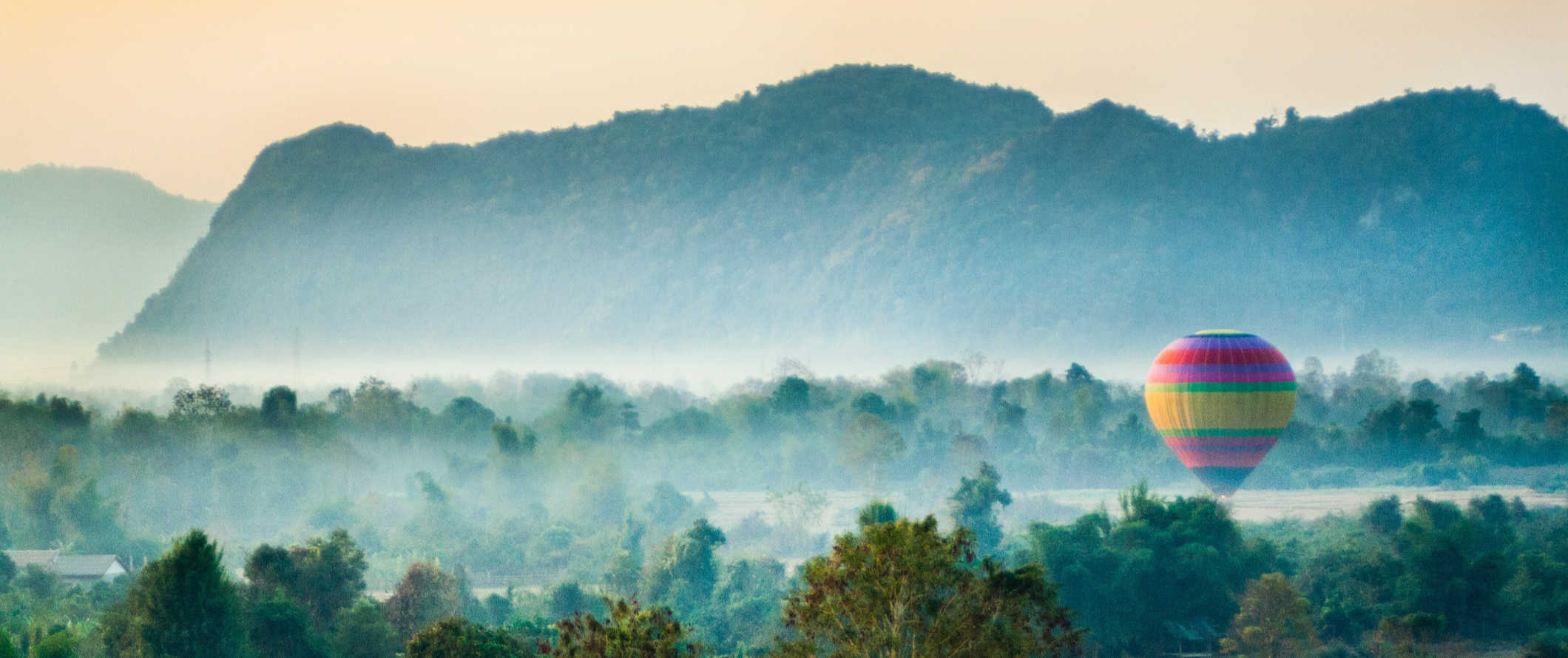
Public transportation – Public transportation costs from a few pennies to a few dollars, with Singapore and Malaysia offering the most comprehensive public transportation systems. In Thailand, local buses cost around $0.25 USD per trip, while the Metro and Skytrain in Bangkok cost $0.50-1.50 USD per trip. In Cambodia, a bus ticket in Phnom Penh costs just $0.40 USD per ride.
Major cities generally have subway systems but mostly you’ll be using the bus or shared taxis to get around.
Tuk-tuks (small, shared taxis with no meter) are available around much of the region and require a bit of haggling. They usually have 3-6 seats and generally cost more than public transportation but are faster. To find a reputable driver, ask your accommodation as they usually know someone. Tuk-tuk drivers can often be hired for the day for a discounted rate (this is what a lot of people do to visit the Killing Fields and Angkor Wat in Cambodia, for example).
Taxi – Taxis in the region are generally safe, though it’s not uncommon to have to haggle. Scams to rip you off aren’t uncommon either, so always ask your accommodation to call you a taxi whenever possible so you know you’ll get a reputable company.
In Singapore and Indonesia, taxi drivers do put on the meter. In Bangkok, you can get taxi drivers to use the meter, but if you’re hailing one in a tourist area, he might try to avoid using it. In Vietnam, the meter is sometimes rigged, but if you can get a reputable company like Mai Linh, you won’t have any problems.
Ridesharing – Grab, DiDi, and Gojek are Asia’s answer to Uber. They work the same way: you hire a driver to take you somewhere via the app, and you can pay via the app or in cash. It’s often more affordable than a regular taxi, though drivers are a bit unreliable as the practice is not as widespread here as in other parts of the world.
Just keep in mind that some drivers are driving motorcycles so be sure to double check what kind of vehicle is picking you up if you don’t want to ride on the back of one.
Bus – The easiest and cheapest way to travel around Southeast Asia is by bus. The backpacker trail is so worn that there is a very well-established tourist bus system to take you anywhere. Buses costs vary between $5-25 USD for a 5-6 hour journey. Overnight buses cost $20-35 USD depending on distance (they often have reclining seats so you can get a decent sleep).
You can check ticket prices and book tickets for all the different bus companies across Southeast Asia at 12go.asia.
Train – Train service is limited in the region and not something to really consider when you travel Southeast Asia. You can take a train up and down the coast of Vietnam and there’s some limited scenic rails in Malaysia. Thailand is the only country that has an extensive train system that lets you travel all its regions (and onward to Singapore) from Bangkok.
The train prices in Southeast Asia are determined by distance and class. Night trains with sleeper cars are more expensive than day trains. The night train to Chiang Mai from Bangkok takes twelve hours and costs $27 USD for a sleeper seat. However, that same train during the day is $8-9 USD. In Vietnam, trains run up and down the coast and cost $60 USD from Hanoi to Ho Chi Minh City.
Flying – The cost of flying around Southeast Asia has come down in recent years due to the rise of low-cost airlines. Scoot, Jetstar, and AirAsia are the biggest. Nok Air has a lot of flights within Thailand , and VietJet Air is popular in Vietnam . Lion Air serves Indonesia , but its safety record is really spotty and I personally would not fly them. If you book early, you can save on fares, as most of the airlines offer deeply discounted fare sales all the time, especially Air Asia.
Just make sure that the airport these budget airlines fly into isn’t too far out of your way (transportation from the secondary airport sometimes negates the savings from using the budget airline itself).
Also, keep in mind that you usually must pay to check your baggage on these cheap flights. If you wait to pay for your luggage at the gate, you end up paying almost double. Travel carry-on only to avoid this added cost.
All in all, I only recommend flying if you are pressed for time or find a super cheap deal. Otherwise, stick to the bus.
Hitchhiking – Hitchhiking in Southeast Asia is safe, though popularity of the practice varies by country (it’s more common in Malaysia, but not so much in Cambodia). Dress respectably, smile while making eye contact with drivers, and use a cardboard sign to tell people where you’re headed. Be prepared for long bouts of no pick-ups, especially if you’re traveling through more rural areas. Pack plenty of water and food. Also, make sure the people picking you up understand you’re hitchhiking and not flagging down a taxi.
Hitchwiki is a great resource for hitchhiking tips.
Car rental I don’t recommend renting a car in Southeast Asia. Rental cars are expensive ($40 USD per day or more) and the roads here are in poor shape. I would never drive around the region.
When to Go to Southeast Asia
The best time of year to visit Southeast Asia is from November to April when temperatures are milder (though temperatures vary drastically by region). It may be mild in Thailand in January and hot in Malaysia but in Northern Vietnam, it’s cold! Also, one of the biggest mistakes people make is not taking into account the rainy season. In some cases it won’t make a big difference but definitely does if it’s a beach trip.
In Indonesia, the best time to visit is April to October. Temperatures average 24-30ºC (75-86ºF), and the weather is mostly dry. July to September is the peak holiday season and when you can expect to pay the highest rates. December to February is the rainy season.
In Malaysia, January-March and June-September are the best time to visit, as these months have the lowest average rainfall. It is still hot and humid during this time though. The rainy season is from October to December. Singapore’s climate/weather is much like Malaysia’s.
In Vietnam, the weather varies by region. In Central Vietnam (including Hoi An and Nha Trang), January-May is the best time to visit because it is dry and the temperatures average 21-30°C (70-86°F). June to August is also a decent time to visit. If you want to stick around Hanoi, March to April is great, or October to December (for mildest temperatures). The rainy season is May-September.
Thailand has three seasons: hot, hotter, and hottest. It’s always warm, though the weather is nicest between November and February (which is also peak tourist season). Bangkok is “coolest” and driest during this time (but still averaging a hot 29°C/85°F each day). April and May are the hottest months, and the rainy season is June-October. The gulf islands get pretty rainy from August to December.
The dry season in Cambodia is from November-May and the cool season is from November-February (and when most people visit). Temperatures during this time are still high, but humidity is lower. Laos has the same cool season as Cambodia, with the dry season running from November-April.
In the Philippines, it’s mostly warm all year long with an average daily high of 26°C (80°F). There are rainy and dry seasons and temperatures are hot and dry from March-May and cooler December-February. The best time to visit is between January-April when it’s less humid. Monsoon Season is July-October.
For more information on when to go to places, visit the specific country guides.
How to Stay Safe in Southeast Asia
Southeast Asia is an incredibly safe place to backpack and travel — even if you’re traveling solo and even as a solo female traveler. Violent crime is super, duper rare. Petty theft (including bag snatching) is the most common type of crime in Southeast Asia, especially around popular tourist landmarks. Always keep your valuables out of reach on public transportation and in crowds just to be safe. Never leave your valuables unattended while at the beach and always keep a hold of your purse/bag when out and about as bag snatching is common.
That said, outside touristy areas, theft is really rare. Heck, it’s pretty rare in touristy areas too! But a little vigilance goes a long way and it’s better to be safe than sorry.
There are some common scams around that you’ll want to be aware of, such as the motorbike scam. This involves a bike rental company trying to charge you for damage to the bike that you didn’t cause. To avoid this, always take photos of your rental before you leave so you can protect yourself from baseless claims.
Another common scam involves a tuk-tuk driver taking you somewhere you didn’t want to go in hopes you’ll buy something from the shop/restaurant he dropped you off at (he gets a commission if you do). Simply refuse to buy anything and demand to go back to where you were — or find another driver.
For other common travel scams, read this post about major travel scams to avoid in the region .
Solo female travelers should feel safe here, though it’s generally a good idea to avoid walking around alone at night just to be safe. It’s always a good idea to carry some extra cash to get home in a taxi if you need to. Additionally, always keep an eye on your drink at the bar and never accept drinks from strangers. Be sensible when it comes to dating while traveling and meeting people in public places. As I’m not a woman, please check out some solo female travel blogs to get the best insight.
Overall, the people who get in trouble here tend to be involved with drugs or sex tourism. Avoid those two things and you should be fine. Keep in mind that it’s not always obvious how old someone is or if they’re a sex worker so be mindful when getting involved in romantic interactions. Also, penalties for drug use in this region are stiff so even if you’re here to party, skip the drugs.
Always trust your gut instinct. Make copies of your personal documents, including your passport and ID. Forward your itinerary along to loved ones so they’ll know where you are.
For more in-depth coverage of how to stay safe in Southeast Asia, check out this post that answers some frequently asked questions and concerns.
The most important piece of advice I can offer is to purchase good travel insurance. Travel insurance will protect you against illness, injury, theft, and cancellations. It’s comprehensive protection in case anything goes wrong. I never go on a trip without it as I’ve had to use it many times in the past. You can use the widget below to find the policy right for you:
Southeast Asia Travel Guide: The Best Booking Resources
These are my favorite companies to use when I travel. They consistently have the best deals, offer world-class customer service and great value, and overall, are better than their competitors. They are the companies I use the most and are always the starting point in my search for travel deals.
- Skyscanner – Skyscanner is my favorite flight search engine. They search small websites and budget airlines that larger search sites tend to miss. They are hands down the number one place to start.
- Hostelworld – This is the best hostel accommodation site out there with the largest inventory, best search interface, and widest availability.
- Agoda – Other than Hostelworld, Agoda is the best hotel accommodation site for Asia.
- Booking.com – The best all around booking site that constantly provides the cheapest and lowest rates. They have the widest selection of budget accommodation. In all my tests, they’ve always had the cheapest rates out of all the booking websites.
- Get Your Guide – Get Your Guide is a huge online marketplace for tours and excursions. They have tons of tour options available in cities all around the world, including everything from cooking classes, walking tours, street art lessons, and more!
- SafetyWing – Safety Wing offers convenient and affordable plans tailored to digital nomads and long-term travelers. They have cheap monthly plans, great customer service, and an easy-to-use claims process that makes it perfect for those on the road.
- LifeStraw – My go-to company for reusable water bottles with built-in filters so you can ensure your drinking water is always clean and safe.
- Unbound Merino – They make lightweight, durable, easy-to-clean travel clothing.
Get the In-Depth Budget Guide to Thailand!

My detailed 350+ page guidebook is made for budget travelers like you! It cuts out the fluff found in other guidebooks and gets straight to the practical information you need to travel around Thailand. You’ll find suggested itineraries, budgets, ways to save money, on and off-the-beaten-path things to see and do, non-touristy restaurants, markets, bars, safety tips, and much more! Click here to learn more and get your copy today.
Southeast Asia Travel Guide: Related Articles
Want more info? Check out all the articles I’ve written on Southeast Asia travel and continue planning your trip:

The 4 Best Hostels in Singapore
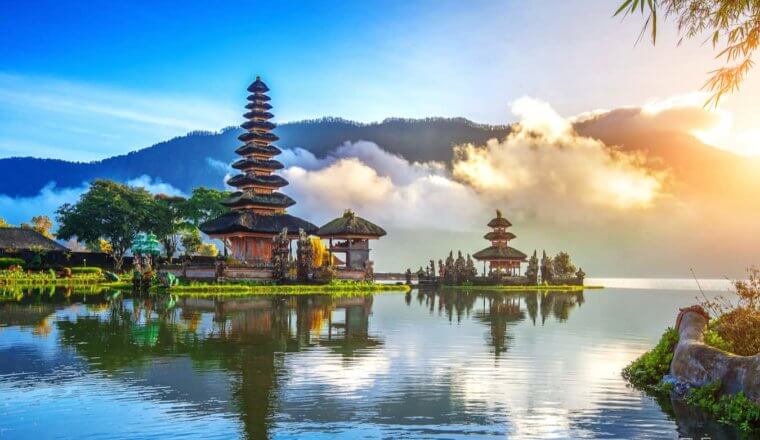

The 6 Best Hostels in Bali
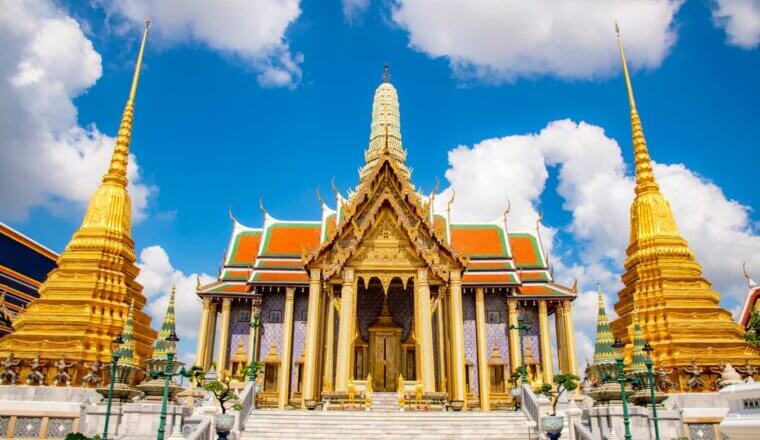
The 22 Best Things to Do in Bangkok
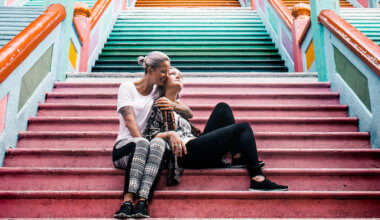
5 LGBTQ Travel Tips for Asia

Is Southeast Asia Safe for Travelers?
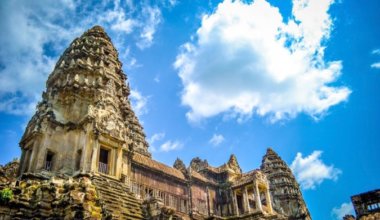
Backpacking Cambodia: 3 Suggested Itineraries for Your Trip
Get my best stuff sent straight to you, pin it on pinterest.
- Where To Stay
- Transportation
- Booking Resources
- Related Blogs

One Month in Southeast Asia: Itinerary + Planning Insights
- August 22, 2019
- Affordable Travel , Art & Culture , Asia , Cambodia , China , City Escapes , Itinerary Inspiration , Laos , Luxury Travel , Road Warriors , Thailand , Travel Tips + Planning , Vietnam , Wildlife & Nature
- 10 Comments
Inspiration for a Luxurious Month in Southeast Asia’s Hotspots
UPDATE (July 2020): We are back from an incredible trip exploring some of Southeast Asia’s most famous cities, towns, and natural wonders. Below you’ll find links to our completed adventures as well, with some highlights and takeaways!
I typically begin sharing about our fall adventure earlier in the year but this season got away from me. The countdown is officially on and we’re departing in two weeks for a bucket list trip that I’ve been dreaming about for over a decade. Southeast Asia has made our shortlist conversation every year when we debate how to spend our month away in the fall. It’s an area that really requires enough dedicated time to make any sort of dent and with the luxury of a bit of time on our side, we’ve always brainstormed what a month in this magnetic region would look like. After months – well, years, in some ways! – of giving thought to our perfect itinerary, we’re there. Below, I’m sharing our itinerary for one month in Southeast Asia, plus some planning insights and booked tours and experiences. Many of the itineraries that I’ve found online for a trip this length skew towards the backpacking/hosteling bunch so if you’re looking for a more luxe take on a similar itinerary (which, by the way, is still a great value in the scope of global travel), I hope this is helpful!
Shanghai, China {3 Nights}

HOTEL: Shanghai EDITION {Bookable through Marriott Bonvoy points}
My sister just moved to Shanghai so we’ll be kick-starting our adventure with three nights in Shanghai to visit her in her new home town while we acclimate to our new time zone. For beginning your trip in the region, major airports include Bangkok, Hong Kong and Singapore as well, with many direct flights from the US. Singapore Air recently announced its Newark – Singapore direct flight, and there are direct flights to Hong Kong available from many major US cities including LA, Dallas, New York, and San Francisco.
During our three nights in Shanghai, we’ve booked a couple of swanky dinners, rooftop lounges for drinks with a view, and a breakfast tour through Shanghai with Untour Food Tours . More details on our three days in Shanghai forthcoming – after we depart! – plus I’ll be sharing a full post on our food tour as well.
TIP 👉🏼 Traditionally American citizens require a visa to enter China. There are a few exceptions to this though for shorter stays. Recently, China has changed the policy to allow 72 hours visa-free in a selection of cities and up to 144 hours in some other major cities. If you’re going this route, plan on having your exit flight details printed to show upon entry.
READ MORE ON OUR ADVENTURES IN SHANGHAI ✧ A Breakfast Tour Through Shanghai • Visiting Shanghai through China’s Visa Free Transit Program
Chiang Mai + Golden Triangle, Northern Thailand {6 nights}
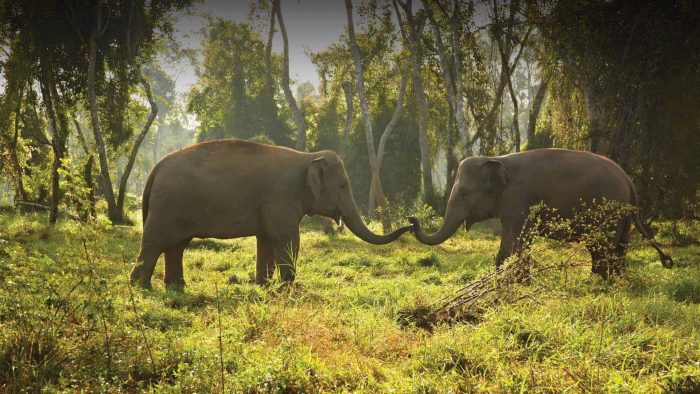
HOTELS: 137 Pillars House (Chiang Mai) + Anantara Golden Triangle (Chiang Rai/Border Region)
From Shanghai, we begin the core of our adventure in Southeast Asia, starting in Northern Thailand. One of the major pieces in decision-making in terms of mapping out this itinerary was the way in which flights would work to be most sensible. When possible, I wanted one flight – no connections – between cities so we wouldn’t be wasting too much time in transit. We’ll be flying China Eastern from Shanghai to Chiang Mai direct (booked on AirFrance points, which is a great value if you have a Chase Sapphire card). We’ll have three nights in Chiang Mai including one day with a private guide (I’ll share more about that in forthcoming specific posts). Our time in Chiang Mai is followed by three nights at Anantara’s Golden Triangle Elephant Camp & Resort where we’ll be touring the three countries (Laos, Thailand and Myanmar), enjoying a bit of pampering, and delving into some elephant learning experiences.
NOTE: We have the luxury of time during our one month in Southeast Asia. If your time is more limited, you could combine Chiang Mai + Chiang Rai into a more condensed window. Many people do a day trip to Chiang Rai from Chiang Mai for a brush with the elephants. Also note that we exclusively opted to focus on Northern Thailand during our time in the region. We live in a beach destination so the beach scene further south wasn’t as compelling for us. Your itinerary and time in Thailand may look different from this if you prefer the Thai beach scene to the jungles and temples in the north.
TIP 👉🏼 Tourist visas for Thailand are granted upon arrival for a 30-day period for US citizens. A number of visa points require a passport-sized photograph for entry. We each have 4 photos prepared for entries just in case! Again, in this instance, I’m keeping physical printouts of all ongoing flights to show departure information in case required.
READ MORE ON OUR ADVENTURES IN CHIANG MAI ✧ Three Days in Chiang Mai • HOTEL INSIDER: A Stay at 137 Pillars House, Chiang Mai
READ MORE ON OUR ADVENTURES IN THE GOLDEN TRIANGLE ✧ HOTEL INSIDER: A Stay at Anantara Golden Triangle Elephant Camp & Resort • Delving into Anantara’s Elephant Encounters • A Three Country Tour with Anantara
READ MORE ON OUR ADVENTURES IN MYANMAR ✧ A Three Country Tour with Anantara
Luang Prabang, Laos {4 nights}

HOTELS: Luang Say Cruise (1 Night, Downriver), Belmond La Résidence Phou Vao (Luang Prabang)
From Vietnam, we head downriver to Laos. Getting to Luang Prabang was one of our biggest question marks in this process but we knew that if possible, we’d prefer to skip the airport scene and opt for a more peaceful route. Flying from Chiang Rai or Chiang Mai would involve a layover in Bangkok and kill too much precious time with layovers and in airports. Instead, we opted to cruise downriver from the Golden Triangle to Luang Prabang on a 2 day/1 night cruise with Luang Say (they also have a hotel in Luang Prabang if you want to combine those offerings). The cruise includes a stop in a traditional Laotian village, an overnight in Pakbeng at their accommodation, and then a stop at the Pak Ou Caves. Some of our interest in Laos generally was in visiting some smaller villages so this cruise is acting as transport, lodging, and sightseeing for us on this overnight.
From there, we’ll spend three nights in Luang Prabang at Belmond’s La Résidence Phou Vao. Our days include the morning Alms Giving Ceremony, a trip to Kuang Si Waterfalls and Bear Sanctuary, plus some sightseeing and temple visits in town.
TIP 👉🏼 Coordinating the cruise from the Golden Triangle to Luang Prabang was the biggest difficulty of the entire planning process. As you’d imagine, many of the cruises depart on specific days depending on whether you’re going upriver or downriver and depending on the season. Even after planning our schedule to accommodate for this we found that many of the boat operators wouldn’t take our booking as we were just two people and no one else had yet booked for our required day. A minimum of 4 people is generally required for the boat to go. I asked about paying more to compensate for being a lighter load but that wasn’t a viable option. I also asked about putting my name on a list so if other queries were to come through we could join forces to get a boat moving. Again, no luck with any operators. We were turned down flatly in almost every instance. As time drew closer and I began investigating flights I reached out to Luang Say yet again in my last-ditch attempts to finagle my way on to a cruise. As luck would have it, it was operating and we were able to get on board. All that to say that this requires coordination and you shouldn’t bank on being on a cruise until you are actually confirmed by the company. Also don’t be afraid to continue reaching out to verify options. If you’re a group (4+ people) this should be an easier proposition.
As far as visas are concerned, the Lao government issues visas on arrival for 30-day stays. A passport-sized photo is required and $30 – $42 for the visa fee is due upon arrival.
READ MORE ON OUR ADVENTURES IN LAOS ✧ Cruising to Laos Aboard the Luang Say • Exploring Luang Prabang with Orange Robe Tours • ITINERARY INSPIRATION: Three Days in Luang Prabang
Vietnam – North to South {13 nights}
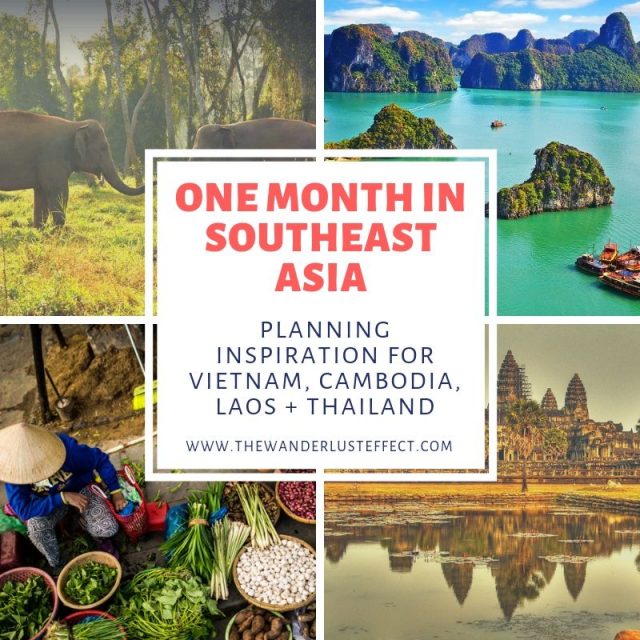
HOTELS: O’Gallery Premier Hotel & Spa (Hanoi), Indochina Junk (Halong + Bai Tu Long Bay), Little Riverside (Hoi An), Le Meridien Saigon (Ho Chi Minh City)
In some ways Vietnam is the core of our trip. It was the anchor when we started our planning and it’s also where we’ll end up spending the most time over the course of our month in Southeast Asia. Vietnam’s makeup, being long and skinny, means that travel times between cities can require flights as going overland can take days to make a given journey.
We’re starting our time in Vietnam in Hanoi where we’ll have three nights, allowing us to enjoy a walking tour, the night market, a vegetarian street food tour and more. From there, we’ll be transferred to the starting point of our Indochina Junk cruise which provides us 2 days and 2 nights touring Halong Bay and Bai Tu Long Bay. Halong Bay is undoubtedly the most famous trip for visitors to the region but many friends who’ve visited encouraged us to add-on the additional night to get out to Bai Tu Long Bay where it’s more peaceful and clean, and where fewer tourists go on traditional trips. There are a range of operators for boating near Halong Bay, but we chose Indochina Junk because their boutique voyages appealed to us immediately with offerings like morning Tai Chi on the deck and plush staterooms.
We’ve pre-arranged transfers from our boat completion point to Cat Bi Airport (HPH) where we will catch a flight to Hoi An (Da Nang Airport) where we have 3 nights based at Little Riverside. We’re slated to spend two days in Hoi An exploring and have pre-booked a cycling adventure to My Son with Grasshopper Adventures for one of our days.
After three nights in Hoi An, we catch our final flight within Vietnam to Ho Chi Minh City where we’ll complete our time with three nights based at Le Meridien Saigon (bookable through Marriott Bonvoy points at a decent value). We’ll be doing some requisite tours in HCMC like the Cu Chi Tunnel Tour, but I’m most excited for our evening excursion with XO Tours where we’ll be jumping on motorbikes with a female-led team to eat our way through Saigon!
Click here for the Beginner’s Guide to Vietnam .
HOMEWORK: If your knowledge of Vietnamese history is a bit muddled, I’d highly recommend the docuseries that we’ve been watching on Netflix simply titled, The Vietnam War . It’s an 18-hour documentary done over 10 episodes and it’s incredibly dense and super informative; an amazing primer before your trip!
TIP FOR VIETNAM VISAS 👉🏼 Vietnam is the one country that we needed to apply for visas in advance. Starting in Hanoi, we’re eligible for visas on arrival as US citizens as we’re coming in by air to a designated port. Those coming in by sea (on a cruise for example) would need to apply for visas in advance of arrival. A Visa on Arrival still requires a visa approval letter . The process is simple enough: you’ll send in your details, pay a processing fee, and receive a document to print and show at the border when you arrive. The Vietnam visa costs $25 payable at the border if you go this route (the visa approval letter fee is additional).
READ MORE ON OUR ADVENTURES IN VIETNAM ✧ Exploring Halong and Bai Tu Long Bay with Indochina Junk • Cycling the Hoi An Countryside with Grasshopper Adventures • A First-Timer’s Guide to Tailor-Made Clothing in Hoi An • Exploring Saigon’s Food Scene by Motorbike with XO Tours • ITINERARY INSPIRATION: Two Weeks in Vietnam
You can do this easily through iVisa – the cost is $20 per person (10% off through September 15th with this link ). See if you’re required to obtain a visa:
Siem Reap + Angkor Temples {4 nights}

HOTEL: Jaya House River Park (Siem Reap)
We’re ending our month in Southeast Asia with a bang by visiting Angkor Wat, one of the seven wonders of the world and the largest religious monument on the planet. Flights from Ho Chi Minh City to Siem Reap are readily available. We’ll be flying on Cambodia Angkor Air, which we booked directly through their site. When we began brainstorming our trip, Vietnam and Cambodia were the core of what we wanted to experience. A visit to Siem Reap has been on my wish list for what seems like eons and I think it’ll be a special ending to a whirlwind experience in the region. We’ve carved out four nights for Siem Reap and in addition to visiting the temples a couple of days, we’ve shortlisted a visit to the APOPO Center (to see the HeroRATs in action) and the Phare Circus (a Cirque du Soleil type offering).
There are many great hotels to choose from in Siem Reap, but we wanted something boutique-y and unique and opted for Jaya House River Park, which has an associated NGO supported through the property.
TIP 👉🏼 Cambodia also offers a visa-on-arrival program if you’re arriving into Siem Reap (or Phnom Penh) and as with the other visa processes, you’ll want to have a passport-sized photograph ready upon arrival to expedite the process.
READ MORE ON OUR ADVENTURES IN CAMBODIA ✧ Exploring Temples in Siem Reap • Siem Reap ⏤ A Taste of Jaya Discovery • ITINERARY INSPIRATION: 4 Days in Siem Reap
If you’re planning one month in Southeast Asia, this itinerary could take many forms and much of how you edit down your itinerary will be a reflection of what you prioritize personally when you travel. A month seems like a lot of time but you’ll find that the days slip away quickly when you’re trying to incorporate all of your highlights in a region this large. Transit time is something to consider as well, and that reality helped shape this itinerary in part. Where we could cut out time in airports or limit time on planes, we worked on planning to make that happen. With time constraints, we had to skip southern Thailand entirely, had to cut out Sapa in Northern Vietnam, and had to opt out of visiting the town of Pai, a hippie enclave in Northern Thailand that visitors rave about. Across the board, we opted for around three nights per city, which we hope will at least give us a taste of each area. For anyone else working on a more luxe take on a month in Southeast Asia, I hope this is useful for planning! Please feel free to drop any recommendations, questions, or insights in the comments below!

More about Shannon Kircher
Shannon Kircher is the founder and editor of The Wanderlust Effect. Founded in 2009, she has continued to document her international escapes as an expat in Europe and the Caribbean. Additionally, Shannon is the founder of Compass & Vine, a luxury boutique travel design firm, and is the Director of Marketing for the Frangipani Beach Resort. Shannon holds an MSc in Social Policy and Development from the London School of Economics and is a current candidate for WSET Level 3 in Wines & Spirits.
Related Posts

ITINERARY INSPIRATION: Three Days in Cairo
October 5, 2018

HOTEL INSIDER: A Stay at Gibb’s Farm, Tanzania
February 9, 2021
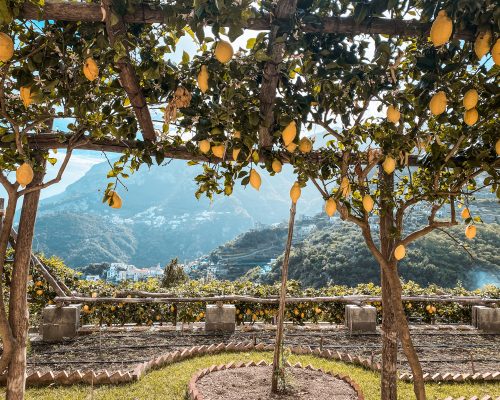
Planning for Italy: Understanding the Amalfi Coast
April 26, 2022
- Skip to primary navigation
- Skip to main content
- Skip to primary sidebar

Destinations
Experiences.
- Photography
Plan Your Trip
Southeast asia starts here.
Coming up with a 2 month Southeast Asia itinerary is hard, no matter how well you know the region. For starters, it’s as much about choosing where you don’t want to go as it is deciding the places you will visit. Then, there’s sequencing and timing, and all the rest of the practical matters that planning any trip entails.
Although I have nearly 15 years of experience traveling in Southeast Asia, I’ve decided not to construct a post that dictates or preaches to you. Rather than telling you where to go, for example, or how long (necessarily) you should spend there, I want to inform and inspire you to create the trip that’s right for you.
Even if you’re feeling anxious now—trust me, I’ve been there—you’ll soon have a plan your can easily execute. Can’t you almost smell the Pad Thai noodles sizzling through the streets?
Practical Matters
When to visit southeast asia.
In most of Southeast Asia, the dry season takes place between about December and March. As a general rule, this is when you should plan this trip, although there are a couple exceptions. First, if you plan to travel heavily or primarily in Indonesia (where the dry and rainy seasons are “flipped” compared to the rest of Southeast Asia), you’ll actually want to visit between about June and September. Secondly, you should be aware that northern parts of Myanmar, Laos and Vietnam can be relatively cold at this time of year, in spite of also being dry.
Where to stay in Southeast Asia
As you plan your Southeast Asia itinerary (2 months or longer), you’ll be delighted to learn that accommodation in most of the region is extremely affordable. There are some notable exceptions to this—Singapore is outrageously expensively; Bangkok and Kuala Lumpur are not nearly as cheap as they used to be—but as a general rule, your money goes farther here than it will anywhere else in the world.
- Traveling in Thailand ? While no longer as cheap as it used to be, this is still an affordable place to get a fancy hotel, particularly in Bangkok with high-end properties like Sofitel SO/Bangkok and the Eastin Grande Sathorn . In the islands, accommodations run the gamut from luxurious Rayavadee in Krabi ‘s gorgeous Railay , to simpler digs such as Casa Blanca Boutique Hotel in Phuket Town . Headed up north? I absolutely love the Riverside Guest House in Lampang .
- In my opinion, Vietnam (at least when it comes to hotels) is how Thailand was 10-15 years ago. From Hotel des Arts in Saigon to Hanoi ‘s chic Meritel , and from resort-style properties like Sin Chai Ecolodge in Sapa and Ancient House Resort & Spa in Hoi An , your money goes farther in Vietnam than it does in almost any other Southeast Asian country, in spite of Vietnam’s rapidly increasing popularity.
- As you explore underrated Malaysia , make sure to avail this country’s impressive selection of impressive hotels. From the five-star Majestic Hotel in Kuala Lumpur , to boutique properties like Cheong Fatt Tze in Penang and Ranee Boutique Suites in Kuching , Malaysia tends to be somewhere between Vietnam and Thailand in terms of price, although (if I’m honest) the subtler elegance of its hotels is often preferable, at least for me.
- I’ll be frank: Singapore is simply not a budget travel destination. You can make it into one— Atelier Chinatown is great if you don’t mind sharing your sleeping and bathing space; the Hotel 1888 Collection is bare-bones, but has private facilities—but you really need some cash to enjoy Singapore to the fullest. Not necessarily the sheer opulence of the Fullerton Hotel , mind you, but if you can splurge on (for example) the The Scarlet , your experience will be much more pleasant.
How to get around in Southeast Asia
Infrastructure in Southeast Asia has vastly improved over the time I’ve been traveling there, especially within cities. Still, the easiest (and often cheapest) way to navigate this region is by plane, usually (but not exclusively) using low-cost carriers such as AirAsia. If you’re unsure of how to get from place to place, I personally find that 12Go is a great tool for both research and booking.
Money, costs and communication
Another thing that’s vasty improved in Southeast Asia over the years? Money and payments. Specifically, being able to use credit cards (even though, as time passes, QR payments are definitely the most common ways to pay here). At the same time, you’ll likely need a bit of cash on you in most places—and unfortunately, every country uses different currency, which can complicate things. The good news is that airport exchange counters tend to offer competitive conversion rates, and low commissions, so you can change money either before you depart one place, or after you arrive in another.
Cost-wise, Southeast Asia is cheap, albeit not as cheap as it used to be. You can expect to pay around 50-100 USD per person, per day in most countries for modest private rooms, 2-3 meals per day and all your local transportation. While there’s technically no limit to how much you can spend, I find it difficult to go much beyond 200 USD per person, per day in most places, unless you’re simply trying to be extravagant.
Communication-wise, in a literal sense, English is all you need in most places, and certainly in countries like Singapore, the Philippines, Myanmar and Malaysia, where it’s an official language. In terms of communicating figuratively, WiFi is plentiful in Southeast Asia, though I do recommend staying connected via your mobile—either buy buying local SIM cards, or using a global travel plan like Google Fi —to make your life easier.
Visas for Southeast Asia
If you’re reading this page in English, you probably come from the US, UK, Canada, Australia, New Zealand or somewhere in Europe. If this is the case, congratulations: You can access most of Southeast Asia visa-free! I say “most” because there are notable exceptions: Indonesia, Myanmar, Laos and Cambodia require e-visas or visas on arrival, while Vietnam still requires you to apply for a visa in advance. If you’re unsure as to whether you require a visa to enter any country, contact the embassy or consulate of that nation in your place of citizenship.
Where to Go With 2 Months in Southeast Asia
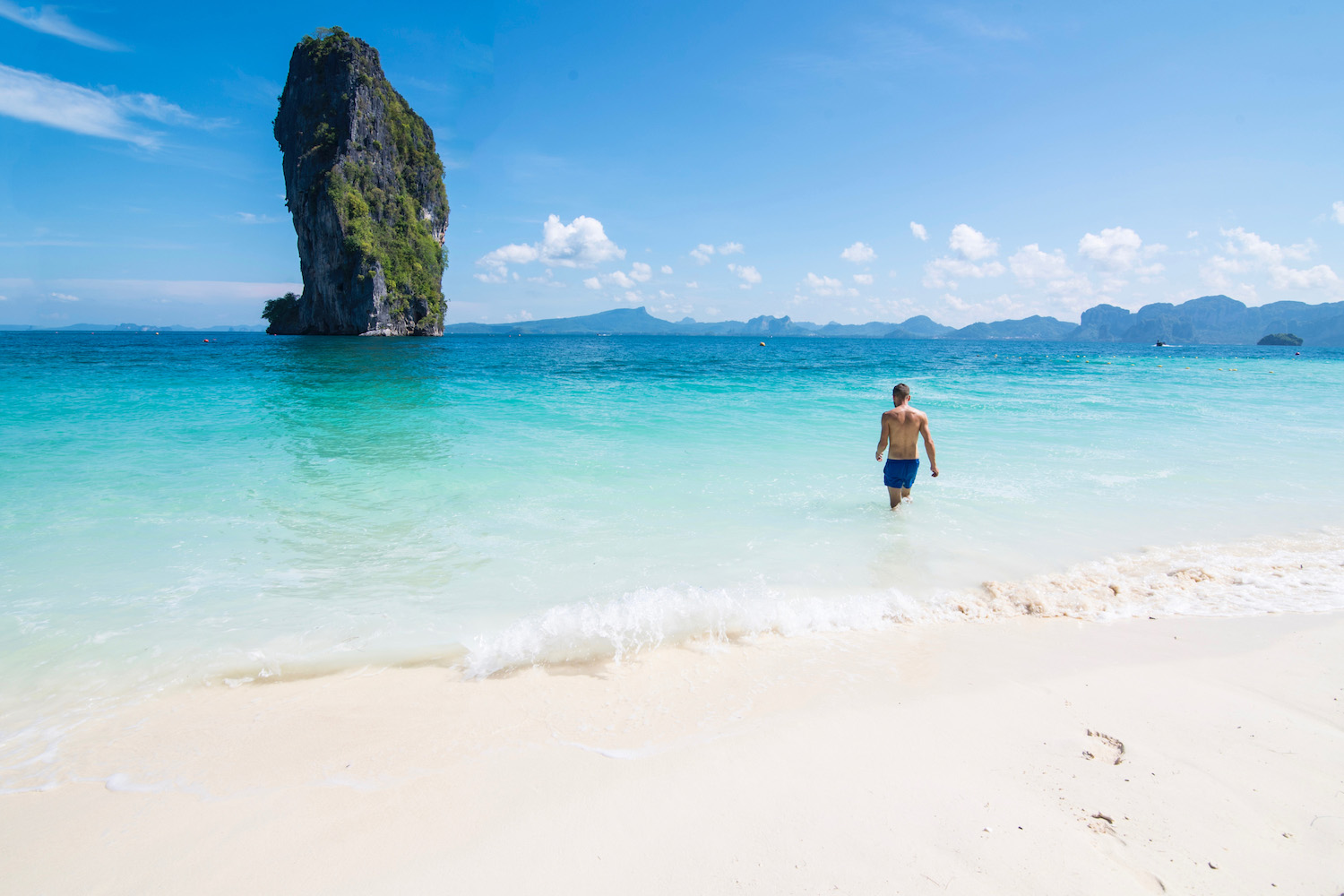
No matter how extensive your Southeast Asia travel route—2 months, or something much shorter—you absolutely have to visit Thailand . Bangkok , in addition to being the de-facto hub of Southeast Asia, is one of the world’s most dynamic cities. Beyond this, you can divide your time between the Kingdom’s lush north (focus on the cities of Chiang Mai and Chiang Rai , plus Lampang ) and the various islands and archipelagoes that define its south, from Samui , Tao and Pha Ngan islands in the Gulf of Thailand , to Phuket , Krabi and Trang in the Andaman Sea .
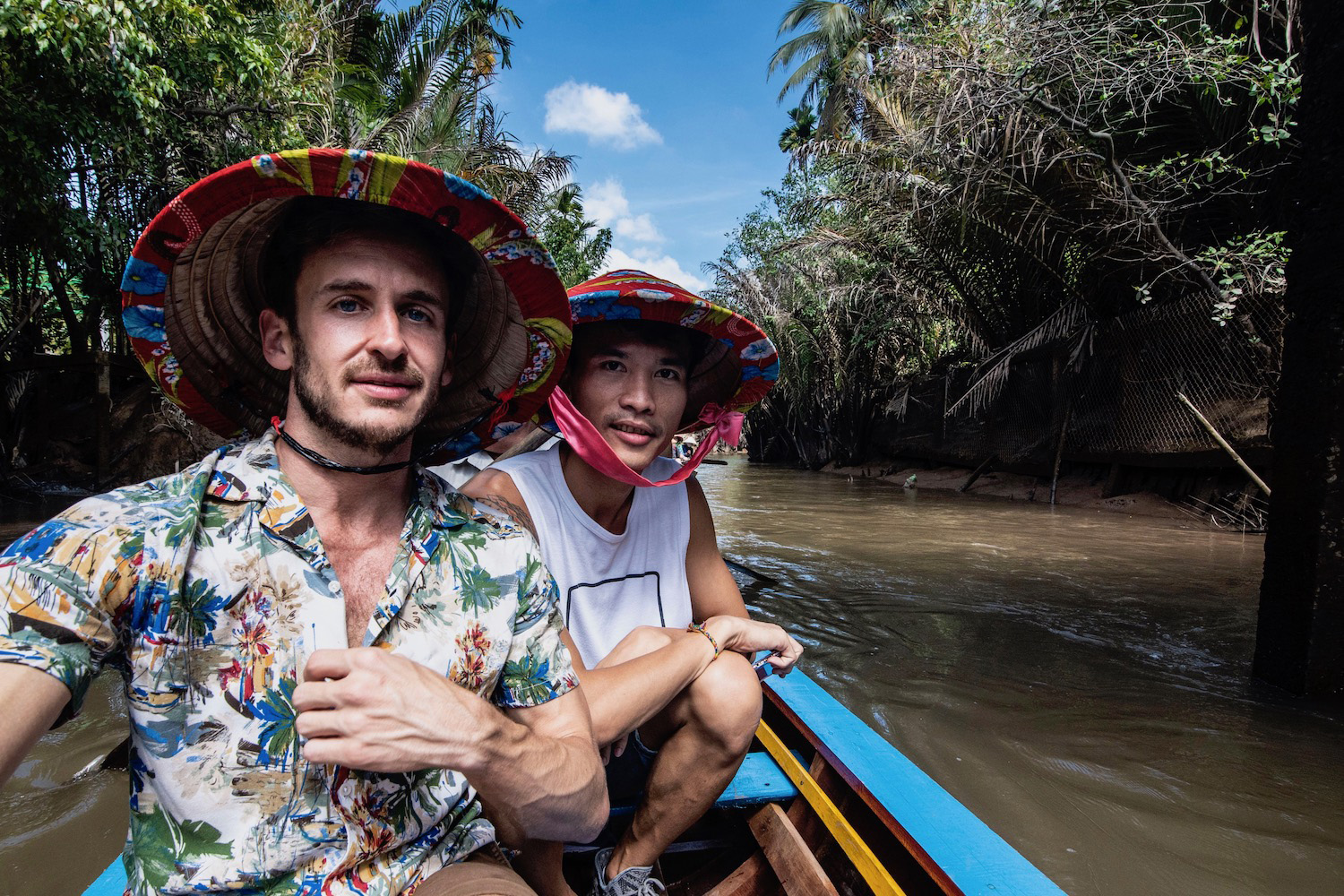
Another giant you can’t avoid during your 2 month Southeast Asia itinerary is Vietnam . I sort of consider Vietnam a wilder and more unruly Thailand, somewhat resembling an older version—maybe 10, 15 years—of the Kingdom. I usually like to go south-to-north, but you can reverse this order if you prefer. Begin in Saigon (aka Ho Chi Minh City ) and the Mekong Delta , heading northward to Da Nang (via coastal Mui Ne or Nha Trang , or hilly Da Lat ). Explore ancient Hoi An and imperial Hue , before heading north to the capital of Hanoi , scenic Ha Long Bay and finally to Sa Pa , which is rich with waterfalls and rice terraces.

Malaysia might just be the most underrated country you visit during your 2 months in Southeast Asia. While I go back and forth on the capital city of Kuala Lumpur , it’s impossible to deny the charm of Penang and its historical shophouses, or of Kuching , which sits on the edge of the rainforest. Visit tea plantations in the Cameron Highlands , scale Mt. Kinabalu in Borneo ‘s Sabah state or visit crystal mosques and some of Asia’s best islands in Terengganu on the east coast.
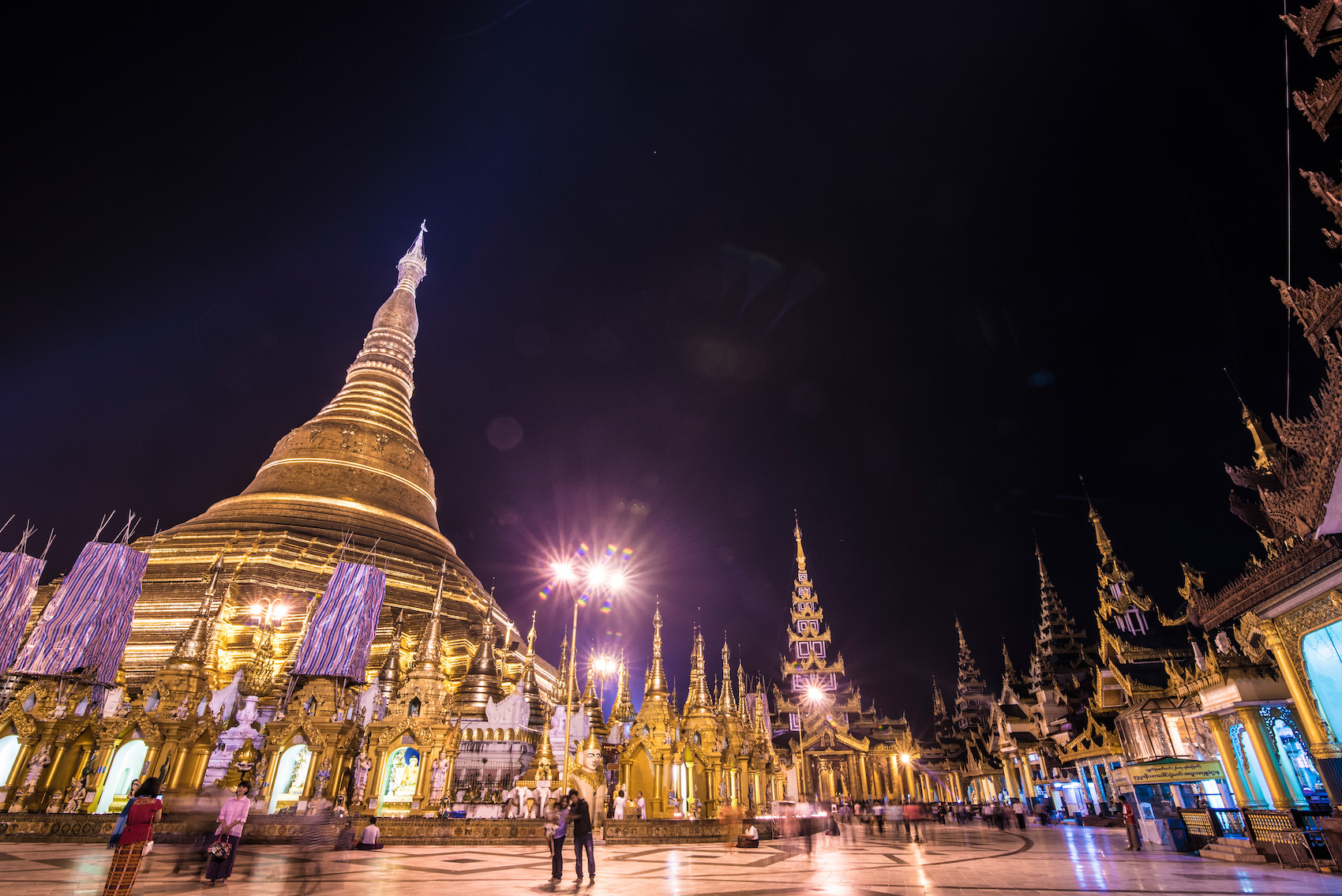
I’ll admit: It’s been controversial even to discuss visiting Myanmar for a hot minute. At the same time, if you can look past the politics, this country is one of the most unique in Southeast Asia. While not as ramshackle as it was when I first visited in 2010, today’s Myanmar remains captivating. Start in the cities of Yangon and Mandalay , before expanding outward. Do you prefer getting lost amid the temples of Bagan , relaxing on Inle Lake or having your mind blown amid the perfect beauty of the Mergui Archipelago ?
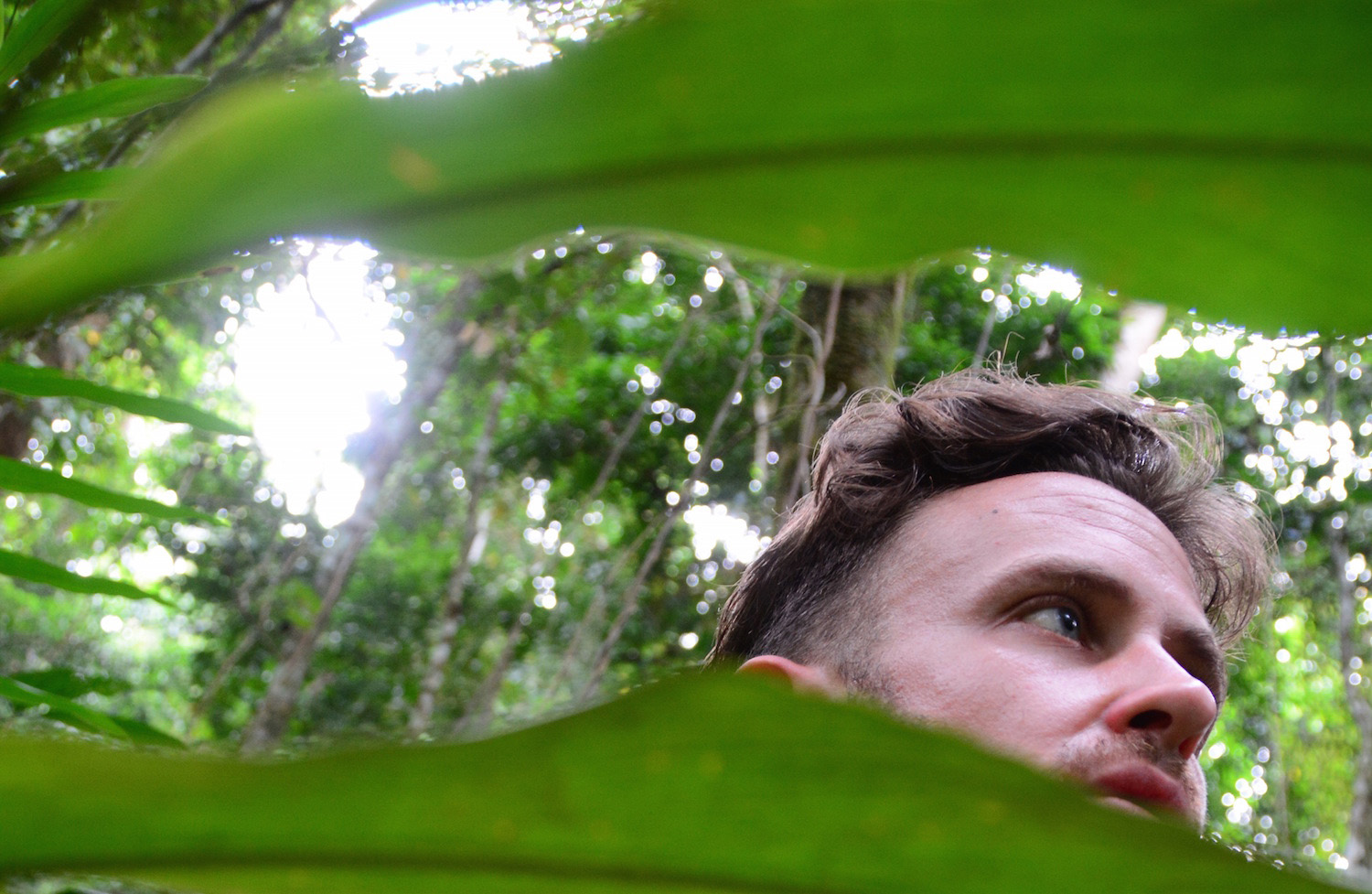
The bad news? In my opinion, the island of Bali is one of the worst places you can visit during your Southeast Asia 2 month itinerary. The good news? Indonesia is home to literally thousands of other islands. From hectic Java (home to manic Jakarta , charming Yogyakarta and the otherworldly Kawah Ijen volcano), to lush Borneo and its wild orangutans, to the paradisiacal Kawah Ijen archipelago, Indonesia is so much more than Bali.
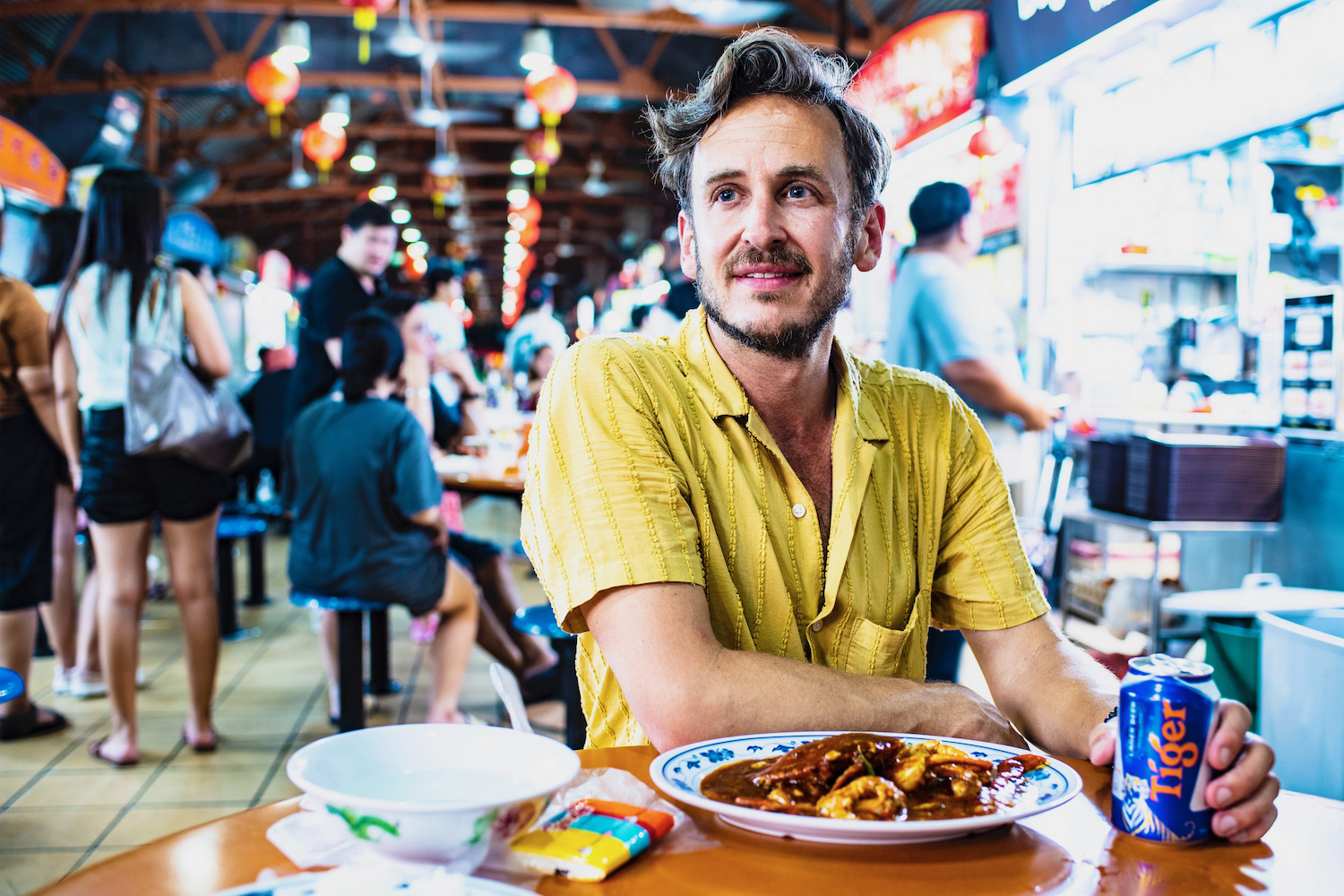
In the past, I mostly saw Singapore as serving a functional role within a 2 month Asia itinerary: A respite from the craziness of the rest of the region. However, as time has passed and “the rest” of Southeast Asia has become less manic, I’ve started to appreciate Singapore for what it is: A city that’s also a country that’s also a microcosm of a continent. Organize your time in Singapore (it will likely be just a few days) around its ethnic neighborhoods— Little India , Chinatown and Malay-Muslim Kampong Glam —as well as around both the natural Singapore Botanic Garden and the delightfully artificial Gardens by the Bay.
Another small country whose borders you may cross during 2 months Southeast Asia is Cambodia . For most travelers, Cambodia requires a week or even less. Many will split their time between the oft-overlooked capital of Phnom Penh and Siem Reap (home of Angkor Wat ); others will also choose to overlook PP. If you have longer or are more curious, you might also opt to hit the beaches of Koh Rong in the Gulf of Thailand , or travel overland to Laos—more on that in a minute.
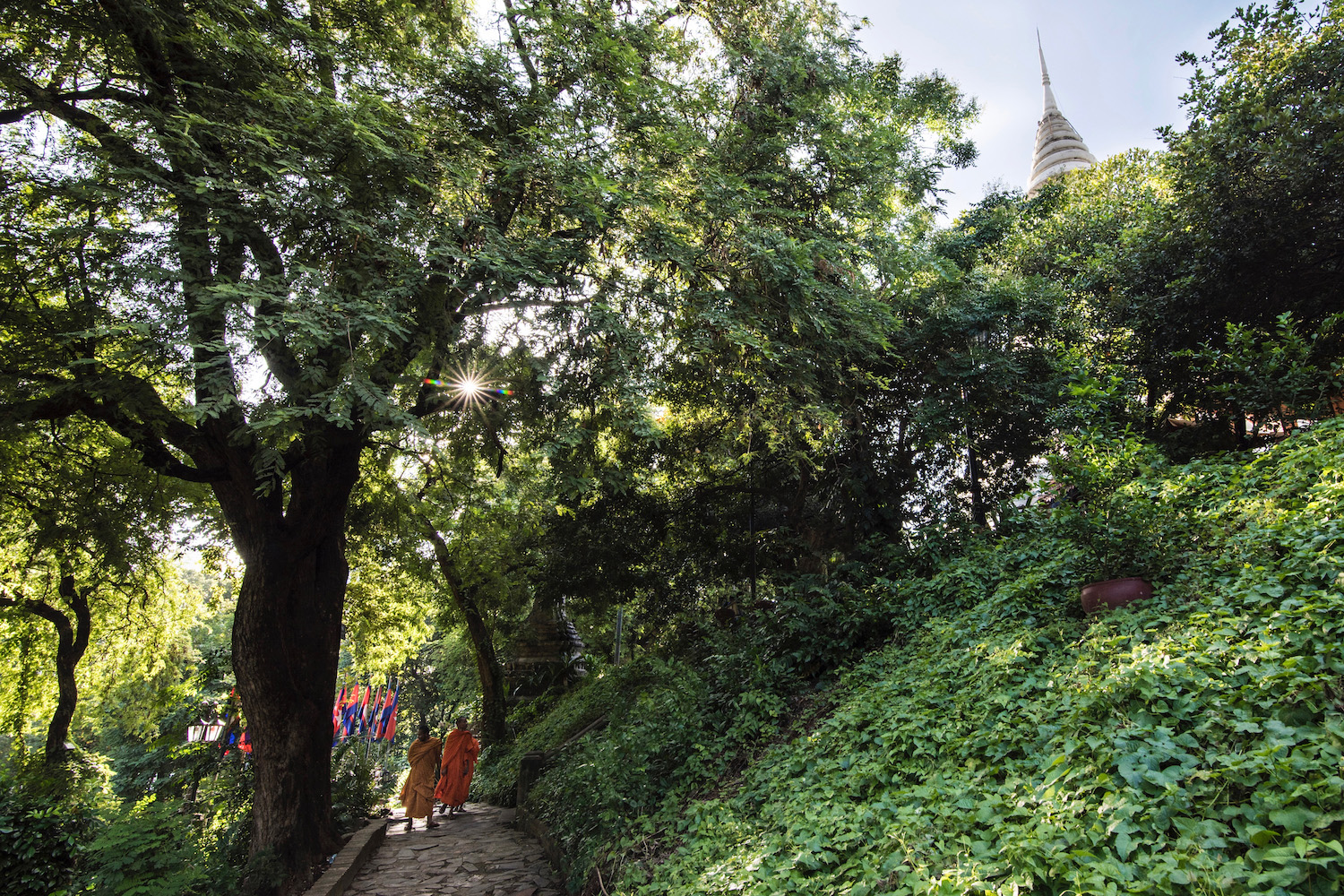
As I explained earlier during this post, Laos is not a must-see if you have a 2 month itinerary Southeast Asia—I usually recommend it or Cambodia, but not both. If you do spend time in Laos, however, context matters. If you can, for example, you might take the “slow boat” from Chiang Rai, Thailand to Laos’ charming Luang Prabang , via off-the-beaten path Pak Beng . Another exciting way is up from Cambodia, via Don Det and the 4,000 Islands . Alternatively, you can fly to Vientiane or Luang Prabang if you’re pressed for time or simply can’t be bothered to travel overland.
The Philippines, Brunei and East Timor
I’m not including The Philippines last on my Southeast Asia 2 month itinerary because I don’t like it—that’s far from the truth. Rather, I haven’t been back there in a while, and so I don’t feel as comfortable recommending destinations and experience as I do for other countries on this list. However, if you have a couple of weeks to spare, make sure to follow up a long weekend in underrated Manila with some time on the country’s award-winning beaches, whether in mainstream Boracay , lush Palawan or off-the-beaten-path Siargao .
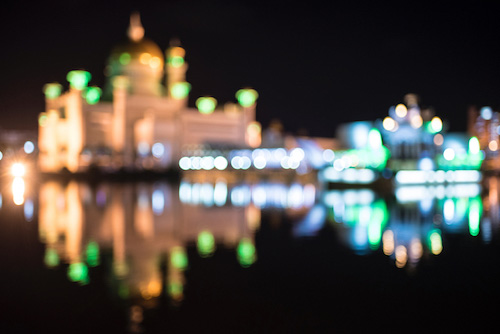
As far as Brunei is concerned? Well, it’s unique, I’ll say that. It’s a place I’m glad I went , but don’t necessarily care to visit again. I haven’t yet been to East Timor , and as of this moment have no plans to visit.
Is 2 Months Enough for Southeast Asia?
As you browse Southeast Asia backpacking routes, 2 months is typically the minimum recommended amount of time—this is not a coincidence. The region is huge, and although the infrastructure has improved massively in the 15 years I’ve been exploring it, can still be a place where the going is pretty slow. If you’re a backpacker who plans to rely primarily on land transport, in fact, I might actually suggest you devote 3-4 months (or even longer!) to Southeast Asia!
Indeed, this 2 month Southeast Asia itinerary is really optimized toward travelers seeking a slightly elevated travel experience. Some overland travel—the slow boat between Thailand and Laos; a couple of trains in Vietnam—but is primarily getting around using places. Select rural areas—Indonesia’s Blue Fire Volcano; the Chocolate Hills of the Philippines—but mostly staying in cities and enjoying day trips from there.
Other FAQ About Spending 2 Months in Southeast Asia
How much do you need to travel southeast asia for 2 months.
I usually count on spending an average of about 100 USD per person, per day when traveling in Southeast Asia. That translates to about 700 USD per person, per week and about 2,800 USD per person per month. This means that you can plan to spend between 5,000-6,000 USD per person to travel in Southeast Asia for 2 months, not including international flights (but including all your internal transport).
How long do you need in Thailand and Vietnam?
Thailand and Vietnam are two of the largest and most interesting countries in Southeast Asia—I usually recommend spending a minimum of three weeks in each. With this being said, you could divide a month between Vietnam and Thailand, if you’re very judicious about where you visit in each country. Hiring me as your Travel Coach would be very advisable in this situation.
How long to spend in Laos and Cambodia?
Laos and Cambodia are beautiful countries, but it’s not a coincidence that they sit geographically between the titans of Thailand and Vietnam: They’re simply neither are large nor as interesting as their more famous neighbors. Often times, I recommend that people with a shorter amount of time choose one of these two; in any case, even if you’ve got two months to explore Southeast Asia, don’t split more than two weeks between Cambodia and Laos.
The Bottom Line
If you’ve made it this far, then congratulations: You’ve got all the information you need to assemble the perfect 2 month Southeast Asia itinerary! Some of you will take a straightforward path—a couple weeks in Thailand; one split between Laos and Cambodia; three weeks in Vietnam or Indonesia, and then two in either Malaysia, Myanmar or the Philippines. For others, things might be a bit less structured, if they’re even set in stone at all. You might even end up staying in the region for a lot longer than two months! Still feeling stressed out at the thought of planning your trip? Consider hiring me as your Travel Coach!

Subscribe to email updates!
Words, images and design ©2009-2024 Robert Schrader, All rights reserved. Read Privacy Policy or view sitemap .

The Ultimate Guide for Planning a Trip to Southeast Asia
By: Author Taylor Lorenz
Posted on Last updated: 03/27/2023
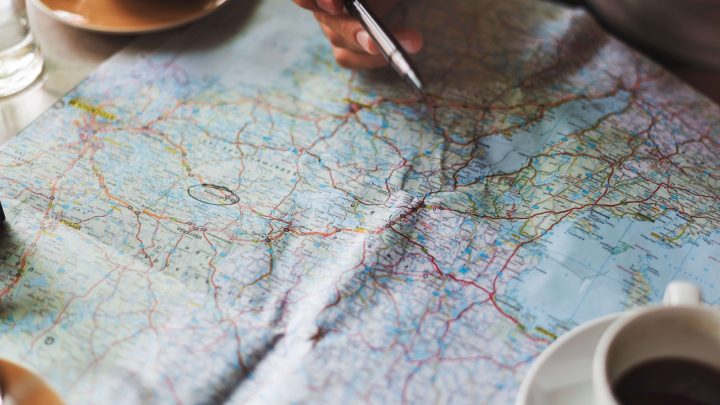
Planning a trip to southeast Asia is no easy task! But don’t get too stressed out, this will help you break it down into steps and give you a general idea of the area, how to start planning and what it will cost!
Whether you’re planning on backing throughout the region or visiting one country for a quick holiday, I break down the best things to see in each country and what kinds of travellers each country is ideal for.
Get your bag ready and get planning your trip of a lifetime!
Table of Contents
Destinations
You’ll have heard of some of these destinations but others may be new. There are still some areas in southeast Asia that have yet to be explored which is good news for adventurous souls.
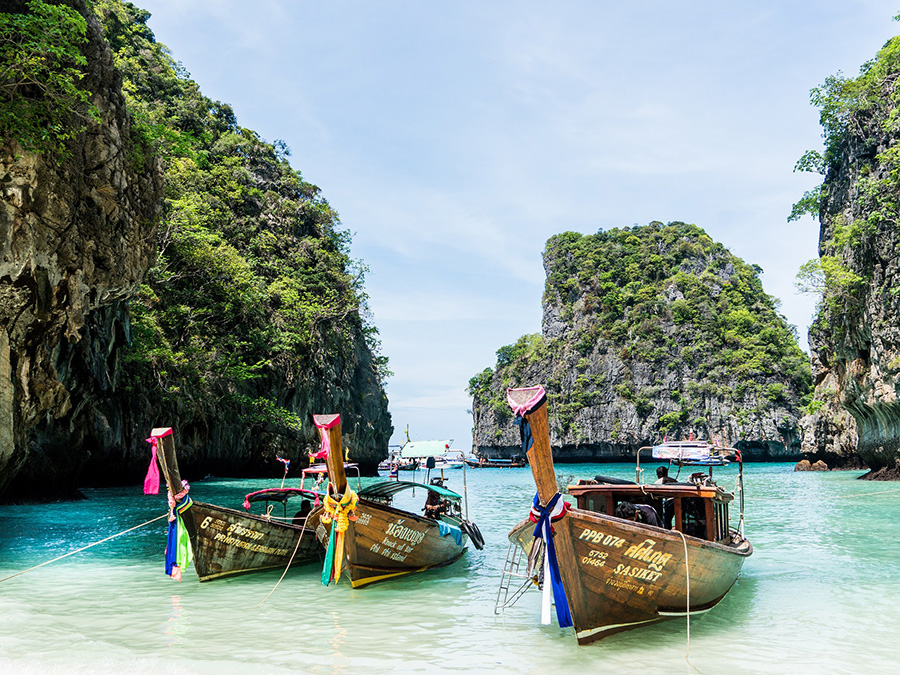
Thailand is the backpacker destination, the ultimate holiday getaway and so much more. Thailand is perfect for travellers looking for those idyllic beaches, adventure, elephants, culture and great food. There really isn’t a reason why Thailand shouldn’t be on your itinerary.
Best Attractions
- Phi Phi Islands, where The Beach was filmed starring Leonardo Dicaprio
- Khao San Road, the ultimate party street and the most famous in all of southeast Asia
- Koh Phangan, for the Full Moon parties
- Koh Tao, for the cheapest diving in the world
Thailand Travel Guide: How to Plan the Perfect Thailand Itinerary
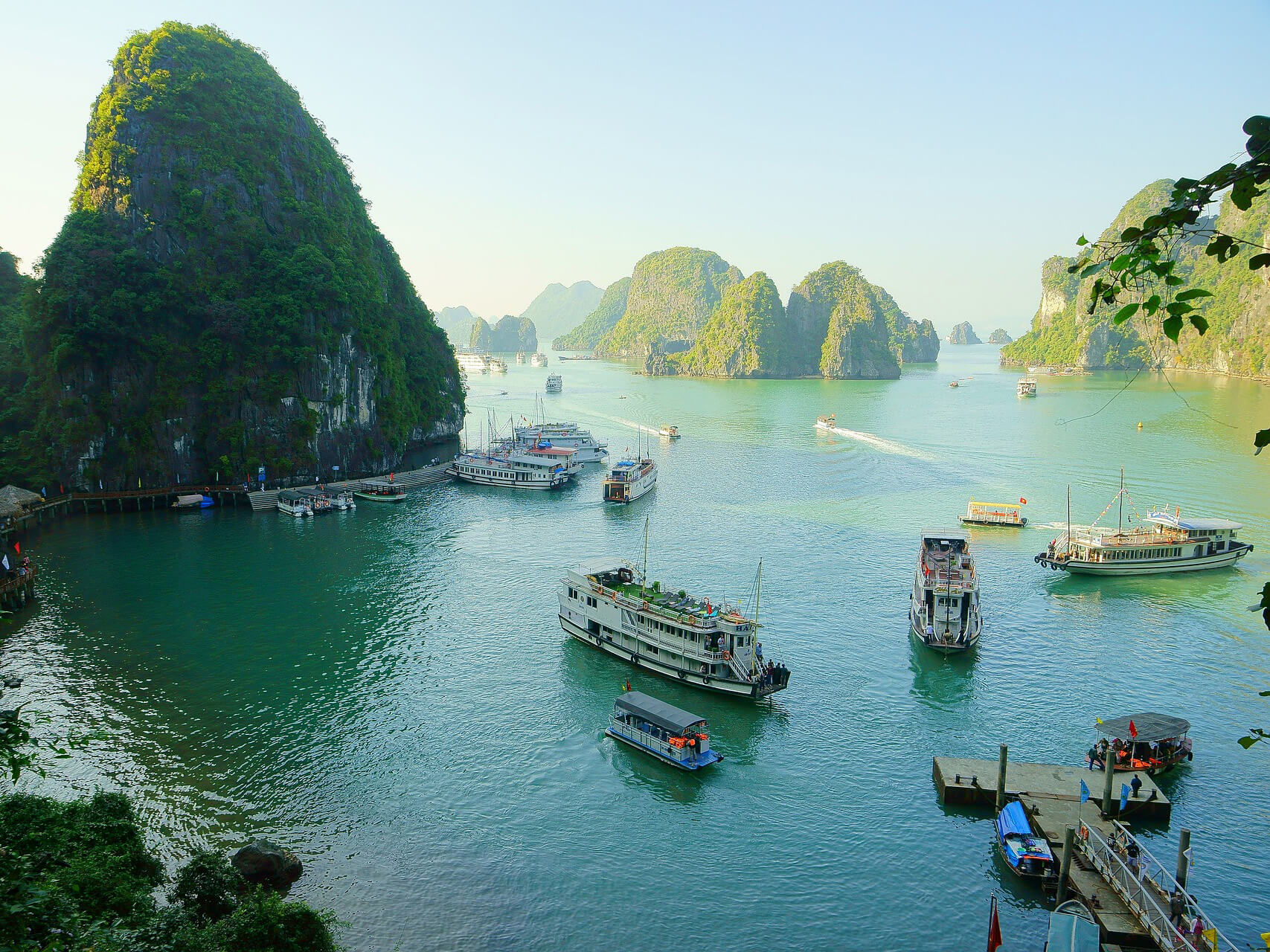
Vietnam is a bit of a tougher country to travel in than Thailand but is still very easy. In Vietnam, you’ll find an incredibly diverse landscape that changes from north to south. Vietnam is perfect for adventure travellers and those who have a minimum of 2-3 weeks to spend travelling the country.
- Ha Long Bay, for cruises through the towering limestone rocks
- Sapa, for trekking through gorgeous green rice terraces
- Hue, to see a bit of history at the impressive Imperial Citadel
- Hoi An, for custom made clothing and a beautiful old town
- Mui Ne, for epic sand dunes
Vietnam Travel Guide: Backpacking Vietnam on a Budget: 2-3 Week Itinerary + Tips
Want to travel for as long as possible?
Why not volunteer?!
There is an abundance of volunteer opportunities in Southeast Asia from helping at schools, on farms, with NGOs, in hostels, and even holistic centres. Check out Worldpackers to see what you can do to volunteer!
If you join the Worldpackers community you get $10 off when you use the code TAYLORSTRACKS just because you’re a Taylor’s Tracks reader 🙂
>>>See Worldpackers volunteer opportunities!
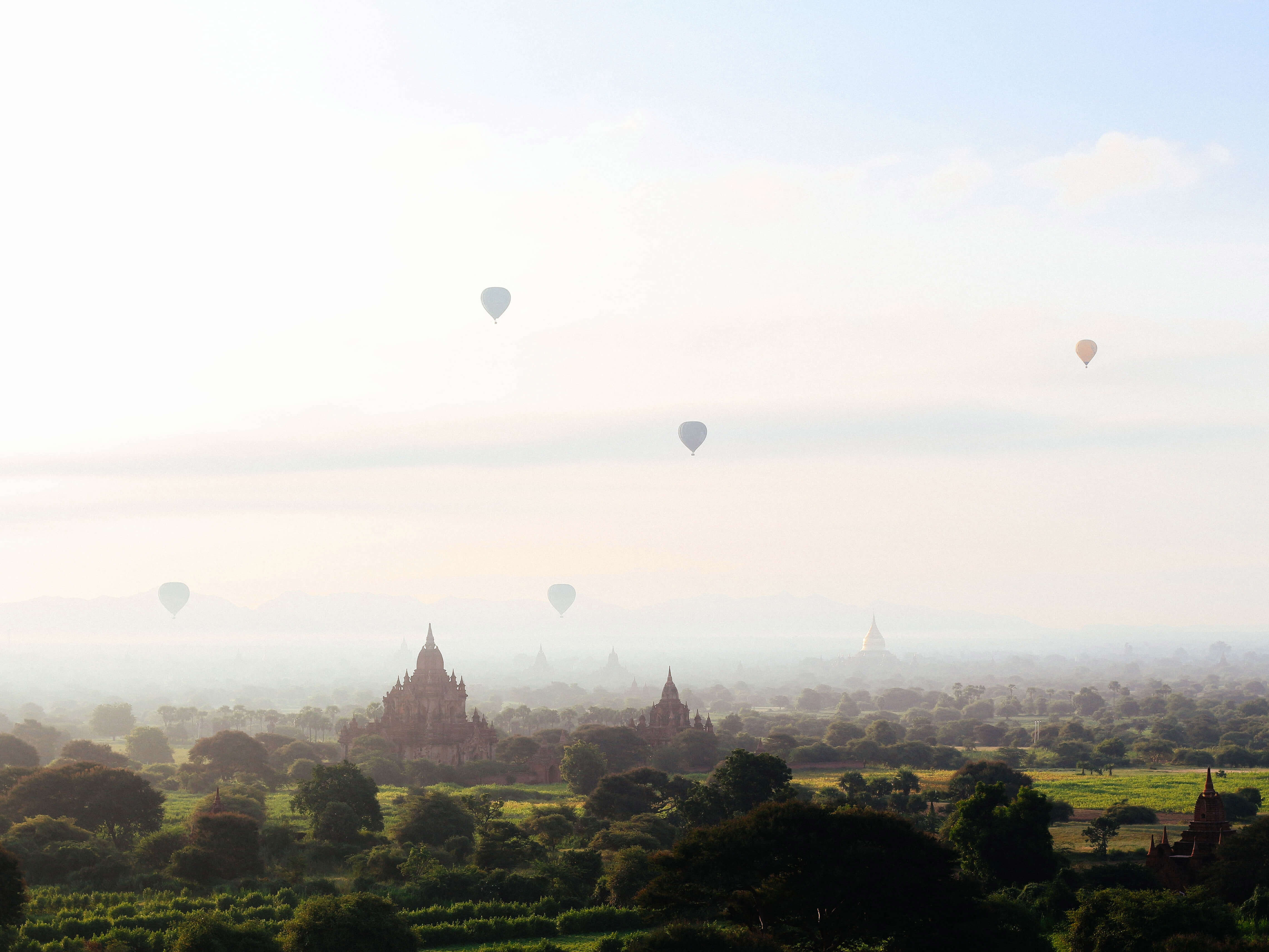
Formerly known as Burma, Myanmar is still off the beaten path. Though it is growing in popularity, it’s a little gem that should be discovered before visitors begin flowing in continuously. Myanmar opened its boarders to foreginers only a few years ago. It is ideal for travellers looking for adventure like trekking and those who are okay with getting off the beaten path and discovering things for themselves.
- Bagan, for epic sun rises in hot air balloons over thousands of temples
- Inle Lake, the floating city surrounded by lush green mountains
- Shwedagon Pagoda, a place with so much gold you’ll be in awe for days
- Golden Rock, a special spot for Myanmar Buddhists where the rock looks like it’s about to fall off the cliff
Myanmar Travel Guide: The Perfect 2 Week Myanmar Itinerary
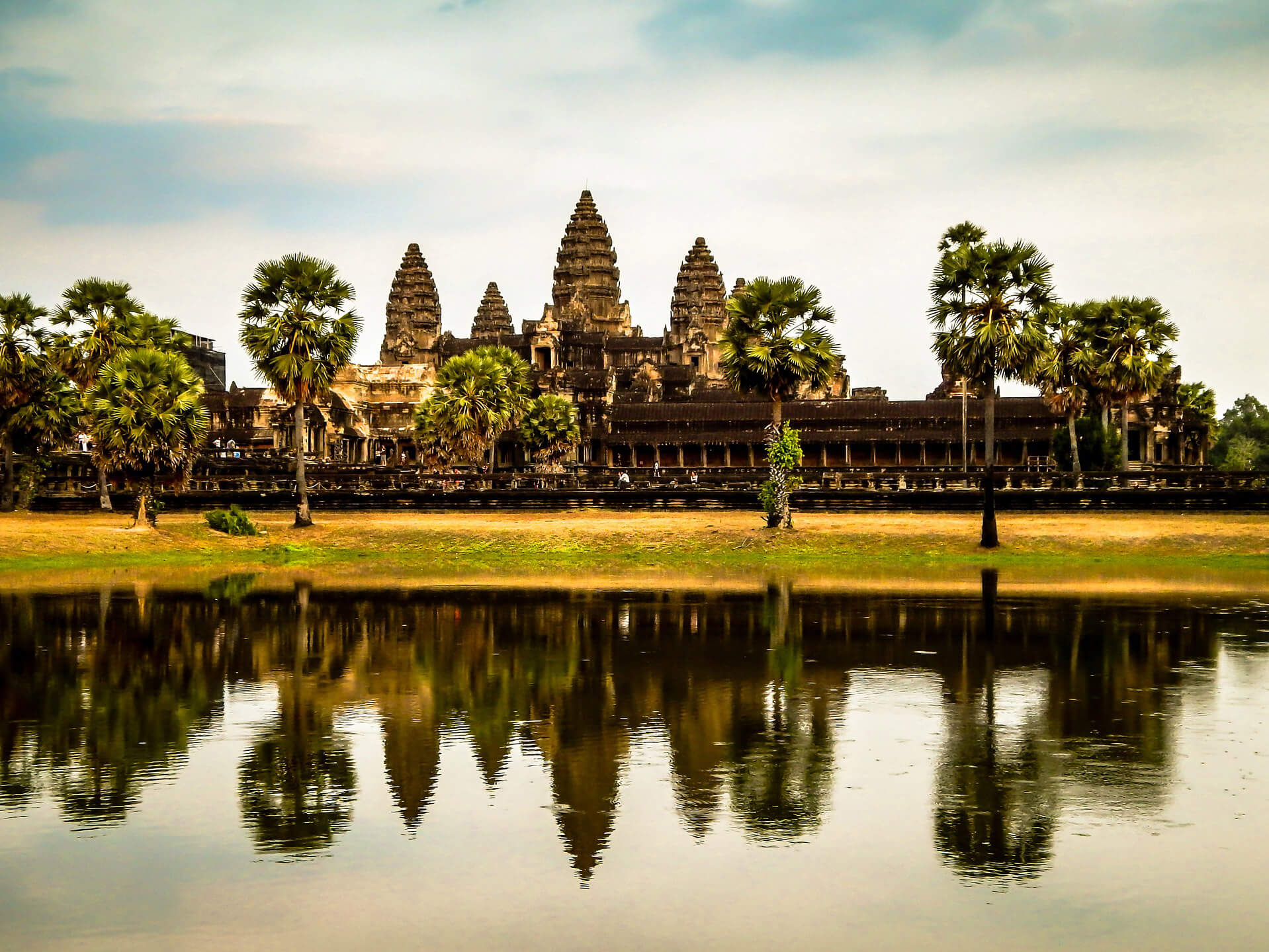
Cambodia is a surprise to many as it’s more than just Angkor Wat. The county has a rough history but lovely people and stunning sights. Cambodia is perfect for travellers wanting somewhere not quite as touristy but still looking to see some epic places.
- Angkor Wat, the largest religious monument in the world…get ready for temples!
- Koh Rong, a beautiful little island that has yet to be overtaken by big resorts (though it’s starting to happen)
- The Killing Fields, a sad place but excellent for learning about Cambodia’s violent history
Cambodia Travel Guide: Backpacking Cambodia on a Budget (1-2 Itinerary)
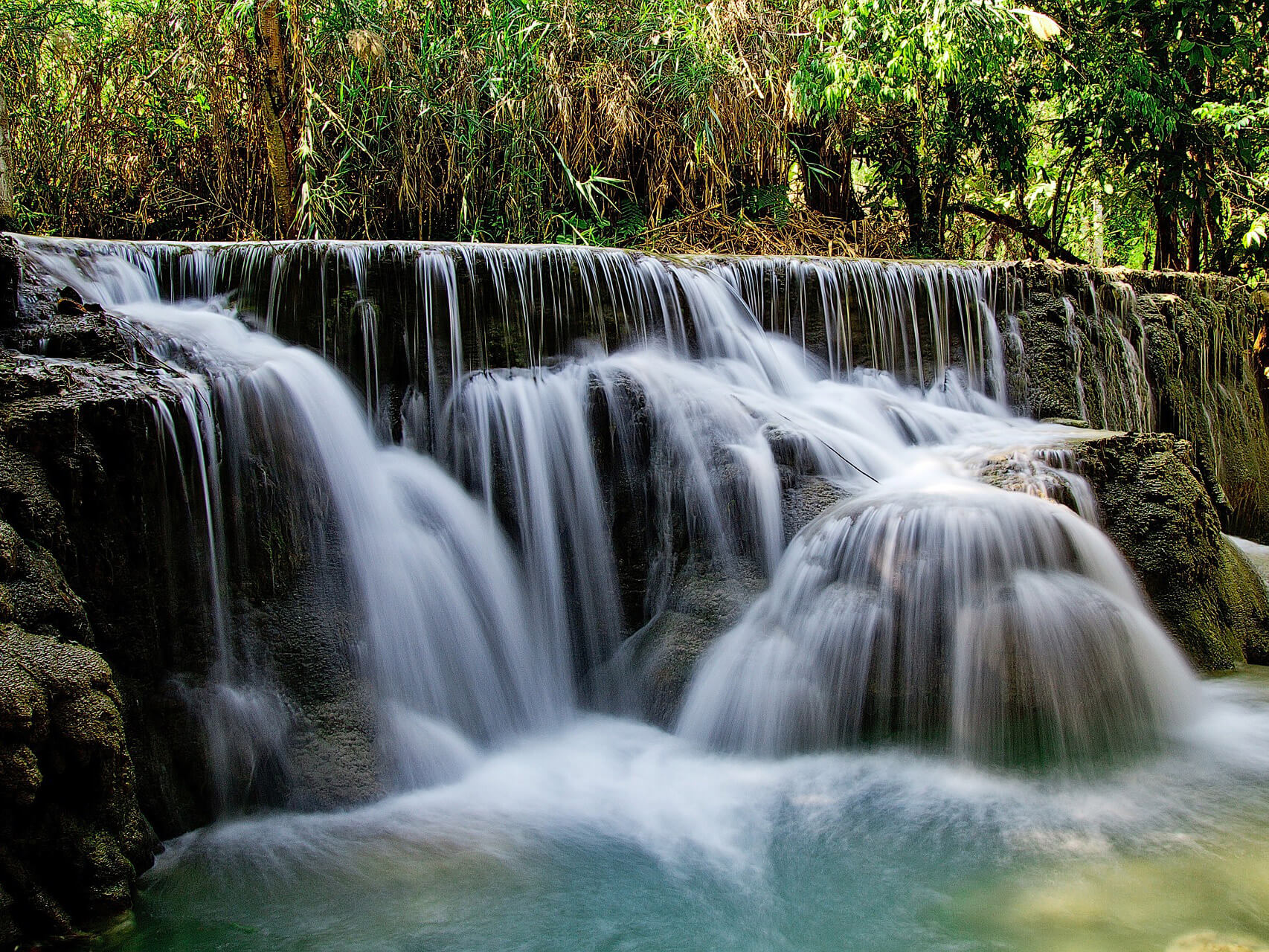
Laos is often overlooked but is a beautiful country filled with temples and waterfalls. It is amazing on your wallet and is a great country for relax in for a while. Laos is ideal for travellers looking to see more nature. There are also parties! Laos is also perfect to connect travels between Thailand and Vietnam.
- Luang Prabang, a gorgeous city with French architecture that is also a UNESCO World Heritage site
- Vang Vieng, nature and of course the famous tubing destination
- Buddha Park, a site filled with religious statues that makes for an interesting trip
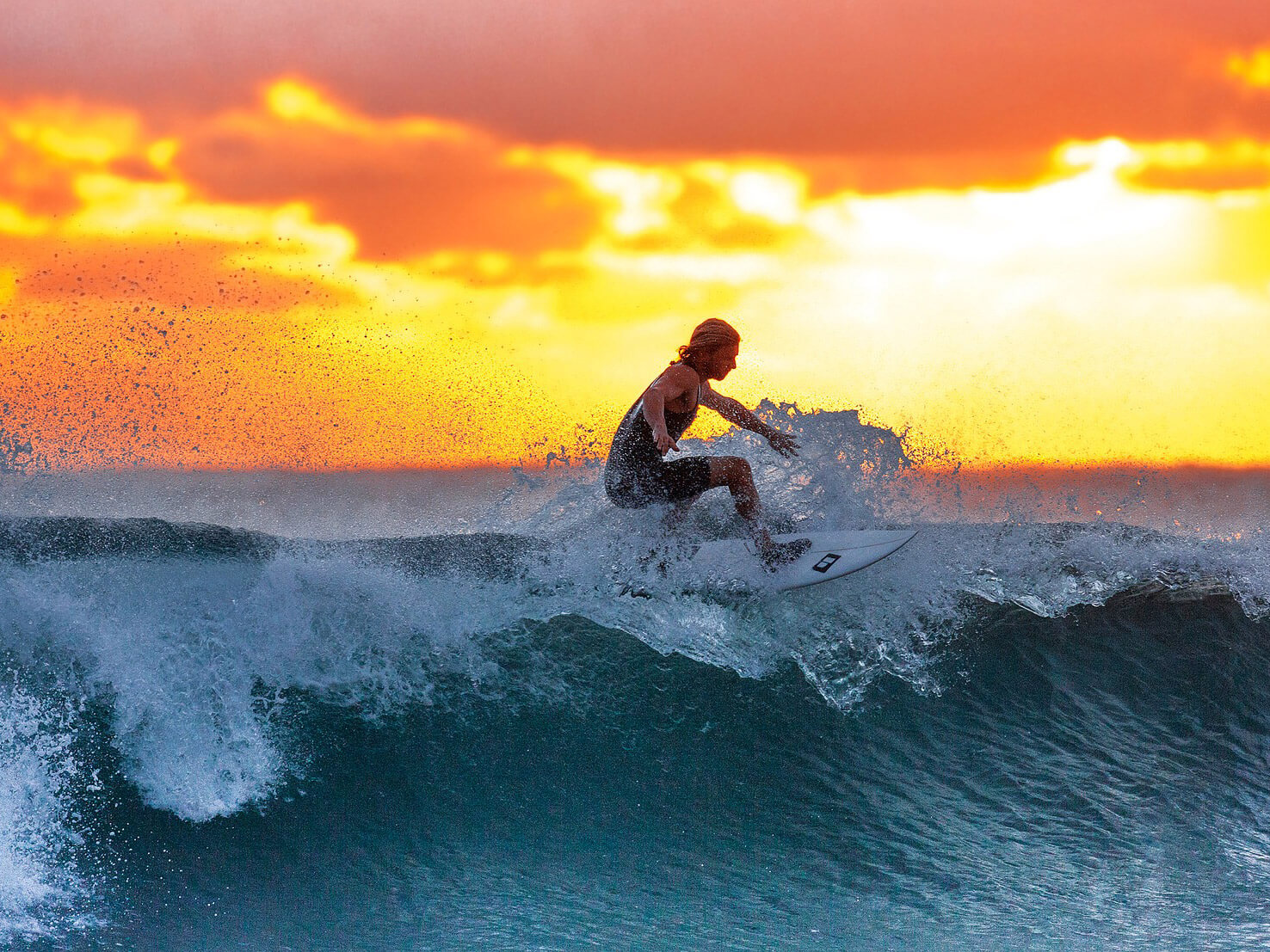
Most famously known for Bali, Indonesia is a little slice of paradise. This country made up of over 17,000 islands is home to a diverse range of activites. Indonesia is ideal for any type of traveller such as those who are interested in diving, a yoga retreat, nature or active activities like hiking or surfing, culture, history and beaches. There is literally something for everyone in this country.
BEST ATTRACTIONS
- The whole island of Bali is one big attraction with the highlights being the cultural centre of Ubud
- Borobudur, the largest Buddhist temple in the world in Yogyakarta
- Mount Rinjani, the second tallest volcano in Indonesia that you can trek to the summit
- Komodo National Park, a must-visit for its great diving and to see these Komodo dragons in the wild
Bali Travel Guide: How to Plan the Perfect Bali Itinerary
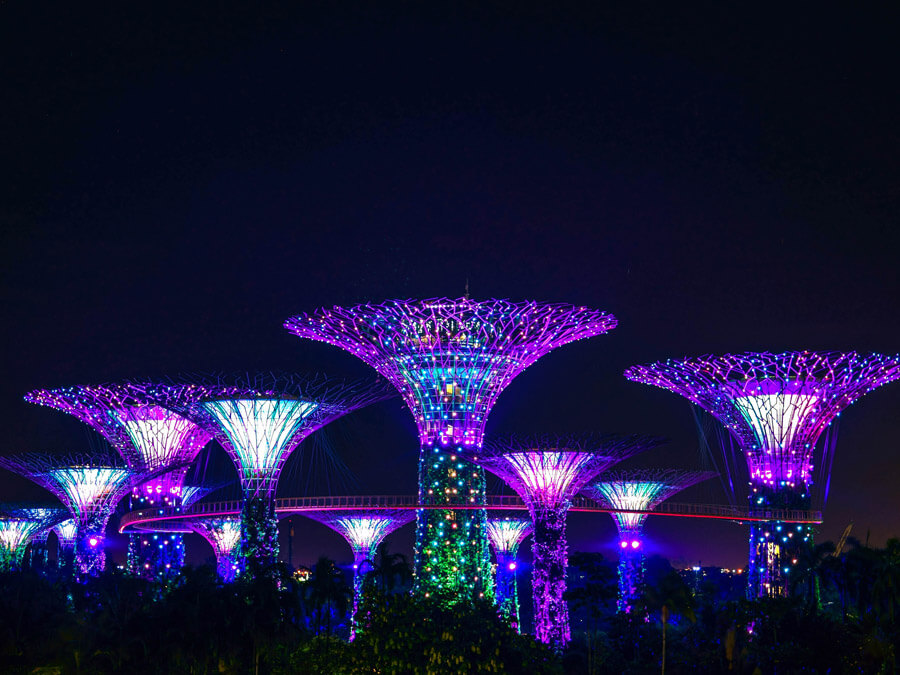
Singapore may be a small country but it’s packed with entertainment. It is the least budget-friendly country in Southeast Asia with prices like are more like western countries, but it’s still worth a visit. Singapore is known for its wide variety of food (that just so happens to be very budget friendly), it’s home to the Merlion (the unofficial mascot of the country) and incredible 1st world attractions, plus the #1 airport in the world!
- Gardens by the Bay, a colourful light show by night, an out of this world garden to explore by day
- Marina Bay Sands, the world-renowned hotel
- Sentosa Island, for endless amusement park entertainment
- Neighbourhoods such as Chinatown and Little India
Singapore Travel Guide: How to Plan the Perfect Singapore Trip
Other destinations in southeast Asia include Malaysia, Brunei and East Timor (Timor-Leste).
Your dollar is going to stretch very far in Asia which means you can travel longer or travel like a king or queen. But if you choose to do both it will add up. Southeast Asia can easily be travelled through on $30-$40 (USD) a day. Of course, you could always end up spending more or less.
Typically the cheapest countries are Thailand, Vietnam and Cambodia. Myanmar, outside of Kuala Lumpur in Malaysia, the Philippines and Laos are slightly more expensive but still very affordable. Singapore is the most expensive and often people only visit for 2-3 days.
This budget is very much achievable if you follow these basic tips:
- Stay in hostels
- Eat street food
- Minimize your drinking (it’s cheap but it will add up quickly)
- Bargain (this is common so get used to it)
READ THIS: How to Create a Backpacking Budget for a Southeast Asia Trip
Travel Insurance in Southeast Asia
Southeast Asia is a very large area and the climates can range drastically in one country alone. That being said, it is crucial that you research what the weather is like as you’re planning your trip. Getting suck in the monsoon season in Myanmar or Malaysia could result in rainfall constantly or entire parts of the country shutting down.
Events & Holidays
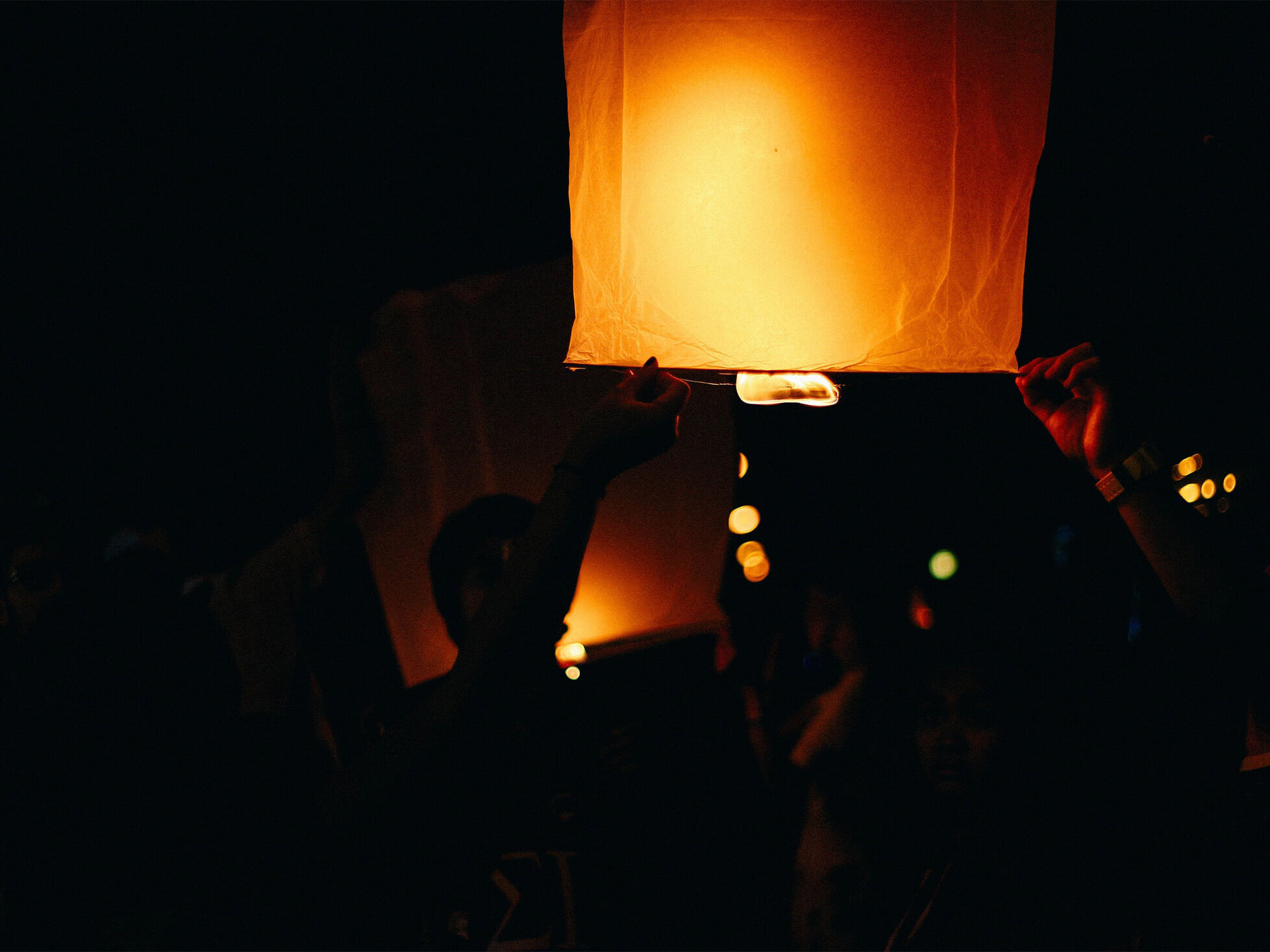
Some events in southeast Asia are a big deal and can mean that you’ll end up paying higher prices if you’re visiting around the event or holiday. That being said, you may also want to plan your trip around one of said events or holidays because it can be an incredible way to experience a culture.
Getting Around

Outside major cities in southeast Asia you will find local transportation is minimal. You’ll often find yourself hiring a scooter or hopping on a tuk tuk. Get your bargaining skills ready and make sure you check over your scooter before renting it as many people are caught in scams. Ask about driving in the area as well because many areas are not good for those with little experience on a scooter.
From city to city there are many ways to get around depending on the country. Research safe ways to get around, it is often worth it to spend the extra bit more and get a VIP bus or something with air conditioning! Other places you’ll need to take ferries which can be unreliable. Just do your research beforehand on specific routes.
Accommodation
Anyone looking to travel southeast Asia on a budget should be staying in hostels. That being said, it is easy to splurge once in a while and get a private dorm or hotel room because they can be quite reasonable! Dorms rooms are usually $10USD and under while hotel rooms can be around $30USD.
I personally use and recommend these sites for finding accommodation throughout southeast Asia:
FOR HOSTELS AND HOTELS: Booking.com
READ THIS: 8 Things You Need to Pack for Hostel Travel & Hostel Tips You Need to Know Before Booking
Lastly, one of the most important things for planning a trip to southeast Asia, visas! Most countries will allow you to get a visa on arrival but there are some exceptions. Myanmar and Vietnam both require visas in advance. You can get these from an embassy or online depending on how you are travelling into the country. Visas range from free to over $50USD and change price depending on where your passport is from.
Each visa also has different limitations of how many days you can spend in a country. Do the research before you go so you don’t end up overstaying in a country which could result in paying extra fees.
Learning Cultural Norms and Languages
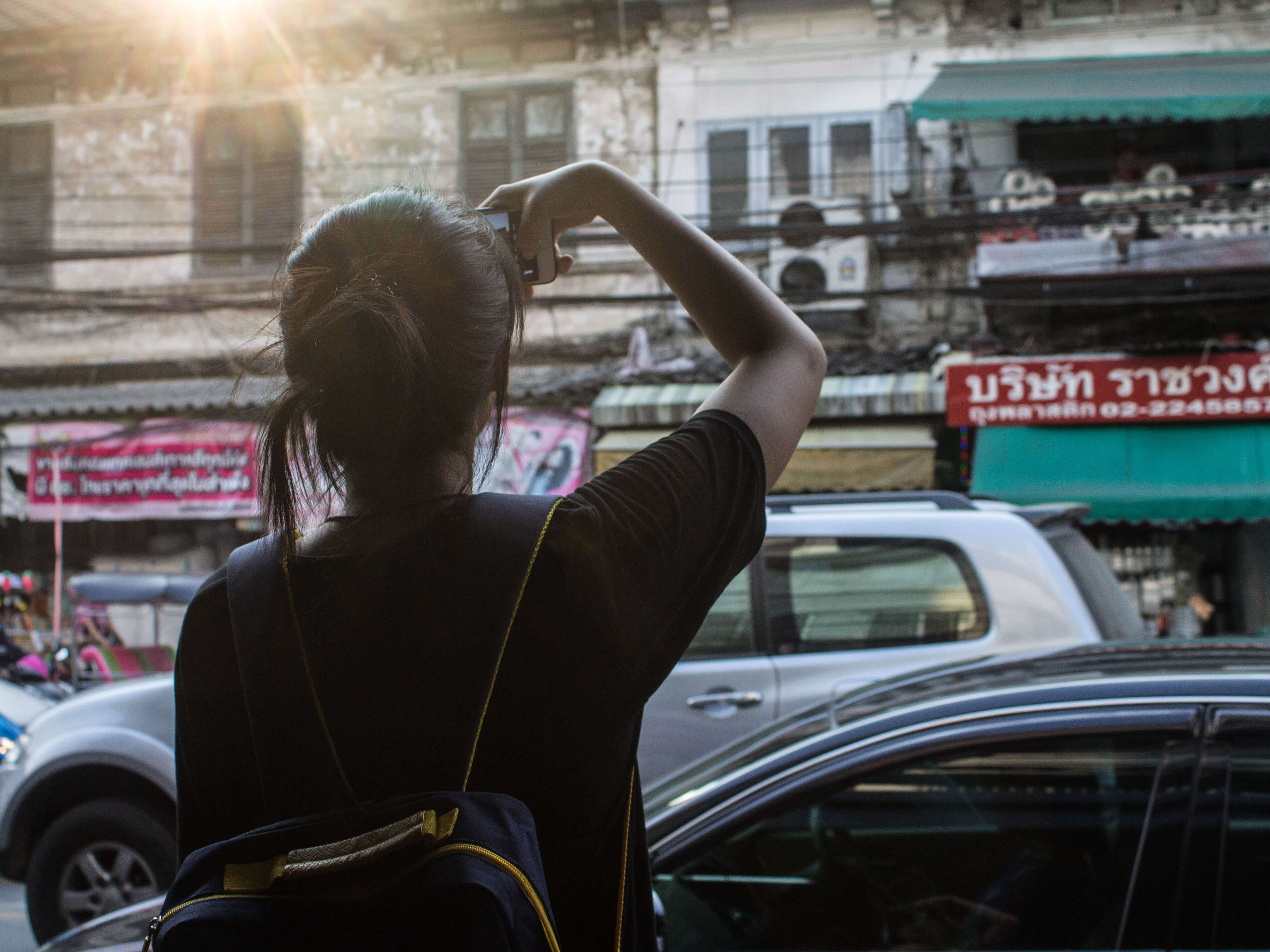
Remember you are travelling to someone’s country, it is your responsibility to adhere to their norms. The basics are being polite and covering up. Each country is different though. You may be able to get away with a crop top in Thailand but that won’t fly in Myanmar.
Learn to eat like a local as well and you’ll save a ton of money. There is no need to fear street food! Use your judgment before you eat something, if it looks like its been sitting there for hours then it probably has so move on. Quite often food is cooked right in front of you and can often be better than restaurant food for both taste and safety-wise!
Make the small effort and learn a few key phrases or words in each language of all the places you’re travelling to. I can help you get started with the basics of how to say hello and thank you.
READ THIS: How to Say Hello and Thank You in 37 Different Languages
That was a lot of information! This just covers the basics but hopefully it gives you a better idea of where to start. This guide is loaded with links to more detailed posts and travel resources so be sure to keep the email with this link to refer back to it.
MUST READS:
- 51 Travel Tips for Backpacking Through Southeast Asia
- 11 Common Southeast Asia Travel Mistakes (And How to Avoid Them)
I try my best to keep all information up to date but things change constantly so please be sure to do the necessary research.
Southeast Asia in an incredible, beautiful and unreal place packed with adventures, relaxation hot spots, history and so much good food. It is inevitable that things are going to go wrong, that is a part of travelling in southeast Asia. Be as prepared as you can but know that you will never be prepared for all of southeast Asia’s surprises!
Disclosure : This post contains affiliate links which I earn a small commission from and are at no additional cost to you.
Disclaimer: This post may contain affiliate links which I earn a small commission from and are at no additional cost to you. See my disclosure policy for details. Thank you for supporting my small business!
Disclaimer: Taylor’s Tracks is a participant in the Amazon Services LLC Associates Program, an affiliate advertising program designed to provide a means for us to earn fees by linking to Amazon.Com and affiliated sites.
12 tips for your first trip to Southeast Asia

Editor's note: The team at The Points Guy loves to travel, but now is not the time for unnecessary trips. Health officials note that the fastest way to return to normalcy is to stop coming in contact with others. That includes ceasing travel. We are publishing travel deals and destination content because we should all use this time to think about and plan our next adventures. TPG doesn't advise booking trips for travel until summer or fall — and even then be mindful of cancellation policies. This story has been updated with new information.
Southeast Asia is one of the most magical regions on earth. Filled with stunning beaches , historic temples, verdant jungles and bustling cities, there's something for every traveler there. But staying healthy and safe is something to consider when visiting a region so different from your own, especially for the first time. Things like visa requirements , best times to visit, currency exchange and what to bring may be at the top of your mind, as well as the most obvious question -- which country should you visit?
After a number of long-term visits over the years to varying countries in Southeast Asia, I've learned a thing or two. Beginner travelers should check out these travel tips and follow this Southeast Asia travel advice when considering a visit to the region for the first time.
1. Pick your countries wisely
While it's tempting to visit many countries and cities on a single trip to Southeast Asia, it's worth taking it slow and digging into the culture of a single country and/or just a handful of places, rather than exhausting yourself with a travel itinerary that has you hopping all over what amounts to an enormous territory.
For example, Bali , Indonesia and Hanoi, Vietnam , are both set within Southeast Asia, but beware -- they're a seven-hour flight away from each other. Before you commit to flights and accommodation , pull out the map and choose countries/cities that are relatively close together or are easily accessible by nonstop flights or direct trains.

When deciding on the best country to visit in Southeast Asia, you should also take into account whether you want to explore cities, relax on beaches, see the outdoors or embrace culture, cuisine and history.
The best country to visit for beginner travelers could be Thailand. First-time visitors to the region may also enjoy Bali, Indonesia. Both of these spots are used to an influx of tourists and have plenty of amenities. They're both relatively easy to navigate and have friendly locals that speak English.
More experienced travelers or those wanting an adventure may prefer spots like Myanmar, Malaysia or Laos. While almost all Southeast Asia destinations welcome backpackers with open arms, Cambodia is very backpacker-friendly -- and is extremely affordable, especially outside of tourist destination Angkor Wat. Those wanting to lap a country from top to bottom should head to Vietnam. For unexplored beaches, visit more off-the-beaten-path islands in Indonesia (that aren't Bali) or the Philippines .
Related: 9 of the best sustainable backpacks for travelers
2. Check visa requirements
Several Southeast Asian countries require your passport to have at least six months' worth of validity left or a specific number of empty pages -- and visa requirements seem to be constantly changing. For example, a few years ago, e-visas weren't available online for several entrance points in Myanmar, but now they are. Meanwhile, Vietnam has changed its visa requirements in past years and now citizens from several European countries no longer need a visa to enter.
Check visa requirements ahead of time and apply online if possible. For example, U.K. nationals will find that applying for a visa to enter Laos online is relatively straightforward and can ease hassle upon arrival, especially when you're jet-lagged in a new and unfamiliar country.

If you do end up needing a visa upon arrival at your chosen destination(s), be prepared with the proper currency and passport-size photos of yourself. Many airport visa offices have ATMs/exchange services (albeit with terrible rates) and photo booths, but if you arrive with these items in hand, as well as any forms you might need printed and filled out ahead of time, the visa experience will be quicker and easier.
Also, be sure to grab a couple of extra entrance and exit forms each time you enter a country -- if you end up leaving and reentering that country by bus, boat or train, having the correct forms handy will enable you to save time you'd otherwise spend in a line.
3. Pack light and right
Deciding what to bring to Southeast Asia is a common conundrum. Try to pack as light as possible and do laundry wherever you go rather than trekking around with an overweight backpack or heavy trolley bag. In most Southeast Asian countries, you can get your clothes washed, dried and ironed in under 24 hours for the equivalent of a couple of dollars, and at street markets, you can shop inexpensively for any extra clothes and toiletries you may need.

These are the things you should make sure to pack:
- raincoat/umbrella (especially during rainy season)
- modest clothing covering knees/shoulders for temple visits
- first aid kit (including all kinds of stomach medicines)
- small flashlight
- earplugs/ sleepmask
- hand sanitizer
- travel packs of tissues (note that squat toilets usually aren't equipped with toilet paper)
- adaptor/multi-port plug that allows you to charge a few of your electronics at once
Related reading: 14 packing hacks for traveling with just a carry-on
4. Best times to visit Southeast Asia: rainy or dry season?
You can organize your trip in one of two ways: picking a destination(s) first and then selecting the best time to go, or picking your destination(s) based on what will have the best weather during the time you're able to visit. Most countries in Southeast Asia have two main seasons: wet and dry.
Even certain regions within countries can have separate rainy seasons . For example, if you want to have a beach holiday in Thailand over Christmas, it's better to choose islands in the Andaman Sea, which are sunny, like Koh Lanta or Koh Yao Yai and skip the Gulf of Thailand islands, such as Koh Samui or Koh Tao, where it's rainy season.

If you're visiting larger cities, rainy season may not be so bad. You'll experience a downpour or two for sure, but you may get cheaper hotel deals or better value on airfare. But, it may be best to avoid smaller towns or villages during the wet season where lack of infrastructure during floods may complicate your stay.
It's also important to consider additional seasonal situations -- like burning season, where many Southeast Asian regions burn brush and old crops to prepare for planting. Air quality is bad during this time and may affect tourists, especially those with respiratory problems.
5. Safeguard your health
Before you travel to individual countries, check their vaccine requirements and recommendations -- and then actually get those vaccinations. If you're worried about the expense, be aware that you can opt to get your vaccinations upon arrival in Bangkok , where they're often affordable at local health centers. When traveling to any Southeast Asian country, getting tetanus shots and typhoid vaccines are generally a good idea. In addition to any necessary vaccines, seek out strong mosquito repellent, as this can help protect you from dengue fever and malaria.

6. Get travel insurance
Plan to get travel insurance when visiting the region, because health risks in Southeast Asia don't entirely diminish even if you've had your vaccines. As Southeast Asia trips often include adventures like indulging in street food, zip-lining, scuba diving , jungle treks and motorcycle rentals, it's wise to have a policy in place.

During a previous trip to Thailand, I developed an ear infection from snorkeling . Thanks to my travel insurance, I was in and out of a doctor's office within an hour, complete with medicine and a special souvenir bag (see above) -- all covered by my policy. Years ago in Malaysia, my husband cut his foot on coral while diving and required antibiotics. Having travel insurance made the situation an easy (and free) fix. Insurance policies can also cover non-health-related problems such as lost luggage or issues with flights and hotels, so look into getting the best travel insurance policy for you.
7. Consider alternate travel methods
While we love a good points and miles deal, using trains, low-cost airlines and ferries is a great way to save money while moving from place to place. Buses are generally the cheapest method of transport in Southeast Asian countries, but be aware of travel scams and know that you might be in for dirt, dust, unpleasant (or simply strange) smells, crowds, bumpy roads and more.

Ferries can sometimes be crowded, but are a quick, cheap and a direct form of travel between islands, and though often slow, trains are a fun way to explore and see the lay of the land(s). Low-cost carriers such as AirAsia, Bangkok Airways , Nok Air, Tiger Air and more offer cheap flights to a variety of destinations -- and some even have frequent flyer programs . Though often a splurge in comparison to bare-bones taxi-boat journeys, river cruises are luxurious, scenic adventures and a great mode of transportation.
8. Rent a scooter at your own risk
If I had a dollar for every 20-something I saw with a bandaged knee, chin or foot in Thailand, I would easily be rich. Renting scooters can be a great way to get around, but in some Southeast Asian countries you'll need to drive on a different side of the road you're accustomed to and you may have to battle intense traffic, hills, curves, stray dogs, dirt or sand roads, crazy taxi drivers -- and worst of all, other foreigners driving scooters who are unfamiliar with these conditions. Even though many locals and tourists don't wear helmets, you still should.

Before you head off with a rental scooter, be sure that your rental agent sees you taking detailed photos and/or videos of the bike, and actively point out any scratches or concerns to them. Though scooter rentals are often just a few dollars per day upfront, scooter scams are common, where a rental agent will insist that you've scratched or otherwise damaged their motorbike, charging you hundreds (or even thousands) of dollars in damages before they'll return your passport to you.
9. Be smart about currency exchange
Airports and banks often charge excessive fees to exchange money, but you'll usually get a decent exchange rate if you wait to change money once you're in Southeast Asia. However, know that Southeast Asian hotels generally offer terrible exchange rates, so stick to banks or other spots that advertise "Money Exchange." Make sure to change plenty of cash, as street market vendors, taxi drivers and smaller restaurants may not take credit/debit cards.

Many hotels and larger restaurants will take credit/debit cards though, so make sure to use ones that hold no foreign transaction fees.
10. Avoid "temple burnout"
"Temple burnout" happens when you see so many ornate and beautiful temples that they all begin to look the same -- and you lose interest in seeing any more, ever. To avoid this malady, arrange some non-temple-oriented activities on your Southeast Asia travel itinerary, or simply take a day (or two) off to relax and rest your eyes. After a bit of visual reboot, you'll have a whole new appreciation for a region of the globe that has more amazing temples than you could possibly imagine.

11. Don't be afraid to bargain
You should absolutely bargain with local street vendors or at markets -- it's a cultural norm to do so. I've had some great times bargaining and laughing with street vendors and even made friends with a few locals along the way, coming home with memorable souvenirs for my efforts. Just make sure to barter reasonably and always with a smile on your face. The point of bargaining is to engage with locals and agree on a fair price, not to cheat them or get scammed yourself.

12. Be a responsible tourist
It's best to avoid orphanage tourism, hill tribe visits or any activity that exploits children, ethnic groups or animals. When participating in elephant tourism, make sure to carefully vet your organization and make sure they're protecting the animals in lieu of harming them.
While begging children may tug at your heartstrings, the more money they earn from tourists, the more their parents see them as a source of monetary gain and the less inclined they are to send them to school -- where they'd have a shot at a better future.

When diving/snorkeling or out in nature, make sure to adhere to the no trace policy , not littering or taking anything from delicate natural environments.
If you want to lend real support to locals in Southeast Asia, dine at Tree Alliance restaurants . Located in Myanmar, Cambodia and Laos, these eateries train disadvantaged young adults as chefs and waiters and also donate money to programs that assist low-income locals to get jobs. Offering traditional cuisine, these restaurants provide a delicious way to help.
Related: 5 tourism-supported charities that need your help now more than ever
Or, visit an organization like Big Brother Mouse in Luang Prabang, where tourists can read books, play games or chat with kids and teens eager to practice their English.
Related: How to be a better traveler
Bottom line
Armed with these useful travel tips for Southeast Asia, you'll have a safe, smooth and successful first trip to this beautiful region. Happy travels!
UK Edition Change
- UK Politics
- News Videos
- Paris 2024 Olympics
- Rugby Union
- Sport Videos
- John Rentoul
- Mary Dejevsky
- Andrew Grice
- Sean O’Grady
- Photography
- Theatre & Dance
- Culture Videos
- Fitness & Wellbeing
- Food & Drink
- Health & Families
- Royal Family
- Electric Vehicles
- Car Insurance Deals
- Lifestyle Videos
- UK Hotel Reviews
- News & Advice
- Simon Calder
- Australia & New Zealand
- South America
- C. America & Caribbean
- Middle East
- Politics Explained
- News Analysis
- Today’s Edition
- Home & Garden
- Broadband deals
- Fashion & Beauty
- Travel & Outdoors
- Sports & Fitness
- Sustainable Living
- Climate Videos
- Solar Panels
- Behind The Headlines
- On The Ground
- Decomplicated
- You Ask The Questions
- Binge Watch
- Travel Smart
- Watch on your TV
- Crosswords & Puzzles
- Most Commented
- Newsletters
- Ask Me Anything
- Virtual Events
- Betting Sites
- Online Casinos
- Wine Offers
Thank you for registering
Please refresh the page or navigate to another page on the site to be automatically logged in Please refresh your browser to be logged in
The Independent's journalism is supported by our readers. When you purchase through links on our site, we may earn commission.
The best countries to travel to in Southeast Asia
From indonesia to malaysia, the must-visit destinations on this corner of the continent, article bookmarked.
Find your bookmarks in your Independent Premium section, under my profile
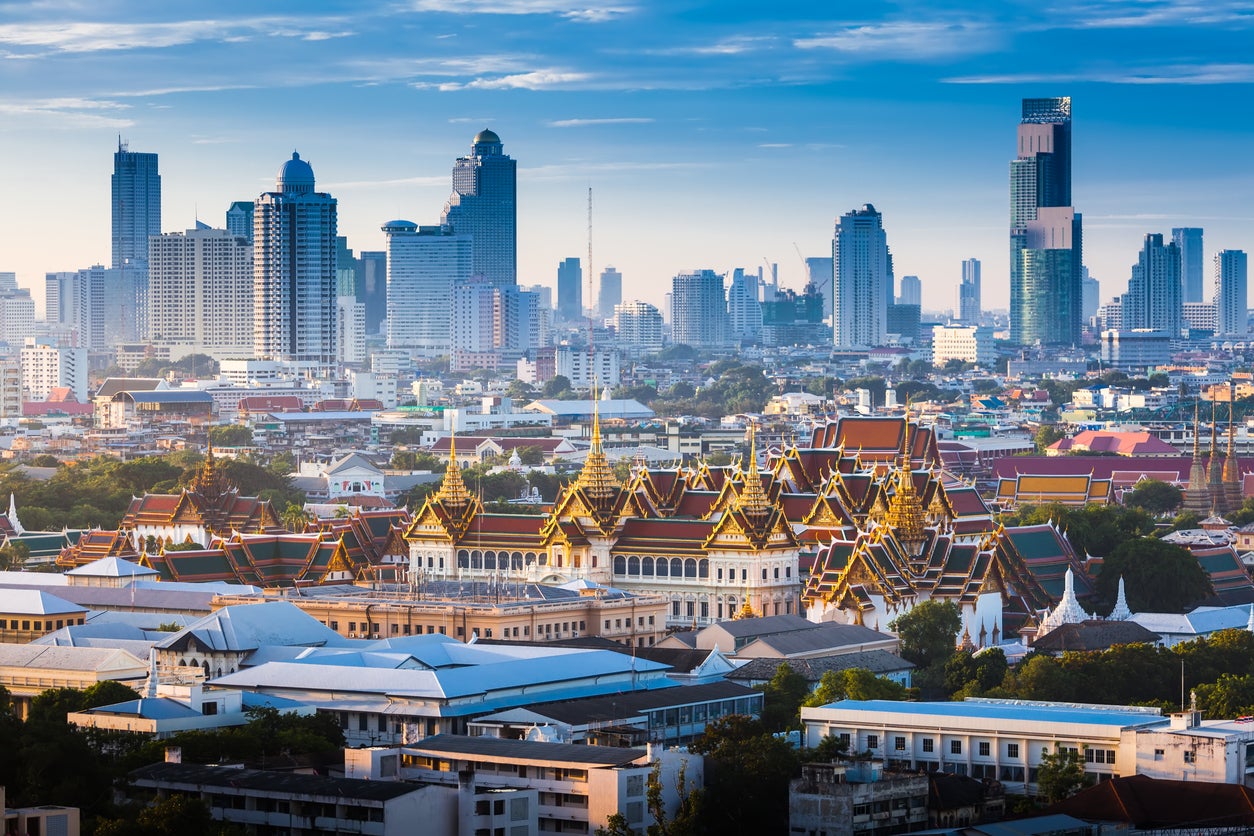
Sign up to Simon Calder’s free travel email for expert advice and money-saving discounts
Get simon calder’s travel email, thanks for signing up to the simon calder’s travel email.
Southeast Asia is a blend of fascinating traditions and cultures, with some of the most incredible temples, palaces and natural sites on the planet.
This region is home to famed attractions, from Angkor Wat to Ha Long Bay, as well as a selection of sprawling cities – including Bangkok , Kuala Lumpur and Singapore – and miles of pristine coastlines around Indonesia and the Philippines.
And though places such as Bangkok and Singapore have seen high numbers of British tourists for decades, other destinations are starting to attract more people, from lesser-known Laos to the neighbouring backpacker favourite of Cambodia .
Whether you’re looking to throw yourself into exploring a city or hop around a handful of serene tropical islands, your options are pentiful in this corner of the world.
Below are Independent Travel’s picks for the region’s best countries to visit on holiday; read on to start planning your next long-haul getaway.
Thailand has long been a tourist favourite for Brits, whether for travelling youngsters or business people. Its capital, Bangkok (known locally as Krung Thep) was the most visited city in the world for several years in a row before Covid and is just a short journey away from the ancient city of Ayutthaya .
With dozens of famous white-sand beaches around the country (such as Railay and Ko Phi Phi ), as well as several areas of natural beauty (one of the most unique being Khao Sok National Park) and dozens of temples and palaces, Thailand offers anyone visiting the country a diverse mix of sightseeing, city experiences and relaxation – not to mention the nation’s delicious cuisine.
Best time to visit Thailand
With a rainy season falling between July and October, the best time to visit is between November and April, when temperatures are higher (with average highs in the early 30s). May is usually a quieter time to visit, but the sunshine may be interrupted by short rain periods.
Vietnam’s various areas of natural beauty are among the most notable in the region. Ha Long Bay is the country’s most famous natural area, while the beaches of Phu Quoc and the Cham Islands offer equal beauty in different settings. Other natural attractions include the caves of Phong Nha and Hang Son Doong, the Marble Mountains and the sand dunes at Mui Ne.
As for cities, Ho Chi Minh City , Hanoi and Da Nang are the best destinations for those who want to experience Vietnamese ‘hustle and bustle’ (Da Nang also has beach areas), while Hoi An is sometimes referred to as the ‘Venice of Vietnam’ due to its canals and the well-preserved Ancient Town comprised of wooden Chinese shophouses and French colonial buildings.
Best time to visit Vietnam
April and September fall just before and after the high season in Vietnam and also offer less humidity and lower temperatures than at the peak of summer. With weather that can vary quite drastically across the country in different months, these should give the best weather across the board too.
Read more on Asia travel :
- Why you should visit Koh Samui now
- Can Cambodia become Southeast Asia’s sustainable travel capital?
- Celebrating Thailand’s Songkran festival in Chiang Mai
Singapore is a popular destination for British expats, with an estimated 50,000 living there. It’s a country that is almost unlike any other; its urban planning strategy has created a metropolis and enabled almost six million people to live in an area roughly half the size of London.
Despite its diminutive size, the country offers numerous attractions , from its Botanic Gardens (a Unesco world heritage site) and historical and art museums to the Gardens by the Bay , a nature park spanning 101 hectares, and a Universal Studios theme park. It also hosts a Formula 1 race, which takes place in September on the Marina Bay Street Circuit.
Best time to visit Singapore
Singapore has significant rainfall all year, although the country’s dry season falls between February and April, when humidity levels are also at their lowest. Specifically, February and September offer the lowest rainfall and humidity, with average highs of around 31C. September also falls in low season.
By far the largest country in Southeast Asia, Indonesia lies at the southern end of the region and consists of roughly 17,500 islands, including Sumatra and Bali. With so many islands, it’s no surprise that the archipelago contains some of the region’s most attractive areas. Bali in particular is a tourism hotspot, while many of the islands offer tropical rainforests, rugged terrain and even volcanoes (the country sits within the Pacific Ring of Fire and is prone to both eruptions and earthquakes).
Jakarta is the capital and largest city in the country and is located – along with the popular tourist town of Yogyakarta– on the island of Java. Idyllic locations include Lombok and the Raja Ampat islands; Bromo Tengger Semeru and Komodo National Parks offer unreal nature and wildlife-spotting opportunities.
Best time to visit Indonesia
The dry season usually runs from April to October, which is also when the country welcomes the most tourists. If you want to avoid crowds, May and June offer average highs of roughly 31C and over eight hours of sunshine per day.
Malaysia’s culture is an eclectic mix of European, Chinese, Indian and Malay influences, while the country itself is famous for its rainforest, beaches and the capital city of Kuala Lumpur , with the iconic Petronas Twin Towers being one of the country’s most iconic symbols.
Away from the capital, many tourists decide to visit the Malaysian part of Borneo – in the north of the island – where rainforest treks, wildlife viewing and relaxing on the beach are all possible. The Perhentian Islands and Sipadan are two other popular destinations, while nature-lovers flock to the Batu Caves, Mount Kinabalu and the Cameron Highlands.
Best time to visit Malaysia
You can expect fewer crowds from March to June; these months have average temperatures of around 28C, while June is the driest month of the year (though bear in mind you can still expect showers every month).
Philippines
Another archipelago, the Philippines consists of more than 7,000 islands. Under Spanish rule for over 300 years, it is one of the only predominantly Roman Catholic countries in the whole continent and has been widely influenced by Western culture and traditions. For those keen to see its cities, Manila is the capital while Quezon is the largest.
Tropical white-sand beaches are plentiful on the nation’s thousands of isles, while the volcanoes of Mayon and Tail offer dramatic scenery overlooking the water. Other sites include Sigma Lagoon, Pagsanjan Falls and the Batad rice terraces.
Best time to visit the Philippines
The Philippines dry season falls right in the middle of the low season for tourism. The driest months are between January and March, where there is little rainfall and humidity falls to much more tolerable levels. Expect temperatures of up to 24C – and lows of 15C – every day.
Cambodia welcomes visitors eager to learn about its complicated history and experience its mix of Asian and French culture. A largely rural country, only three of its cities are home to over 100,000 people despite the country’s 16 million-strong population. Phnom Penh is the capital and largest city, while Siem Reap is another metropolitan centre that also acts as the gate to Angkor Wat, an ancient temple which today is the largest religious structure in the world.
The country’s islands, such as Koh Rong and Koh Rong Samloem, contain pristine white beaches, sandy coves and coral reefs , and are popular spots for partying too. The Cardamom mountain range stretches over 4.4 million hectares of rainforest through the Southeast and into eastern Thailand, and is home to a vast range of wildlife, including sun bears, elephants and Siamese crocodiles. Tonle Sap lake is the largest in Southeast Asia, with its waters and floodplain home to over three million people and hundreds of different animal species.
Best time to visit Cambodia
Temperatures are at their lowest in the dry season between November and February, but you’ll still see average highs of 30C.
Laos is one of the continent’s smaller countries, and its shared borders – with Vietnam to the east, Thailand to the west and Cambodia to the south – give you an indication of the geography that you’ll find here. Whether you want to go through dense jungle on a cruise along the winding Mekong River, trek through the jagged karst around Vang Vieng or simply relax in the laid-back capital of Vientiane, there’s something to appeal.
Laos’ most important landmark is the Pha That Luang, a golden Buddhist stupa in Vientiane, while the capital’s other highlights include temples like Wat Si Saket and the old quarter. If you have time, visit the peaceful Song River and the town of Vang Vieng, before exploring the Unesco city of Luang Prabang and surrounding nature, including waterfalls, plunge pools and the banks of the Mekong.
Best time to visit Laos
The weather is Laos is best between October and April, when conditions are dry and not too warm. For river cruises, November through to January is best for high water levels, while August is both the wettest and most humid month.
Join our commenting forum
Join thought-provoking conversations, follow other Independent readers and see their replies
Subscribe to Independent Premium to bookmark this article
Want to bookmark your favourite articles and stories to read or reference later? Start your Independent Premium subscription today.
New to The Independent?
Or if you would prefer:
Want an ad-free experience?
Hi {{indy.fullName}}
- My Independent Premium
- Account details
- Help centre

- COURSE LOGIN
- ACCESSORIES
- For Less Friday
- CLEAN BEAUTY
- Relationships
- Organization
- Privacy Policy
- Terms & Conditions
Ultimate Vietnam Packing List: Unpacking My Style for a Southeast Asia Adventure
What to wear in vietnam & china.
Do you like to travel to unusual places and learn about other cultures? It’s one of the things our family loves to do. We recently took an adventure-filled trip to Vietnam and China. Vietnam was a country I’d always wanted to visit, and my husband Chris was super excited to see China, so we decided to go for both! I’m sharing our itinerary for both countries, what I loved, and more on the blog over the next few days so make sure you’re subscribed to the newsletter so you don’t miss those posts.
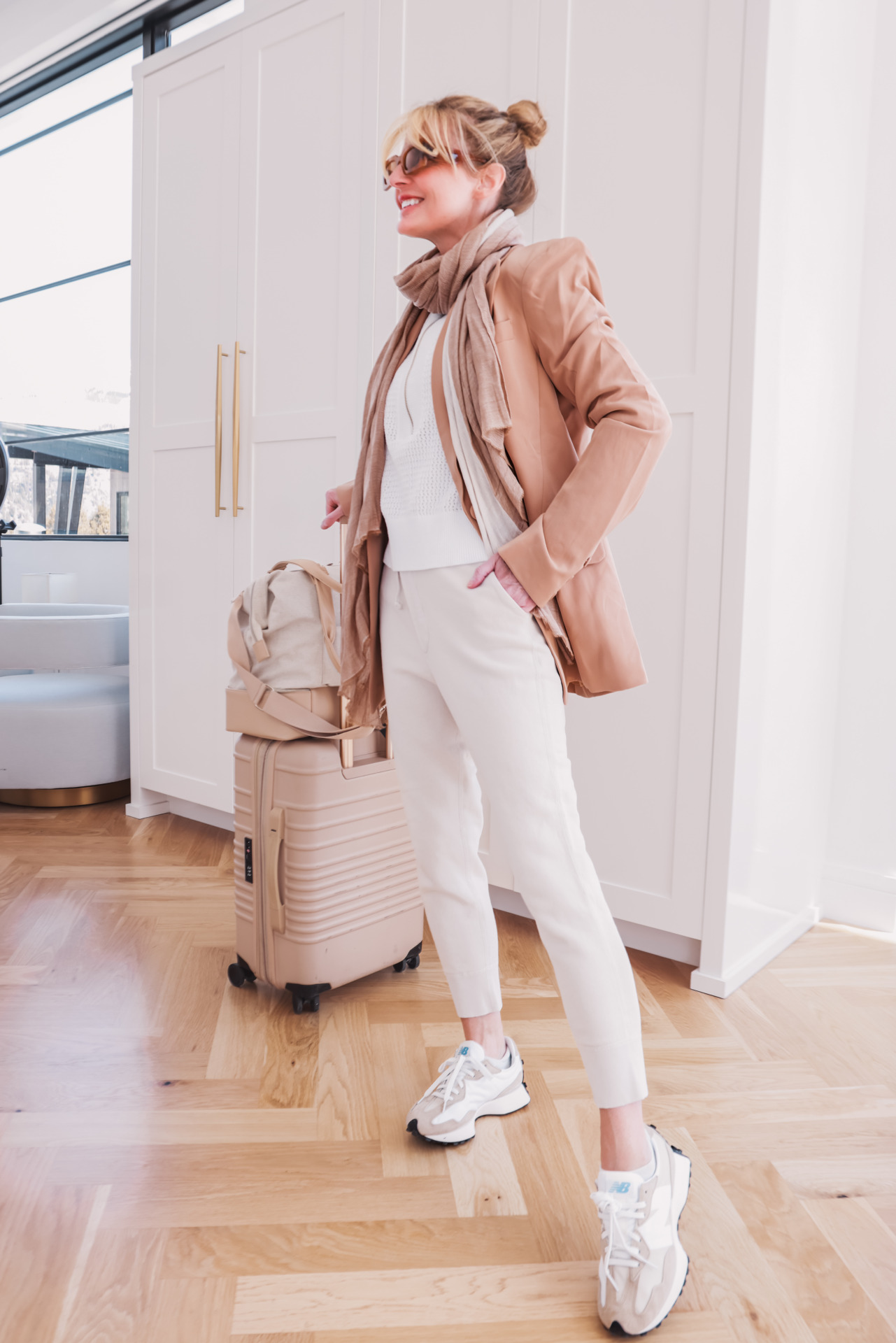
Vietnam Packing List in A Carry-on
The family packed everything in a carry-on suitcase for this trip due to the intensity of the travel. And let me tell you…packing for a 2-week trip in a carry-on suitcase, with an itinerary full of activities, in two countries with very different climates, was REALLY hard. As you can imagine, packing for such a diverse trip presented its set of challenges and learning curves. From the humid streets of Hanoi to the cool evenings in Beijing, each destination required thoughtful outfit planning to blend practicality with style. Along the way, I encountered a few packing hiccups—like underestimating the quick weather shifts! But I’ll share more about that at the end of the post.
Below, I’m sharing everything I packed for this trip, what worked, what didn’t, and what I would do differently. I hope that these insights will help you navigate your own Southeast Asia adventure with confidence and style.
Carry-On Vs. Checked
If you are a regular traveler then you know that the more intense the itinerary, the smarter and easier it is to carry on! You also know that packing with a carry-on versus a checked bag is a completely different game. I joked to a friend that it’s the difference between running a 3:30 marathon and a 5-hour marathon…it’s like a different sport! (A little running humor for all my marathoners! ;)) Checking a bag can make things a whole lot simpler on the front end, but it definitely eats into your travel time because you spend so much time waiting for bags. It also becomes more complicated if your bags get lost or you need to change a flight at the last minute. Having carry-on-only bags just makes the whole experience a lot more seamless.
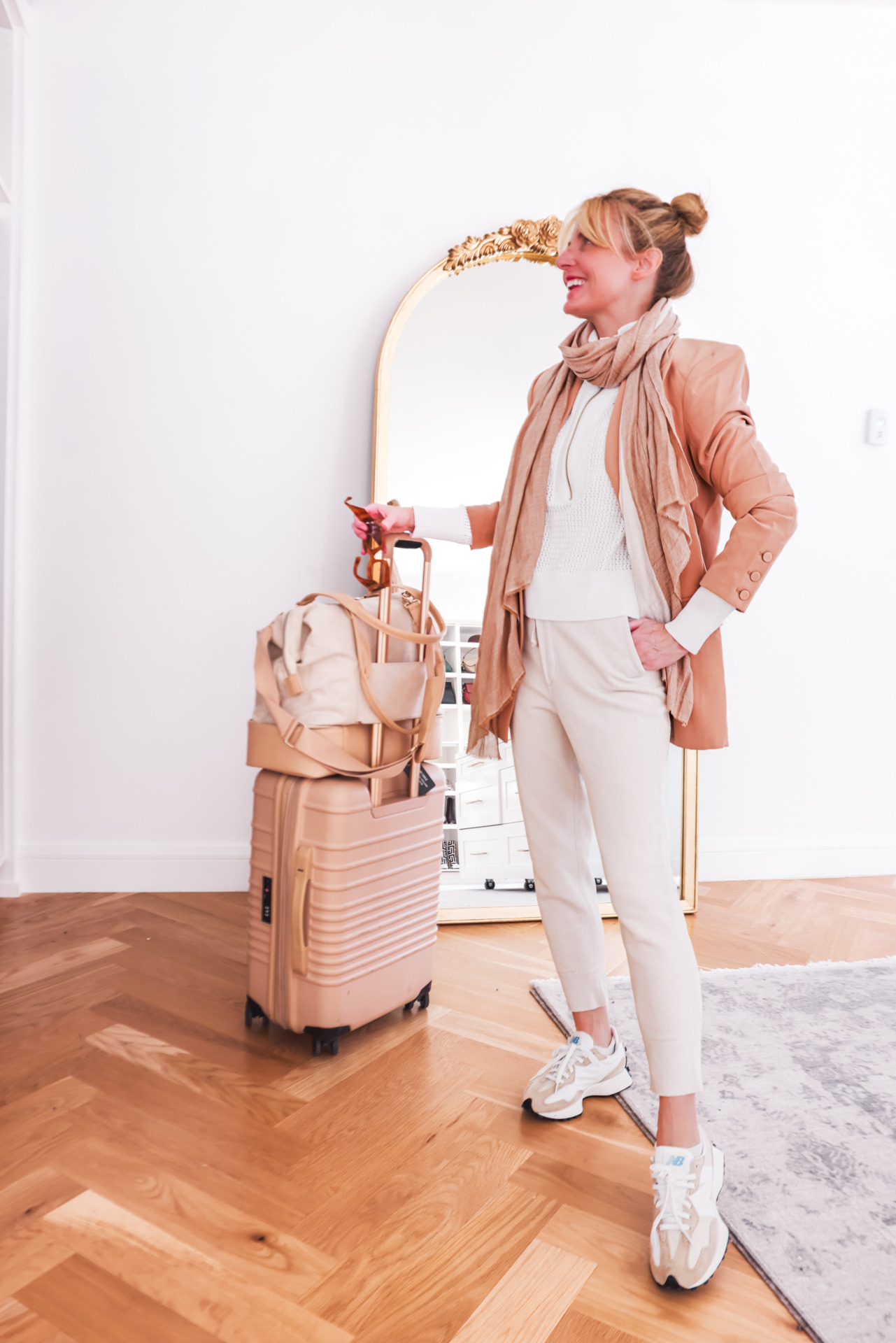
Outfit #1) Travel Outfit
Have you ever traveled really far distances?? Think 9, 10, 11, 12+ hour flights?? Our family has traveled all over the world including faraway destinations like Africa, Japan, and most recently Southeast Asia. One of the most important outfits when traveling is… the travel outfit itself. For me, it’s very important to look polished and pulled together of course, but to also be cozy and comfy AND wear some key layers you need on the trip. So…let’s start there. You’ll see these travel outfit pieces again and again throughout the rest of the post. I break it down in more detail including the strategic layering in this post , but here are the Cliff’s Notes.
On my top half, I have on a chic longline tan blazer by Camila Coelho over a white knit sweater by Varley. The blazer elevates the outfit, and I knew I’d use it as a sophisticated 3 rd layer for the rest of the trip. The Varley sweater was super lightweight, stylish, and breathable. It was the only sweater I packed for the trip, which was mistake #1. If we only went to Vietnam, taking one sweater would be perfect. But China was much cooler and more springlike than Vietnam was, and I should have packed 1-2 more sweaters for China. You can’t see it, but underneath the sweater, I’m wearing a white short-sleeve ATM tee that I wore throughout the trip as well.
On my bottom half, I’m wearing a pair of Nili Lotan jogger sweatpants in a super soft but breathable fabric. They have a drawstring waist, cool raw edge details, a slouchier fit, and a tapered leg. I wore these nonstop on the trip and you’ll see more ways I styled them next. I could have swapped my sweats for jeans or pleated pants, but I don’t think those are ideal on those long-haul flights and travel days.
On my feet, I have on a pair of New Balance sneakers that are comfortable and stylish and worked perfectly for days on our trip with lots of walking. Never underestimate the importance of comfortable shoes and happy feet while traveling! Shoes can literally make or break your experience! I completed the look with a neutral-colored scarf by Reiss that ended up being a heavy hitter in China!
Now let me show you 3 more ways I styled these pants during the trip…
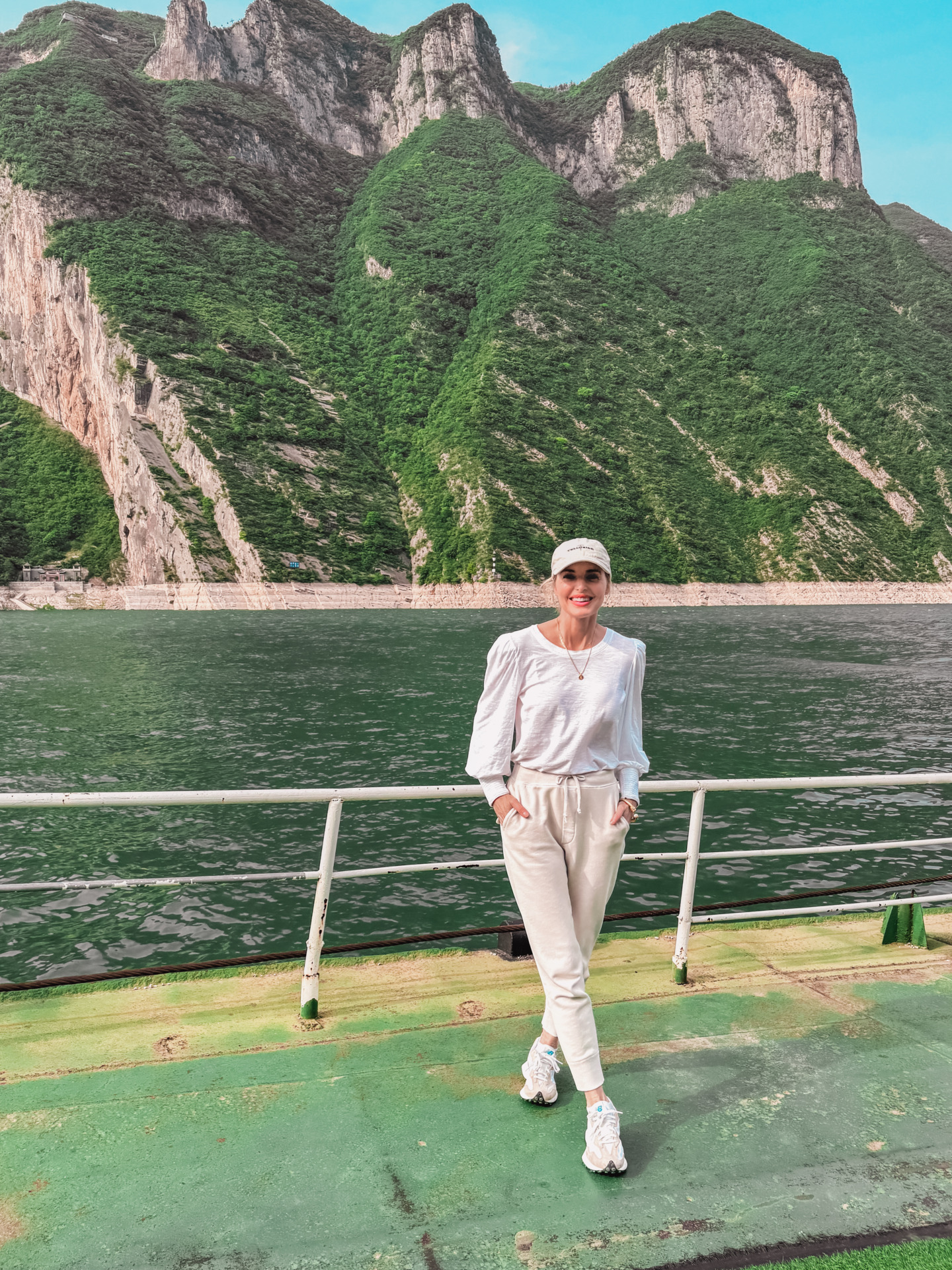
Outfit #2) Jogger Pants & White Tee
In this look, I styled the same Nili Lotan joggers with a white long-sleeve tee by Nation LTD. I love that this top has balloon sleeves and subtle puff shoulders that make it feel more elevated than a basic white tee. I completed the look with the same New Balance sneakers, the only two necklaces and bracelet I packed, and a Telluride baseball cap. I wore this while we were cruising down the Yangtze River in China. I wanted to be comfy, warm, but still look pulled together.
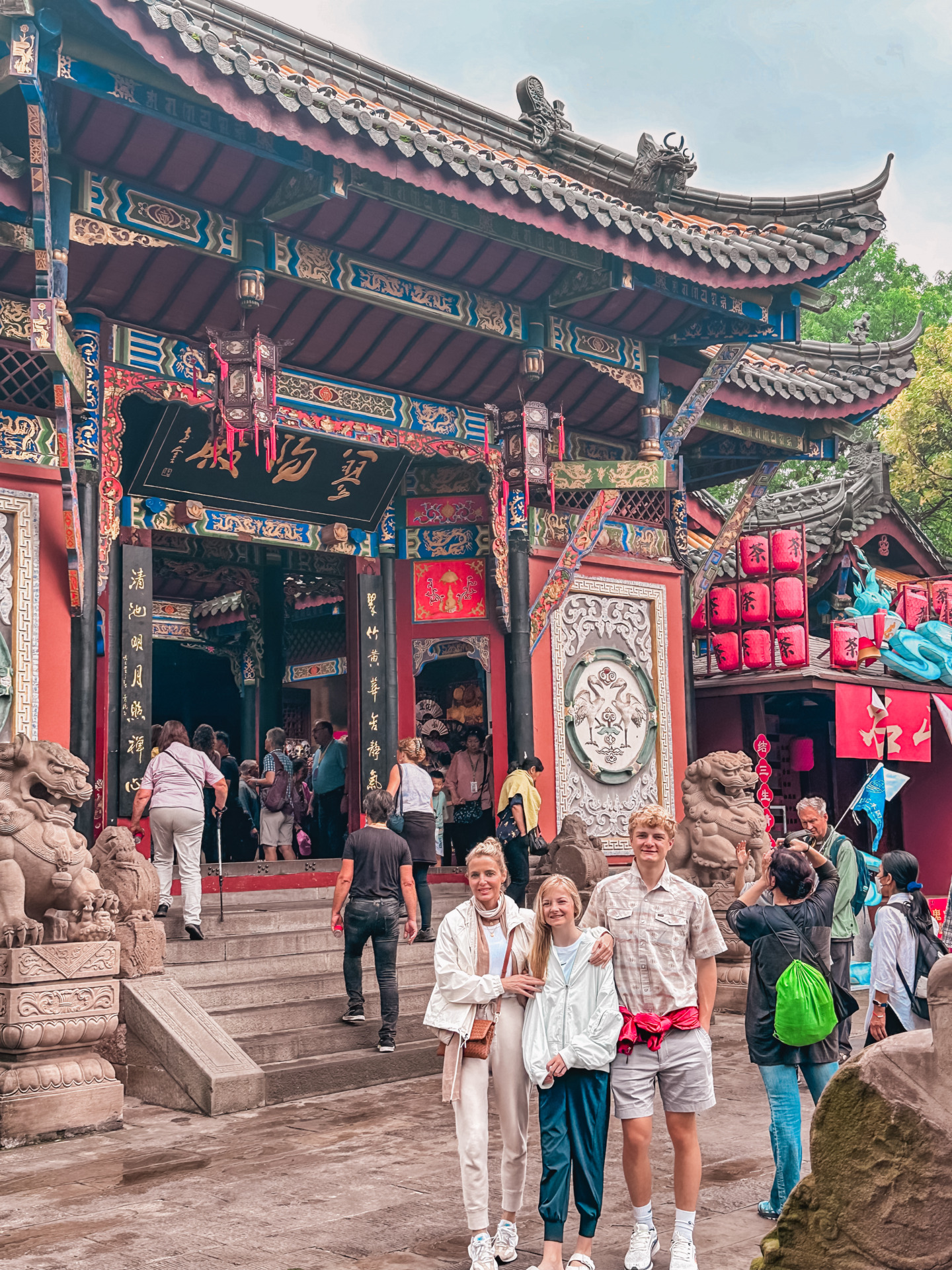
Outfit #3) Jogger Pants, Tank & Rain Jacket
Another tour day in China, I sported the same joggers. (Mistake #2, not packing another pair of pants for the chilly weather in China.) On my top half, I have on a ribbed tank by Splendid that’s super soft, stretchy, and comfortable. I layered my North Face rain jacket over it because there was a high chance of rain, and threw on the Reiss scarf for extra warmth. I completed the look with the same sneakers and a tan Quince crossbody. This crossbody was perfect for the trip and the only bag I brought…I loved the size, weight ( it’s light as air ), crossbody functionality, versatile color, and fold-over style. The bag also looks very much like a Bottega Veneta bag, only for SO much less money. Plus, you don’t have to worry about ruining it on the trip like I pretty much did with my BV Cassette bag .
A moment to discuss The North Face rain jacket, if I may? I LOVE this neutral color and slightly looser fit. I am always torn between bringing technical gear you need and the fashion factor. This is still a technical jacket, but the color and fit made it feel more stylish and chic.

Outfit #4) Jogger Pants & Sweater
Another day, another way I styled the joggers. 😉 This time, I’m back to my travel outfit basics pairing them with the white Varley sweater. I wore this outfit while we were in Vietnam on Ha Long Bay visiting a cave ( more about this and the rest of our trip coming tomorrow ). Since we were in warm Vietnam, and it was warmer, I didn’t need a scarf or a third layer. I completed the look with the same sneakers and my everyday jewelry. BTW, can you believe how tall Gage is??
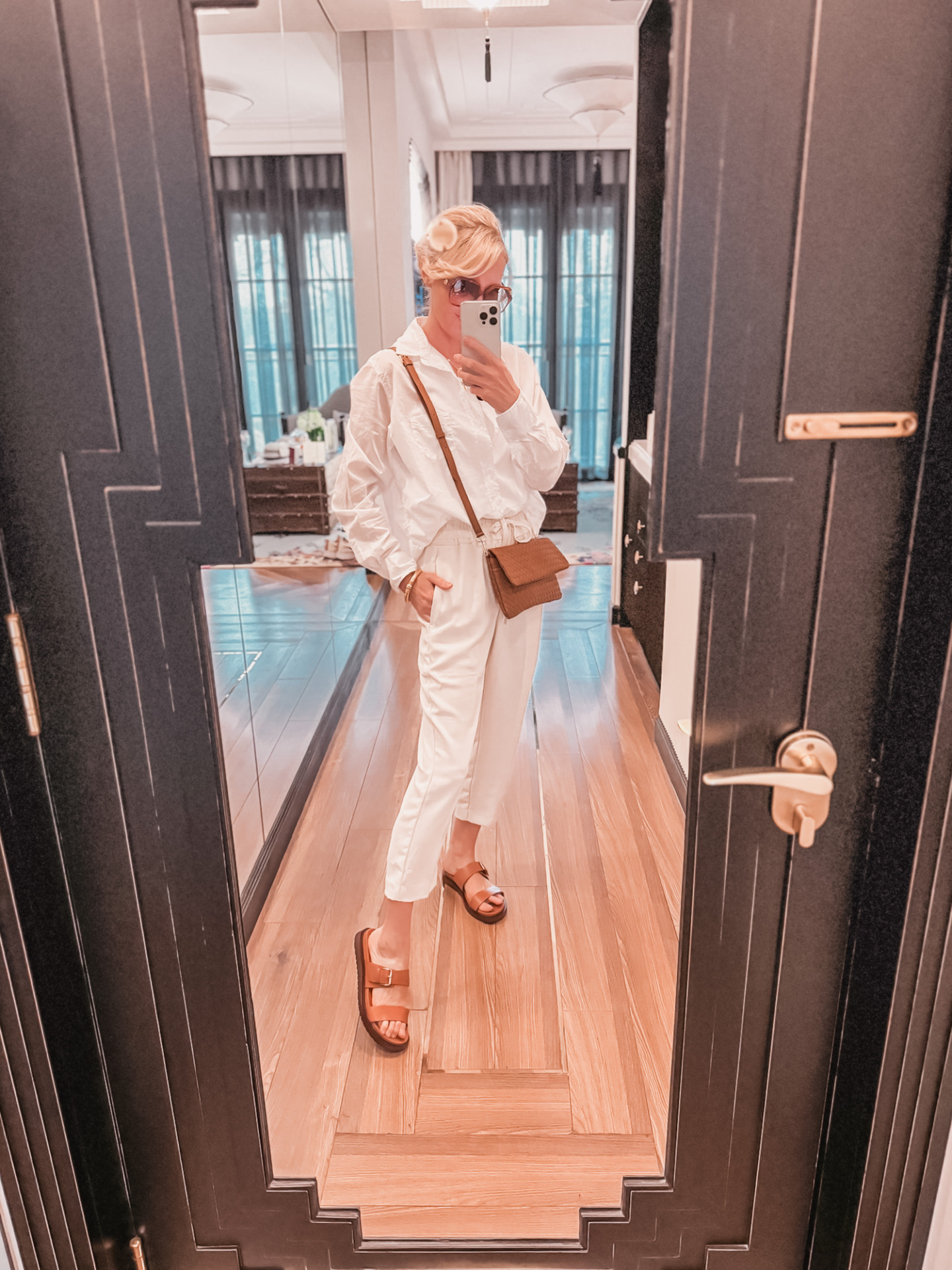
Outfit #5) Trouser Pants & White Button-Down Shirt
For a day of touring and sightseeing in Hanoi, I wore these ivory trouser pants by Reiss. I love the drawstring waist, roomier legs, and breathable fabric. I bought them in petite and they’re perfect on me. I definitely wanted cropped pants for Vietnam because anything long would get too dirty on the streets and in the markets. I styled the tapered pants with a white button-down shirt by Frank and Eileen and the same ribbed Splendid tank. I liked having the tank underneath in case I got hot, but we were going into a few places where my arms needed to be covered so the long-sleeved shirt felt necessary. On my feet, I’m wearing a pair of super comfortable double-strap sandals by Madewell. We walked for hours, and these never hurt my feet. Even if you’re not headed on a trip, these are a great pair of sandals to have in your closet! ( For those familiar with the Birkenstock fit, these Madewell sandals are similar-ish, but show less “toes,” which I appreciate. )
One of my takeaways from the super humid climate, that activewear fabric is probably the way to go. I know, I know…cotton and linen are often the gold standard, but even in the picture above you can see how my button-down is kind of wilting. Tech fabric with dry wicking would have held up better and I think there are so many options now that combine fashion and function.
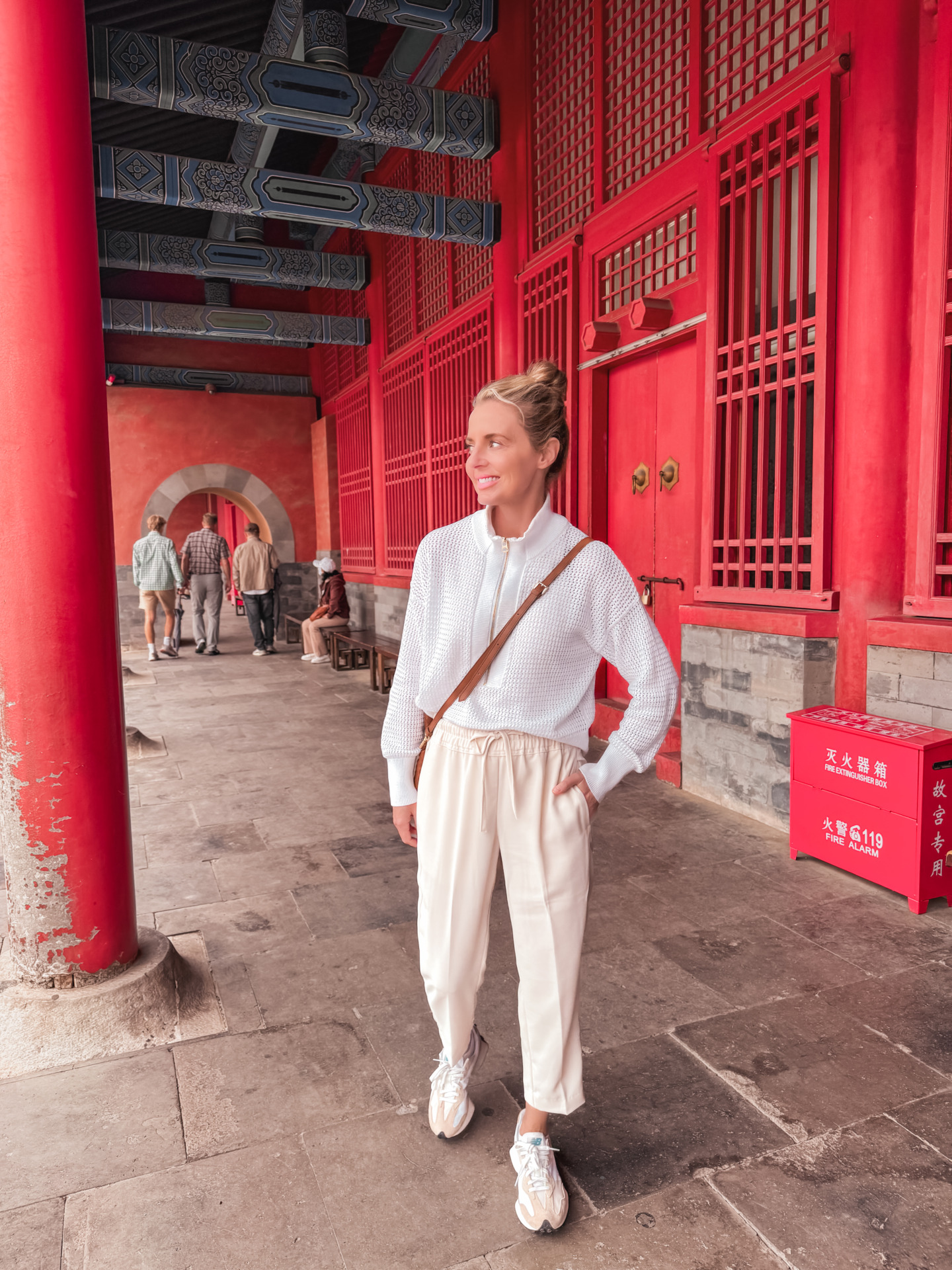
Outfit #6) Trouser Pants, Knit Sweater & Puffer
I styled the same Reiss pants with the white Varley sweater and New Balance sneakers for another day of sightseeing in China. If you’re getting tired of seeing this sweater by now…so was I by the time we got to China! I literally wanted to burn everything in my suitcase ;). The sweater is SO great, though. Truly. But, I DO wish I had packed just one more sweater to mix things up. When it was much cooler (think 50’s, 60’s), I threw on this 3/4 sleeve, Herno puffer jacket. This puffer jacket is unbelievably lightweight and packs beautifully taking up almost NO space in your suitcase. It’s the perfect travel piece for any trip you have coming up, even Europe in the summer.
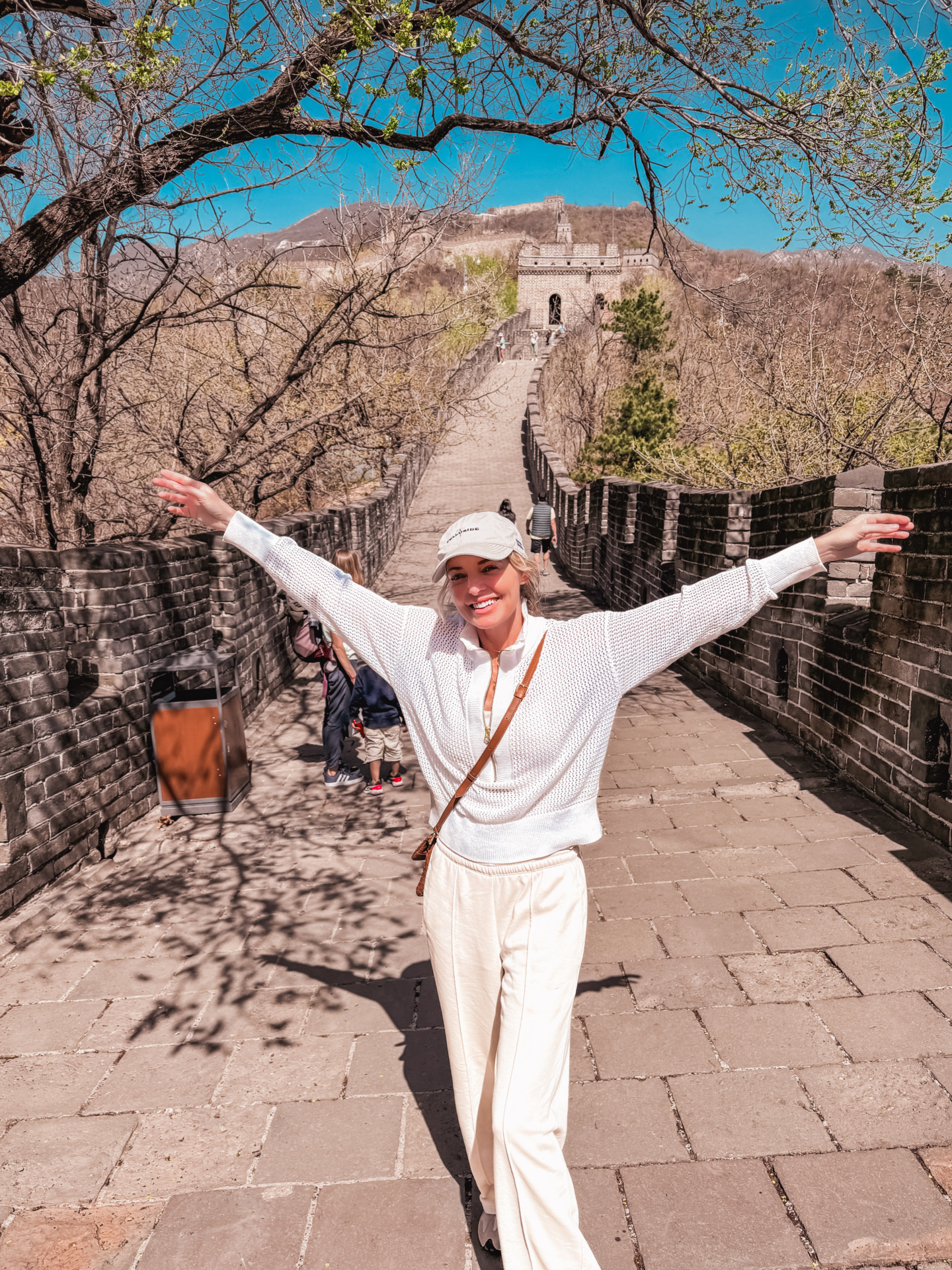
Outfit #7) Wide Leg Pants, Knit Sweater & Puffer
While in China, we popped into the Nike store to grab Gage some new sneakers, and I was SO excited to buy another pair of pants. Yes, they are sweats, but I didn’t care. I was so sick of the 2-pairs of pants that I had, I was practically giddy over the purchase! The color and silhouette of the pants felt elevated and exciting. These pants are also very comfortable, versatile, and paired perfectly with the rest of the items I packed. Have you noticed the neutral color story yet?? 😉 I styled the wide-leg sweats with the white sweater and threw on the Herno puffer for added warmth. And, did you see, I’m standing on the Great Wall of China! It was ‘a moment’ for sure!
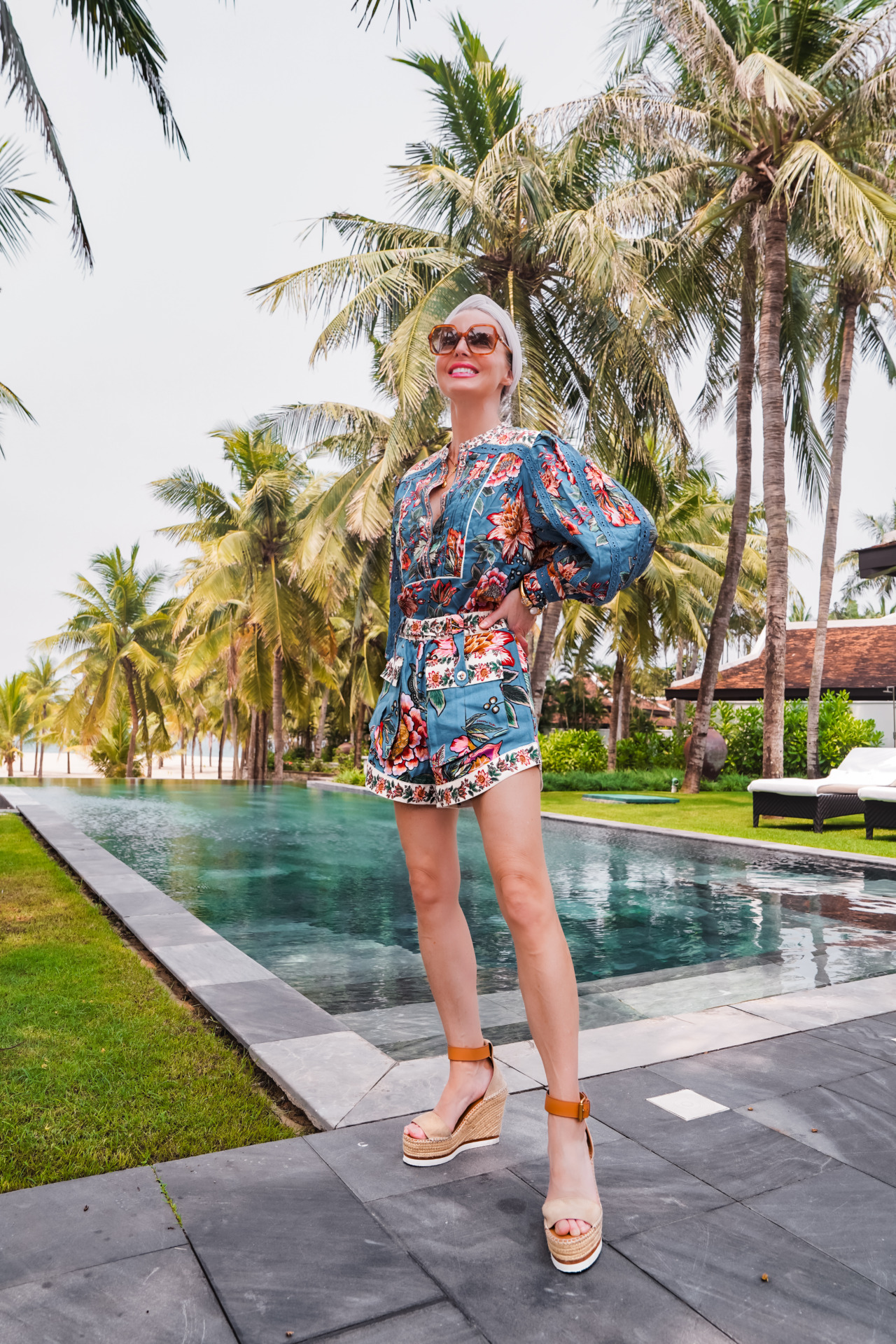
Outfit #8) Printed Top & Matching Shorts
Now that we’ve covered all the neutral, classic, everyday outfits, I wanted to show you some of the “fun” items I brought to mix in with the neutral pieces. First up is this pretty blue printed Farm Rio top and matching shorts. I love this print because it’s so unique and the blue is a great color for my skin tone. I wore this around our hotel and on a night out to dinner in Hoi An, but I did swap the shoes for a pair of espadrilles (you’ll see in the next look) when we went to dinner. The other amazing thing about packing matching sets like this is that you can mix and match them with other pieces…

Outfit #9) White Tee & Printed Shorts
I styled the blue printed Farm Rio shorts with the white long-sleeve Nation LTD tee that definitely made the shorts feel a little more casual. Styling them with a pair of espadrilles also helped dress them down a bit. These Sam Edelman espadrille loafers are 1 of 4 pairs of shoes that I took on this trip and I really loved that these elevated an outfit but still felt casual and were super comfortable. Packing note: I typically only bring 3 pairs of shoes total, including the pair I wear on the plane, but I pushed it on this trip and brought 4.
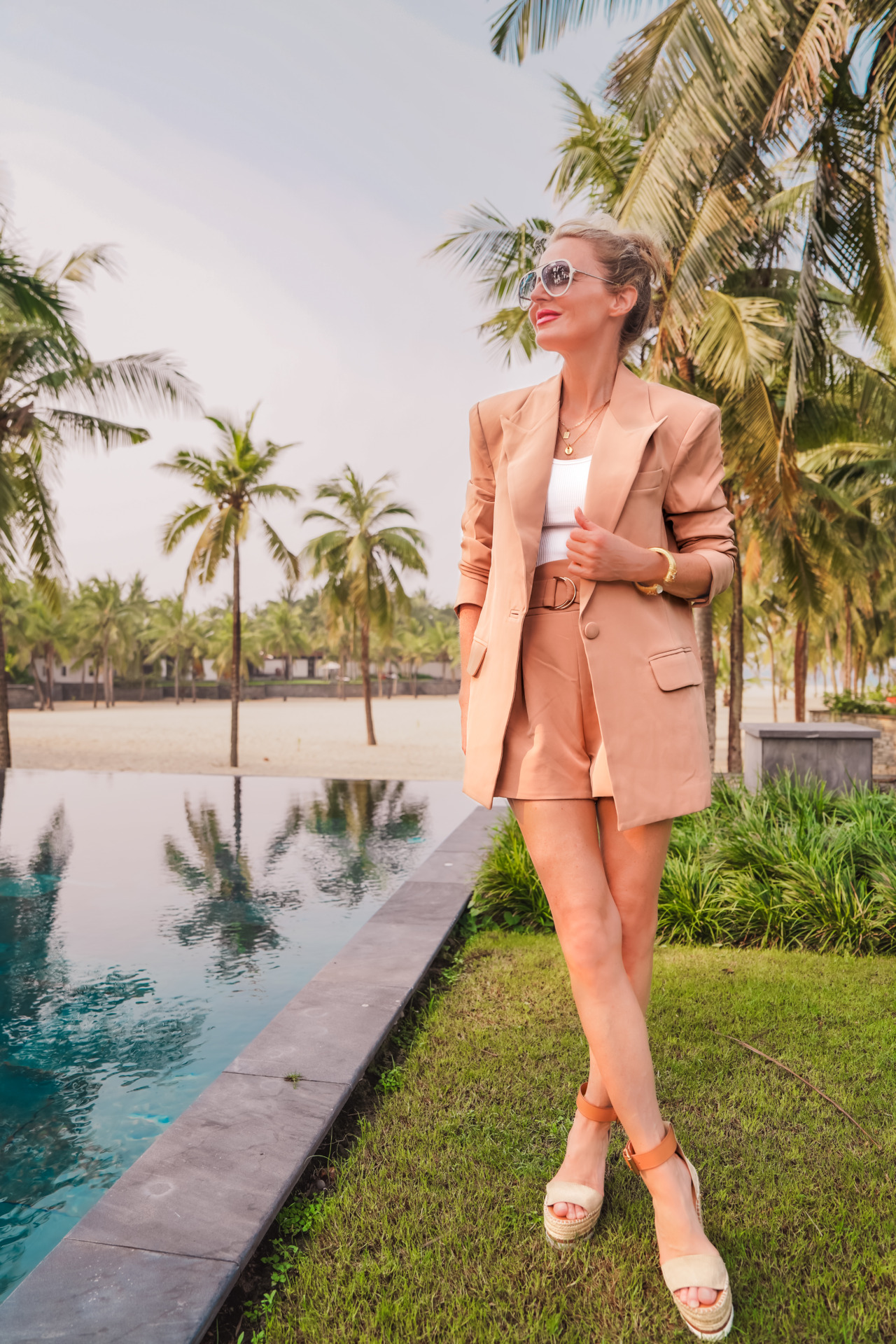
Outfit #10) Tan Blazer & Matching Shorts
Remember this Camila Coelho blazer I wore on travel day? Well, I also packed the matching shorts! I wore this look to dinner and a show in Hanoi and felt pulled together and chic. I wore the ribbed Splendid tank underneath to keep it comfortable and casual and completed the look with a pair of espadrille wedges. I also wore the same outfit with flat espadrille loafers. We walked a long way and I had not broken in these shoes properly (mistake #3). I often feel compelled to bring new shoes on trips so I can recommend them to you all, but it’s a rookie travel mistake. You should only bring shoes that are tried and tested so you won’t have issues. I DID bring my blister kit so I was able to doctor up my heels and carry on with the trip without a problem. Please , please, please….learn from my repeated mistake, don’t pack new shoes!!
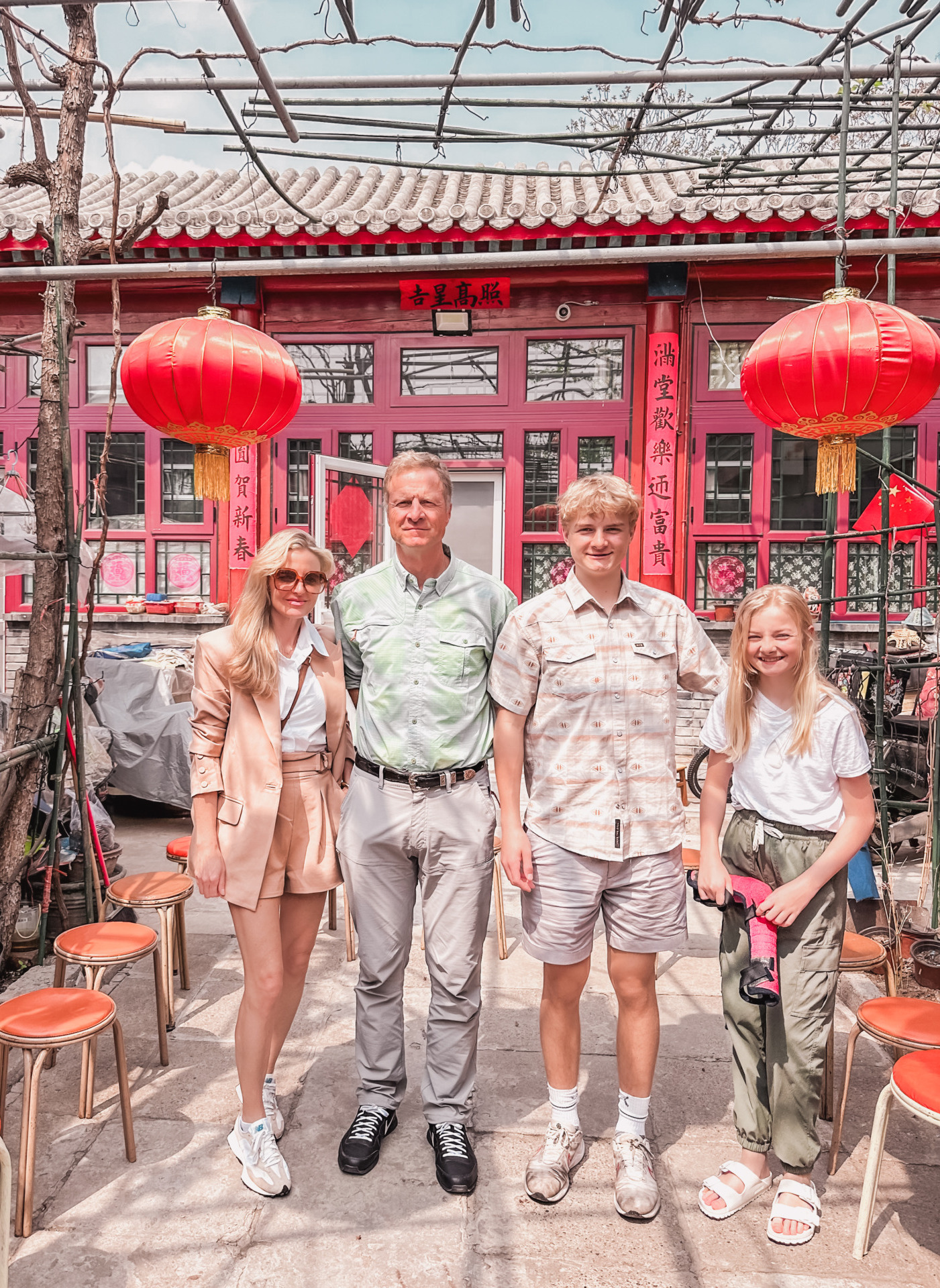
Outfit #11) Tan Blazer, Matching Shorts & White Button-Down Top
Another way I wore the blazer and shorts was for a day of sightseeing, but I swapped the wedges and loafers for my New Balance sneakers. This was merely a survival move as my poor heel blisters couldn’t handle anything else. I also swapped the tank for a white short-sleeve button-down shirt by Hevron. I’ve worn this top with a lot of different bottoms and love the fit, rolled sleeves, and collar. It made the overall outfit feel more polished. By the way, the family picture above was taken at a private residence in Beijing where we ate lunch. It doesn’t look like much, but it was worth an estimated $10 million dollars!! The house didn’t even have a bathroom. Because there is such a huge population, there is a premium on “houses” in Beijing.

Outfit #12) White Top & Denim Shorts
While we were on the trip, I didn’t have time to snap a picture of everything but I did take photos of all my outfits before I left. In this look, I’m wearing a white gauzy cotton top by Bobi that can be worn on or off the shoulders. I styled it with a pair of denim shorts by Moussy Vintage that I’ve had for years and come with me on pretty much every trip I’ve been on…yes, they’re that good! I completed the look with a reversible belt, the Madewell sandals, and a crossbody bag.
One of my biggest packing tips? Take photos of your outfits so you remember what you were going to wear for each day. Find more of my packing tips here .

Outfit #13) Black Cotton Top & Shorts
I love this top so much that I also bought it in black! This is the same Bobi cotton top styled with a pair of black cotton shorts. The shorts have a drawstring waist and pockets. This top and shorts combo is great, but I really loved being able to wear these pieces separately too. For example, I even wore the shorts as a swim coverup while we were hanging out by the pool and beach in Hoi An, Vietnam.
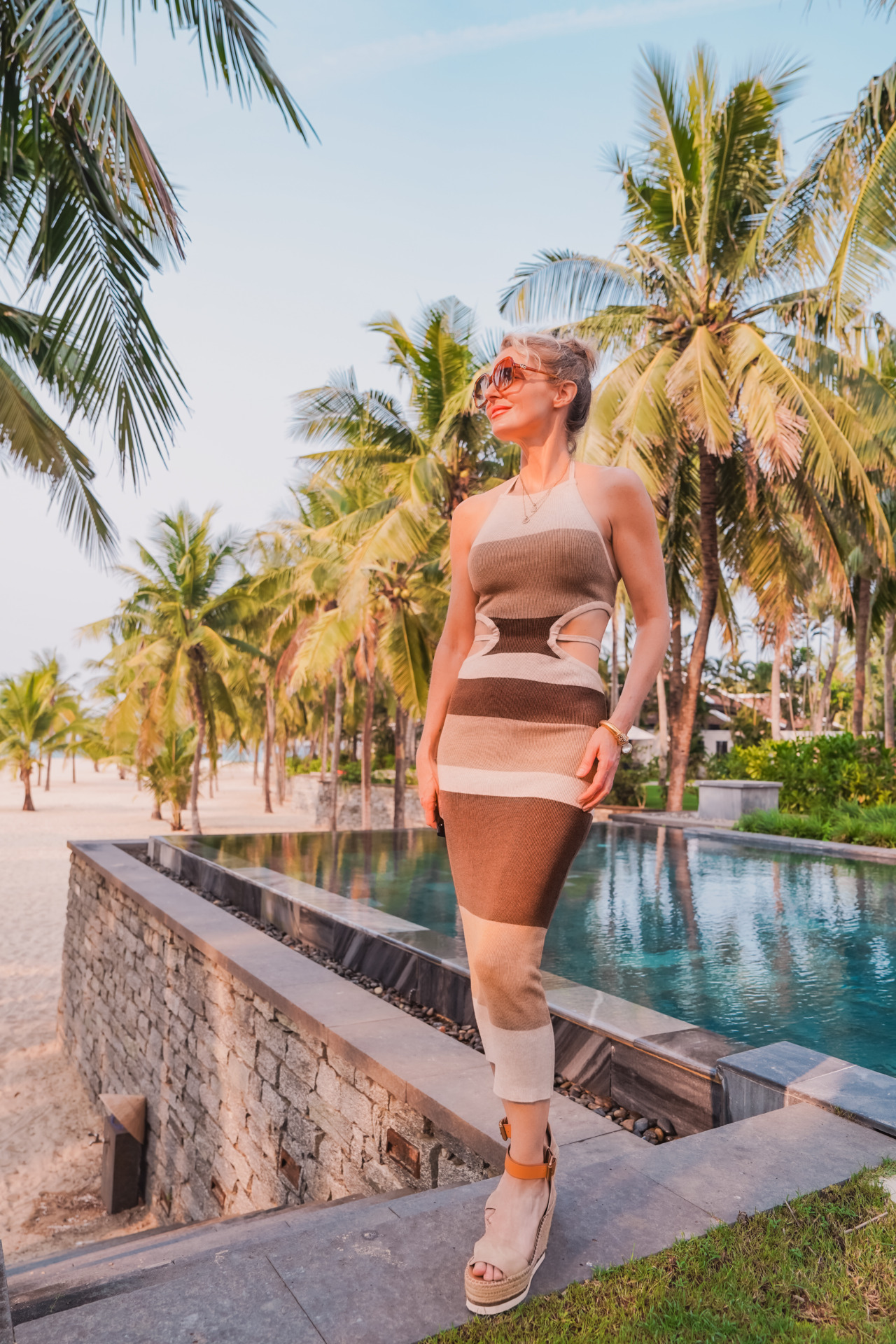
Outfit #14) Printed Dress
While you’re on a trip like this you don’t need too many dressy pieces since most of what you’re doing is more casual and activity-heavy. But having a few items that you can wear to nicer dinners or when you want to feel sexier, and more feminine is ideal. I really cherished being able to wear my dressier options. I brought 3 dresses and 1 jumpsuit total, I definitely could have left one of my dresses behind.
I loved wearing this super sexy sweater dress by Camila Coelho above especially after wearing sweats for so long! The neutral colors are gorgeous, the cutouts are sexy, the length is perfect, and I love the halter neckline. I wore this to dinner one night in Vietnam ( it was too chilly in China ). I paired the dress with my See by Chloe espadrille wedges. If you’ve been a long-time reader, these will come as no surprise. I bring them on almost every trip. They provide maximum height while also being very comfortable and easy to walk in.

Outfit #15) Black Jumpsuit
Oh, thank goodness for this Reiss jumpsuit! I could wear this beauty during the day with flats and also wear it out to dinner. It was a go-to piece on the trip and I was so happy wearing it!! The wide-leg silhouette and the contrasting white trim make this jumpsuit incredibly flattering. It also has such beautiful movement. The fabric is breathable and comfortable. I was able to wear this piece in both Vietnam and China and always felt chic when I put it on. I bought it in the petite length. Shopping note for my petite beauties: the Reiss petite selection is quite inspiring! The pieces ship from the UK, but they arrived pretty quickly and included an adhesive return label if the size doesn’t work. Yay for those! Also, I think when you are packing light, pick pieces that WILL transition beautifully from day to night like this jumpsuit. The sweater dress above was great and sexy, but I only wore it one night. In hindsight, I could have brought another jumpsuit or another pair of pants!

Outfit #16) Black Dress
The last dress I wanted to share with you is this activewear dress by Sweaty Betty. This is the greatest travel dress for a hot and humid climate…maybe ever! The fabric is lightweight, breathable, and moisture-wicking…which was a must in the Vietnamese humidity. You can wear it with a racerback sports bra or a tank underneath. And it’s very comfortable. I wore it with sandals, but you could also wear it with sneakers. This was the perfect casual look for day and night walking around Hoi An. If you’re interested in hearing more about my thoughts on the spectacular and surprising Hoi An, be sure to check back for tomorrow’s post…

We did two different boat cruises and stayed on the beach in Vietnam so I knew I’d be around water, which is why I packed three swimsuits. The first is a black Trina Turk off-shoulder bikini top and high-waisted bikini bottoms by Becca. I’ve owned both these pieces for years and take them on every trip. I love the comfort and coverage of both the top and bottoms. The next two swimsuits are by Staud. The first is a cool black and white swim top and skort that is so different and chic. The third was a white and black one-piece swimsuit with very flattering cutout details at the sides that create the illusion of a smaller waist. I have the same suit in black. I accidentally left this suit in Vietnam :(.

PJs & Activewear
And of course, don’t forget your PJs and activewear! I packed one pair of pajamas by Eberjay that were super soft and comfy. For activewear, I brought a Beach Riot set in order to do my Tracy Anderson Method “Continuity” workouts (30 minutes). I was able to workout on almost all the days we were not traveling which helped me keep my energy up and feel better about myself and life in general. I also brought this adorable Free People “runsie” thinking I would use it for hiking and/or sightseeing. It was simply too cold to wear on this trip, but I plan to bring it with me on our river raft trip this summer. The neutral color theme continues…!

The Only Piece I Didn’t Wear…
I wore every almost single piece of clothing I packed (most of them multiple times) except for this pink Hemant & Nandita dress. If we had stayed longer in Hoi An, Vietnam, I definitely would have worn it, but we only had a few nights there and it was too chilly in Hanoi, Ha Long Bay, and in China. That said, I LOVE this dress and wore it in Belize…and plan to wear it again this summer. I think all things considered, it’s pretty amazing that there are only 2 pieces I didn’t wear: this dress and the runsie.

Simple Vietnam Packing List Breakdown
The photo above cracks me up! I feel like if our family had an album cover, this would be it. The BUSBEE Family Band!
I created a resource that you should definitely take advantage of if you plan to travel to Southeast Asia in the spring. I tweaked my original packing list because I didn’t want you to make the same mistakes I did. Here’s a quick rundown of what I packed:

Tops : White short-sleeve tee, white long-sleeve tee, white tank, 2 white short-sleeve tops, 1 black top, 1 printed top, 1 lightweight sweater Bottoms : Tapered pants, 2 sweatpants, denim shorts, cotton shorts, printed shorts, neutral shorts Dresses : Printed dress (for night), chic jumpsuit (day or night), casual dress (day or night) Outerwear : Rain jacket, lightweight puffer jacket, blazer Swim & Other : 2-3 swimsuits, workout set, pajamas Shoes : Sandals, sneakers, wedges, loafers Accessories : Packable hat, baseball cap, reversible belt, 2-5 pairs of sunglasses, scarf, crossbody bag Jewelry : Layered necklaces, cuff, earrings
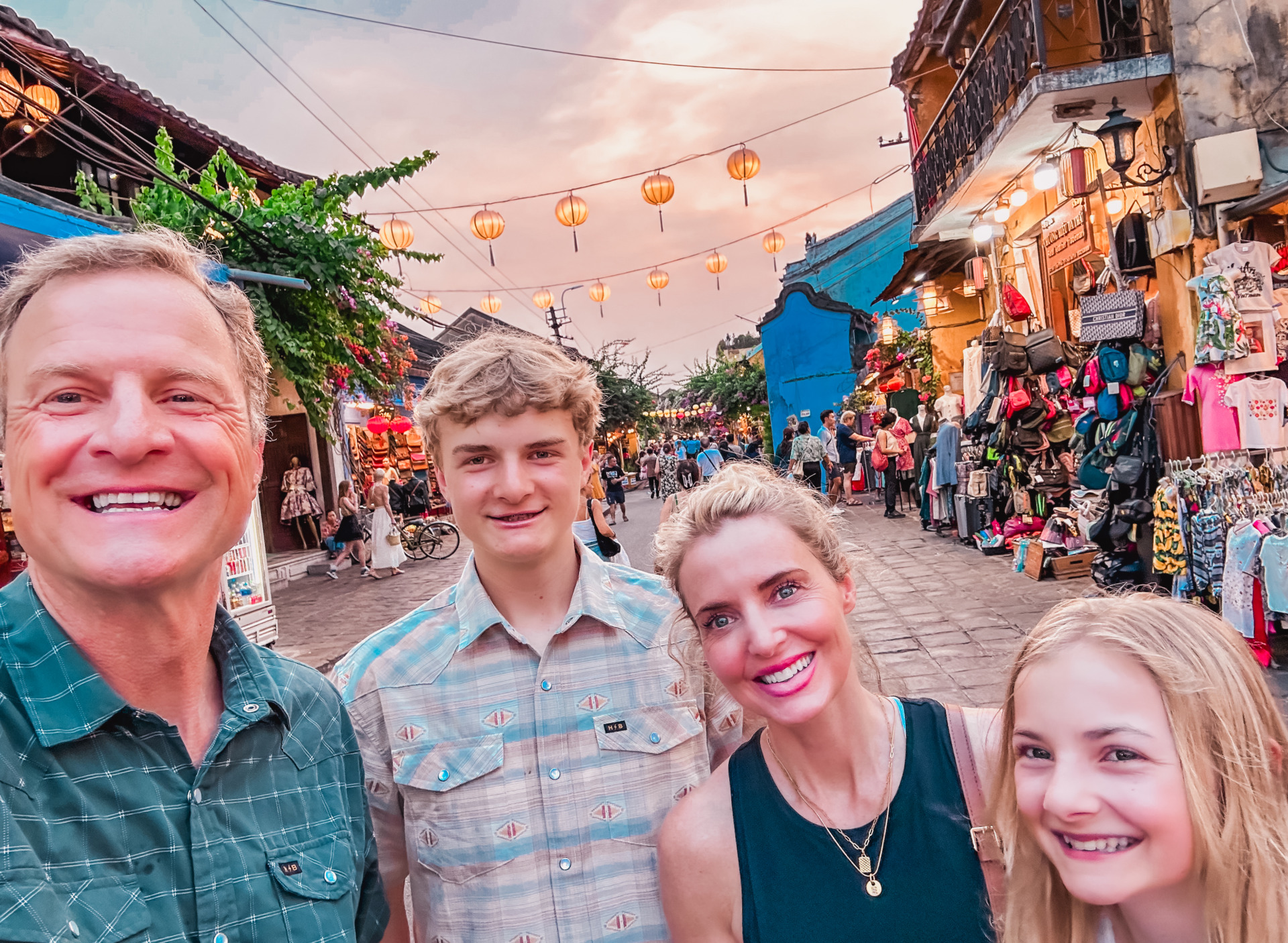
Vietnam Packing Mistakes
Mistake #1: I severely underestimated how cold China was going to be. If I had known, I would have packed at least one more sweater, a pair of jeans, and another pair of pants. If we had just stayed in Vietnam, or spent less time in China, more time in Vietnam, my packing would have been perfect!
Mistake #2: I didn’t pack enough warmer elevated pieces that I could wear out to dinner on cool nights. If I did it again, I’d pack at least one more elevated dress or jumpsuit that I could wear with my blazer or puffer.
Planning a trip to Vietnam and/or China soon and have questions? Leave a comment below…we’re happy to help!
And, be sure to subscribe to our newsletter here , so you don’t miss out on all the exciting travel we have coming. Plus, you get access to tons of incredible FREE style resources!

Get Our FREE Wardrobe Basics Checklists, Capsule Wardrobes & More!
Sign up and you instantly receive… FREE Wardrobe Basics Checklists, Closet Editing & Organizing Checklists, Zoom Call Tips, Capsule Wardrobe Shopping Suggestions and a Lookbook of outfit ideas! You can download and print all of these.
Save my name, email, and website in this browser for the next time I comment.
Explore More
How to expertly build your travel outfit to save room in your suitcase, demystifying semi-formal attire for women – 10 elegant outfits & style tips, 5 best unique floral printed dresses for summer.

Your *TOP 5* Favorite Products of April!


China is trying to connect Southeast Asia by high-speed rail. Here’s how that’s going
I magine jumping on a train in southwestern China, traveling some 2,000 miles and arriving in Singapore – less than 30 hours later.
That’s the scenario China is envisioning for Southeast Asia as part of its Belt and Road Initiative (BRI), a vast overseas infrastructure development program that launched more than a decade ago.
In 2021, the semi-high-speed Laos-China Railway opened to passengers, connecting the southwestern Chinese commercial hub of Kunming to the Laotian capital of Vientiane – a roughly 10-hour journey spanning some 1,000 kilometers (621 miles) that officials claim has boosted numbers of overland Chinese travelers while greatly benefiting local vendors and businesses in the tiny land-locked country.
Also with China’s help, Southeast Asia’s first bullet train began operating in Indonesia in October 2023 following years of setbacks and delays, connecting the capital Jakarta with Bandung in West Java, one of the country’s biggest cities and a significant arts and cultural hub.
Meanwhile, a second high-speed rail project is underway in Thailand, which aims to connect the Laos-China Railway with Bangkok – but is now facing further delays and mounting construction costs. Launching in phases, the Thai government currently expects the full line to be operational by 2028. The Chinese government has not detailed a timeline.
The project, seen by some analysts as a ‘ fiscal trap ’, has been a source of heated debate and scrutiny in Thailand, with the government agreeing to shoulder the full construction cost of $5 billion (179 billion baht) for the first building phase, reported Reuters. The Chinese side will be responsible for installing systems, design, and procurement of trains.
And when that line is finally complete, the plan is to expand into northern Malaysia , where it will connect to the capital Kuala Lumpur before finally ending 350 kilometers (218 miles) down south in Singapore .
In January, bids by local and international consortiums were submitted for the lucrative project. But Japanese firms, including the East Japan Railway Co, reportedly pulled out after deciding that it would be too risky without official financial support from the Malaysian government.
“China already boasts the world’s largest high-speed railway network and Chinese firms have long been looking to sell and export their infrastructure technology to other countries,” says travel and consumer trends analyst Gary Bowerman, founder of Check-in Asia, a tourism-focused research and marketing company.
Southeast Asia is the “obvious” choice because of its “proximity to China,” Bowerman adds.
“Connecting mainland cities by train directly into Laos and other Southeast Asian countries (down the line) will make it easy, and advantageous, for Chinese travelers – many who aren’t looking to travel long distances, for long periods of time.”
Southeast Asia’s appeal
Offering everything from ancient temples in Laos and pristine beaches in Thailand to lush rainforests and eco-tours in Malaysia, Southeast Asia has long been a big draw for Chinese travelers, experts note.
“Many countries share borders and long histories with China,” says political economist Pon Souvannaseng, assistant professor of global studies at Bentley University in the US.
“China of course, sees Southeast Asia as a key market for export as well as a key area for security and I think, ultimately wants to see Southeast Asian countries within its sphere of geopolitical influence.”
Interestingly, the region’s large Chinese diaspora is another big draw, experts add.
“Cities like Penang and Malacca in Malaysia and Phuket Old Town, with temples and architecture, were built by Chinese immigrants and are very popular with Chinese tourists because of their historical and cultural links,” says Bowerman.
Adding to this is the rise in popularity of rail travel – especially among younger Chinese tourists, many whom are committed to sustainable travel and looking for a new sense of adventure, Bowerman adds.
Pan Wenbo, a 30-year-old security practitioner from Beijing, tells CNN that taking an epic train journey across Southeast Asia from his country, as opposed to flying, would have to be cheap and offer plenty of scenic views along the way. Pan has visited Thailand, Singapore, Vietnam and the Philippines in the past five years and says he is keen to explore other countries in the region.
Others like university student Mei Wei have taken travel tips and inspiration from popular influencers on Chinese social media apps like Douyin – China’s version of TikTok – and Youku, the Chinese YouTube.
Thanks to several travel videos she has seen in recent months, Wei says she is now planning a summer trip to Laos, Cambodia and possibly Thailand, to visit “unique attractions” like the Angkor Wat temple complex in Siem Reap.
She told CNN that she is particularly excited about traveling by train.
“I’m not a big fan of flying. In China, I love taking trains because you get to see more on the ground (as compared to being on a plane from above) and travel more directly into the heart of cities.”
“It also helps that prices are usually consistent and cheaper than booking flights when you are at the mercy of airlines,” she adds.
Challenges and controversies
China’s Belt and Road Initiative was launched at the beginning of Xi Jinping’s presidency.
In addition to high-speed railways, multi-billion dollar sea bridges and highways , ports, airports, power plants and telecommunication networks are all playing a fundamental part in creating the new “Silk Road” that the ruling Chinese Communist Party desires.
A lot of these projects, like the China-Laos Railway, were designed with economic interests in mind, experts say. According to Chinese state media , the China-Laos Railway cumulatively transported 4.22 million tons of freight in 2023, an increase of 94.91% year-on-year.
Political economist Souvannaseng, who rode the train months after passenger services launched in April 2023, said it was “very clearly, even near the full construction and inauguration” a project for cargo transfer, with China and Thailand being the main nodes for trade and Laos being left footing the bill for the massive project.
“It reminds me a lot of the Orient Express and the way it benefitted the Hapsburg and Ottoman empires while the hinterland Balkan territories were saddled with that debt and it hampered their economies well over a century later.”
Chinese-funded and supported infrastructure projects are also widely viewed with suspicion and have been lambasted as attempts by Beijing to boost influence and gain control over smaller neighboring countries while having massive financial consequences for struggling countries.
“Beijing, I think, ultimately wants to see Southeast Asian countries within its sphere of geopolitical influence. These projects have always been in Beijing’s strategic and geopolitical interests,” says Souvannaseng, who highlights the financial burden placed on Laos following its multi-billion dollar Chinese-funded railway project.
“Money that was loaned to the Lao government through Chinese sovereign lending, has to be re-paid and soon. The immediate impact of that external debt for Laos is evident in the recurrent stress and fiscal crisis, and consequences for Lao society at large is pretty evident.”
In Malaysia, where planning for a high-speed railway with neighboring Singapore is taking place, many experts have continually voiced strong opposition and exercised caution about sovereignty. Some have drawn parallels with the West Kowloon rail station in Hong Kong that opened to much fanfare as well as controversy in 2018.
The $10.75 billion infrastructure investment connects Hong Kong to 44 mainland Chinese destinations, including major cities like Beijing and Shanghai. But it also allows mainland Chinese law to be applied on a section of the Hong Kong terminal station, a contentious arrangement that drew heated public criticism for undermining the city’s autonomy.
Officials, on both sides, defended the station and high-speed railway as a tool to boost economic opportunities and a “convenient means of cross-boundary transport.” But critics – many in Hong Kong – said it was a development neither wanted nor asked for.
“It has to do with fear, resentment and anxiety over China and perceptions of Hong Kong’s diminished standing vis-a-vis China,” experts told CNN at the time of its opening.
“Any cross-country infrastructure will certainly involve multiple countries and governments and will concern the issue of sovereignty and laws,” says Wong Muh Rong, managing director and founder of corporate advisory firm Astramina Advisory in Kuala Lumpur. “In addition to costs, that in itself is a ginormous thing and not something that can be addressed easily.”
Wong reiterated that while there were “definite advantages” to high-speed trains, the decision to build and launch one has to be balanced with costs and benefits.
“In the example of a high-speed railway line between Malaysia and Singapore, Singapore would likely have just one stop – Malaysia would have more,” Wong told CNN. “But who will have the ultimate say? And if additional external funding comes from China, it will make things even more complicated.
“For now at least, there is no need for a high-speed rail line between Malaysia and Singapore, especially when there are already efficient rail trains and flights less than three hours. The costs are just way too high and it would be too difficult to do.”
With reporting from Hassan Tayir in Hong Kong.
For more CNN news and newsletters create an account at CNN.com
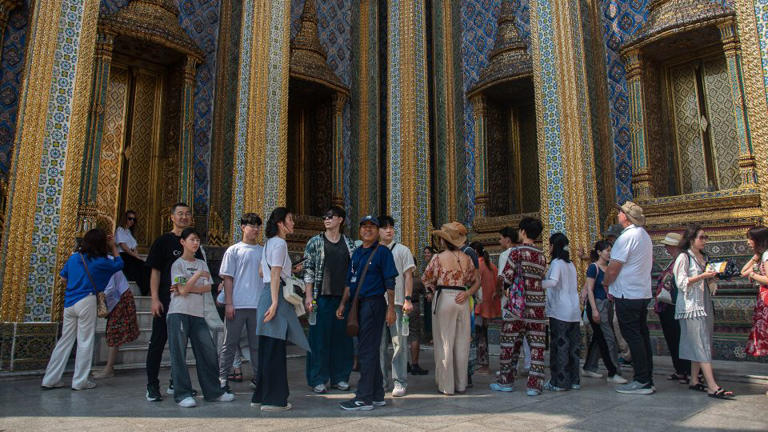
- India Tourism
- India Hotels
- India Bed and Breakfast
- India Vacation Rentals
- Flights to India
- India Restaurants
- Things to Do in India
- India Travel Forum
- India Photos
- All India Hotels
- India Hotel Deals
- Last Minute Hotels in India
- Things to Do
- Restaurants
- Vacation Rentals
- Travel Stories
- Rental Cars
- Add a Place
- Travel Forum
- Travelers' Choice
- Help Center
Starting to plan a trip to India in October 2024 - India Forum
- Asia
- India
Starting to plan a trip to India in October 2024
- United States Forums
- Europe Forums
- Canada Forums
- Asia Forums
- Central America Forums
- Africa Forums
- Caribbean Forums
- Mexico Forums
- South Pacific Forums
- South America Forums
- Middle East Forums
- Honeymoons and Romance
- Business Travel
- Train Travel
- Traveling With Disabilities
- Tripadvisor Support
- Solo Travel
- Bargain Travel
- Timeshares / Vacation Rentals
- Asia forums
- India forum

We are interested in wildlife, cultural experiences, culture, lifestyle, wildlife, mountains, spiritual yoga meditation. We don’t plan to focus on museums and history.
If you have references for a small group tour operator and lodges that would be helpful.
6 replies to this topic

// If you have references for a small group tour operator //
Most travellers who post on this forum are independent travellers, not participants in group tours, so your responses may be limited.
You won’t find an Indian operator in that market. If you want a small group tour you need to look in your own country.
Ideally, speak with a bricks and mortar travel agent near you.
Desktop research on providers such as Intrepid; G-Adventures; Abercrombie and Kent;
Alternatively a website like Tour Radar might be a good starting point for you.
https://www.tourradar.com/c/small-group-tours-india#month=october-2024,duration=21-51,group_type=372

You can visit Ranthambore national park ..Its only 350 -400 km from Delhi .
Rizwan Ahmed

I would suggest you to make plan as below:
Day 01 Arrive Delhi
Day02 Delhi visit
Day 04 Jaipur visit
Day 05 Jaipur - Ranthambhore wild life ( Approx.04 hours drive)
Day 06 Ranthambhore - Morning & Evening jeep safari to hop tiger
Day 07 Ranthambhore - Bharatpur Bird Sanctuary- Fatehpur Sikri- Agra ( Approx. 06 hours' drive)
Day 08 Agra - Taj Mahal as well as other monuments visit. Take an overnight train to Varanasi
Day 09 Arrive Varanasi in morning, relax after visit Varanasi
Day 10 Varanasi visit
Day 11 Varanasi - Delhi- Home ( by connecting flight )
If you have more time can add Udaipur in beginning for couple of days.
For Private group tour , you have to search a few overseas companies who operates India like Audley, Onthegotours, Intrepid etc.
Individual tour could be a little more expensive but enjoyable. You may contact any India based travel agencies for planning & cost.
Crabtree India Travels

One of the most famous tiger reserves near Delhi is Ranthambore National Park in Rajasthan . It's about a 4-5 hour drive or train journey from Delhi. You can also consider Jim Corbett National Park in Uttarakhand , although it's a bit farther from Delhi.
Besides tiger safaris, India offers a plethora of wildlife sanctuaries and cultural experiences. You might want to explore Bharatpur Bird Sanctuary in Rajasthan, Kanha National Park in Madhya Pradesh, or Bandhavgarh National Park for wildlife experiences. For cultural experiences, cities like Jaipur , Udaipur , Varanasi , and Agra (for Taj Mahal ) are must-visits.
If you're into mountains and spirituality, consider visiting Rishikesh and Haridwar in Uttarakhand.
You can also explore Dharamshala and McLeod Ganj in Himachal Pradesh , the residence of the Dalai Lama and a center for Tibetan culture and meditation.
Don't forget to add Kerala to your itinerary for a diverse range of experiences! Beyond its stunning beaches like Kovalam and Varkala, immerse yourself in the lush greenery of Munnar , a picturesque hill station known for its tea plantations and mist-covered mountains.
Venture into Thekkady for wildlife encounters at the Periyar Wildlife Sanctuary, and explore Fort Kochi for a taste of traditional Kerala culture, including Kathakali performances and mouthwatering seafood dishes.
And of course, don't miss the chance to cruise through the serene backwaters of Alleppey in a traditional houseboat.
Make sure to book your accommodations and safaris well in advance, especially for popular destinations like Ranthambore. Enjoy your trip to India!

You can even visit villages around and understand culture of Gond tribe and take hands-on experience for making bamboo basket etc.
Nearest airport will be Nagpur Maharashtra
And can move to Lonavalaor Mahabaleshwar for Yoga meditation centers
There are so many travel agents and tour expert here on TA (Trip Advisor) with good review, you can contact anyone. Better you can contact to Indian tour operators or and get the quote from 2-4 of them for better quotation.
Suggested travel companies - Intrepid; G-Adventures, Audley, Onthegotours, Intrepid etc.these are very expensive travel companies
I would suggest you below tour plan as below:
Day 01 - Arrive Delhi
Day02 - Delhi visit
Day 04 - Jaipur visit
Day 05 - Jaipur - Ranthambhore wild life (Approx.180 km / 4 hours drive)
Day 06 - Ranthambhore - Morning & Evening – Canter/ jeep safari
Day 07 - Ranthambhore - Fatehpur Sikri- Agra
Day 08 - Agra - Taj Mahal to Delhi
Day 09 - Delhi to Haridwar / Rishikesh
Day 10 - Jim Corbett National Park
Day 11 - Delhi- Home
Itinerary 2 –
Delhi 2N> Varanasi 2N>Agra 1N>Ranthambhore 2N>Jaipur 2N>Sariska 1N> & Delhi
Delhi/Varanasi by Flight & Varanasi to Agra by Train
Hope the above suggestions will helps you.
Fortunate India Tours
- 17 day itinerary through India (including 3 days in Nepal) 10:17 am
- 2 days in Delhi 9:59 am
- US Visa 9:53 am
- Kashmir trip along with Amarnath yatra 9:28 am
- CHAR dham yatra by helicopter 2024 8:55 am
- Best hotel in mussorie 7:29 am
- overnight Transit & Visa requirement 7:27 am
- Local Airtel Sim Card for Foreigners 7:14 am
- Darjeeling in early June 6:30 am
- Visiting kaahmir 6:19 am
- Need economical way to 6:12 am
- Starting to plan a trip to India in October 2024 5:56 am
- which area to stay in Mumbai for 3 days 5:07 am
- Best area to book my stay from airbnb in Mumbai 4:59 am
- Makemytrip.com 277 replies
- Weather beginning of January? 7 replies
- A perfect location for honeymoon in February 9 replies
- masoori(e) hill station 6 replies
- train from mumbai to kerala 12 replies
- Best places for honeymoon in June 7 replies
- Thomas cook india - europe tour review 97 replies
- Best Tour Operator for Europe - Thomas Cook/SOTC/Cox/Others 4 replies
- Easy Tours of India 12 replies
- New Years Eve Parties 2013 India (City) 19 replies
India Hotels and Places to Stay
- How to apply for e-Visa: 30 days, one year and five years
- How to apply for Regular Tourist visa (up to 12 months) (or from 1 to 5 years)
- How to transfer on an Indian airport between two flights, esp. with 2 tickets
- Trip Report for North Eastern States
- Post Your Just Back Reports / Trip Reports
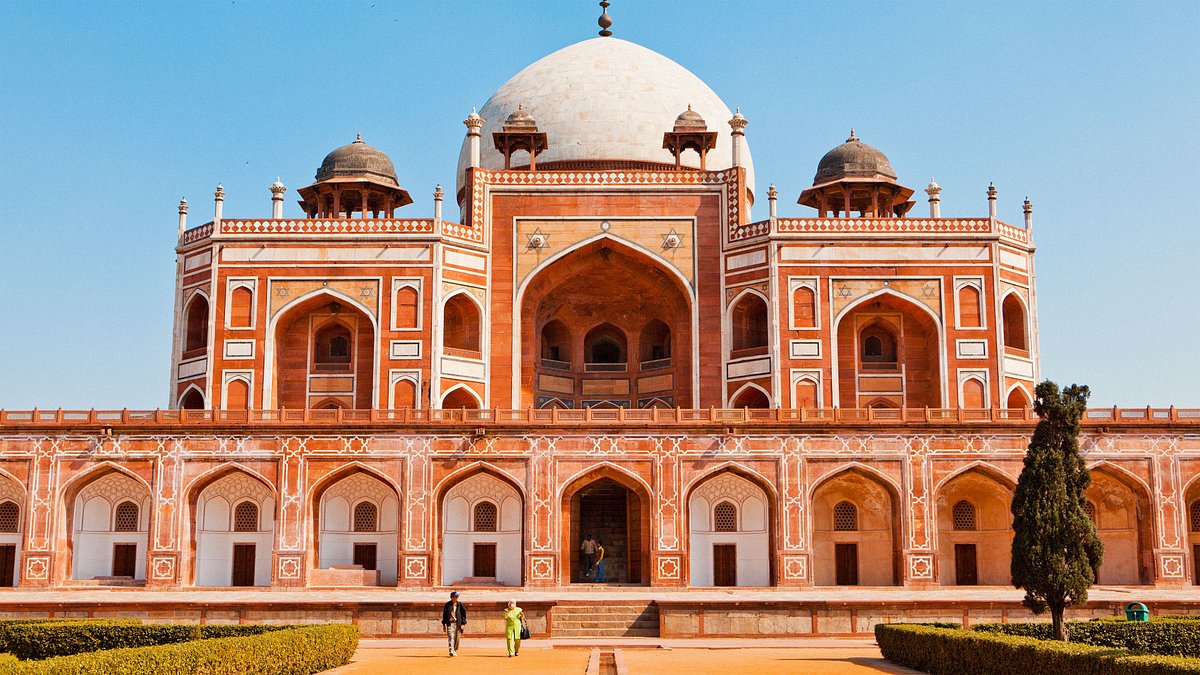

- 2 Weeks for Couple
- 2 Weeks for Family
- Thailand Lantern Festival
- Indonesia(Bali)
- South Korea
- China (HK, Taiwan)
- Itinerary Ideas
- Asia Highlights Travel Reviews
- Thailand Travel Reviews
- Vietnam Travel Reviews
- Cambodia Travel Reviews
- Japan Travel Reviews
- Myanmar Travel Reviews
- China Travel Reviews

How to Travel to Southeast Asia Well: 30 Travel Tips
Planning a trip to Southeast Asia? Southeast Asia is a fascinating region but it's very different. Before you depart, be sure to read these 30 essential Southeast Asia travel tips that will help you travel around the region like a pro!
1. Pack Light
Pack light, especially if you'll be traveling around Southeast Asia and taking public transportation. There's nothing more frustrating than trying to haul heavy luggage around.
Pack light cotton clothing as it is hot and humid in Southeast Asia. In most Southeast Asian countries, you can get your clothes washed and dried in hotels or laundries for just a couple of dollars. Also, it is easy to buy clothes at the street markets for very reasonable prices.
2. Pack Clothes for Temple Visits
If you are planning to visit temples in Southeast Asia, you need to know the dress code. The basic rule is to cover your shoulders and knees .
Therefore, make sure to pack an outfit that will cover your shoulders and knees — a scarf or shawl is very useful when you stumble across a temple that was not included in your plan.
3. Get Travel Insurance
It's always a good idea to have travel insurance when you travel to Southeast Asia. You might have prepared well but your body may not be prepared for the Asian spices, high temperature, or way of life.
Southeast Asia trips also often include some adventurous activities, such as trekking and scuba diving, so it's a good idea to have a policy in place.
4. Get Vaccinated
It is vital to get vaccinated against diseases and take necessary precautions for your Southeast Asia trip. Mosquito bites, upset stomachs, and malaria are common maladies affecting people residing in the tropics.
Many countries in Southeast Asia require specific vaccinations before you can enter them. Make sure to check their vaccine requirements and get the recommended vaccinations in advance.
Discover real reviews of Highlights Travel Family 's best-rated service across trusted platforms.
5. Be Smart about Currency Exchange
It is recommended to change your money in airports or banks where you can get a decent exchange rate even though you might need to pay excessive fees. You can also use local ATMs to withdraw the local currency as they will use the banks' exchange rates.
Be aware that many hotels offer a currency exchange service but they generally offer terrible exchange rates.
Every country in Southeast Asia has a different currency. Calculate how much local money you need so as to avoid having too much money left over that is not accepted in your next destination.
6. Take Some Cash with You
Visa and Mastercard branded credit cards, debit cards, and travel cards are widely accepted in major tourist destinations in Southeast Asia but you will still need some local money. You will need to have cash for street market vendors, taxi drivers, and smaller restaurants.
In rural areas, cards will not be accepted and ATM availability is not guaranteed so make sure you have enough cash to cover your planned expenses.
It is also necessary to carry some US dollars in cash too, as this might be required at the port of entry to pay the fee for your Visa on Arrival.
7. Don't Be Afraid to Bargain
It is normal to bargain in Southeast Asia. It is a way to engage with the local people and try to get a fair price. You can try to bargain with local street vendors or at the markets. Just remember to barter reasonably and always with a smile on your face.
8. Don't Drink the Tap Water
Tap water in Southeast Asia is undrinkable so you should buy bottled water, which is cheap. You can always find cold bottles of water available.
9. Expect Squat Toilets in Most Places
Squat toilets are common in Southeast Asian countries. Expect to find these toilets in most places, such as restaurants, tourist attractions, and other public places.
These toilets require a bit of getting used to but don't worry as most hotels have normal Western-style toilets.
10. Take Your Own Toilet Paper
Toilet paper is rarely found in public restrooms in Southeast Asia. Carry toilet paper or tissues with you wherever you go.
11. Buy a Local SIM Card
If your current cell phone carrier doesn't offer an affordable service overseas, you can buy a local SIM card that will keep you covered. This could be very helpful for your long trip in Southeast Asia. SIM cards are cheap and the coverage is incredible, even in some remote places.
12. Respect the Local Culture
Southeast Asia is the perfect place for leisure and vacations but be aware that there is a very different culture. It is advisable to learn about the culture before you travel. Here are several common things you should know:
- Cover your arms and legs when you visit temples.
- Don't stare at people praying.
- Avoid taking pictures of monks unless you have permission.
- Don't touch anybody on the head. The head is considered to be sacred in some religions.
- Avoid displaying your soles and take your shoes off at temples.
13. Be Wary of Scams
Travel scams exist all over the world and Southeast Asia is no exception. Here are some common scams in Southeast Asia:
- Beggars, monks, or kids walk around and ask you for money.
- Fares are overpriced when taking taxis or renting motorbikes. Agree on a taxi price before you get in.
- Scams occur when exchanging money with individuals on the street. Always exchange your currency in legal establishments.
- Scams occur when you're offered cheap and VIP bus tickets.
- You might be told that an attraction or temple is closed when it actually isn't. Check it in person.
14. Try Street Food
If you want to taste authentic local food, find places where the locals eat. It is easy to find food streets and food stalls in each country in Southeast Asia.
Most of the restaurants won't look very safe but try to choose restaurants where the local people eat — the more people at a restaurant or food stall the better.
15. Don't Overplan
It is necessary to have a planned itinerary before your trip but an unexpected challenge is often thrown in midway through the plan, such as a flight delay, a visit to an unplanned attraction, or overstaying at a beach you have particularly enjoyed.
Be sure to leave some unscheduled time in your itinerary for downtime and also for wandering around.
16. Try Local Transportation at Least Once
Trying the local transportation is a great way to experience the local culture. Tuk tuks, motorbike taxis, or tricycles are a great way to get around. They are cheap and they always make for an adventure while traveling in Southeast Asia.
17. Watch Out on the Sidewalk
You might think of it as an adventure as you weave your way across the lanes of motorbikes in some Southeast Asian countries, such as Vietnam.
Sometimes, motorbikes drive on the sidewalks and rarely stop for traffic lights. One trick is to be careful and follow the crowds to get across the roads.
18. Learn Some Phrases in the Local Language
There are different languages in different Southeast Asian countries. Most locals don't speak English.
Learning a few phrases of the local language would further enhance your experience in Southeast Asia. Learning how to say 'hello' and 'thank you' are a good start and the local people will really appreciate it. Everyone loves a foreigner who speaks the local language.
19. Don't Worry Too Much about the Weather
The best time to visit Southeast Asia is from November to April (the dry and cool season) if you care about the weather. Even if you are traveling in the wet season, you don't need to worry too much about the weather as the rain often only lasts for several hours in the afternoon or at night.
You can still enjoy a good time as long as you plan well and make the most of your time when it doesn't rain.
See our detailed information about the Best Time to Visit Southeast Asia and Tips for Traveling in the Monsoon Season .
20. Check Southeast Asia's Travel Visa Requirements
Most Southeast Asian countries allow visa-free entry or a Visa on Arrival for stays ranging from 2 weeks to 3 months for certain nationalities.
See all things about Visas for Southeast Asian Countries .
21. Don't Worry — Southeast Asia Is Safe
Generally speaking, Southeast Asia is a very safe place for travelers. It's rare to get robbed or mugged.
People are nice, respectful, and friendly. In fact, it's one of the safest regions in the world for female travelers, solo travelers, and families.
22. Always Carry Your Passport
If anything should happen to you, it would be essential for you to have your passport, especially if you are unable to get back to your hotel. You never know what could happen and it's always better to be prepared for anything.
23. Get Off the Beaten Path
The top cities and attractions will definitely be on your must-see list but don't be afraid to get off the beaten path a bit and explore some alternative destinations and sites around Southeast Asia.
The famous attractions are usually crowded, especially during the peak season. Don't be afraid to leave the usual tourist routes and try something new and different.
24. Learn about Tipping in Southeast Asia
In most Southeast Asian countries, there is no tipping culture . It is not customary to tip in most situations.
Tips are rarely expected in restaurants and bars but porters or housekeepers in hotels and tourism providers, such as tour guides, are likely to be used to receiving tips.
25. Be a Responsible Traveler
With so many tourists visiting each year, cities are getting more and more crowded but much of Southeast Asia is inherently mired in poverty. You can help the local people when you make the right choices on your trip.
Don't give money to beggar children near tourist attractions as the money they make is often turned over to a boss or family member. If the children get money continuously, they will never be given a chance at a normal life.
It's best to avoid orphanage tourism, hill tribe visits, or any activity that exploits children, ethnic groups, or animals. When participating in elephant tourism, make sure to carefully vet the organization and make sure they're protecting the animals rather than harming them.
26. Book Your Flights Early
You can usually get the best deals for international flights to Southeast Asia and flights between countries in Southeast Asia by booking early. Start keeping an eye out for cheap flights as early as possible.
27. Don't Underestimate the Jet Lag
Sleeping in a new bed is hard enough but when you add over 10 hours' time difference once you're in Southeast Asia, it's all over! Leave yourself some time to rest and relax on your first or second day when you arrive in Southeast Asia.
28. Don't Try to See It All
Traveling to Southeast Asia for the first time is very exciting and you're going to want to see as much as you can. You need to know that Southeast Asia is a huge region filled with many bucket list destinations screaming to be visited.
Unless you're staying in the region for a year, don't try to see it all in one trip. See our detailed recommendations about How to spend your time in Southeast Asia: from 2 weeks to 3 months .
29. Get Used to Selfies with the Locals
In some places in Southeast Asia, the locals are not used to seeing foreigners on a daily basis. Do not be taken aback if they stare or ask to take photos with you.
30. Don't Expect Anything to Be On Time
People in Southeast Asia are a lot more relaxed and don't care about time as Westerners do.
Travel in Southeast Asia with Us
Traveling in Southeast Asia is a treat. Plan in advance and keep an open mind and heart. To make your first trip to Southeast Asia a great one, contact us. We're here to help you tour Southeast Asia your way.
Why Asia Highlights (10,000+ reviews & 98.8% 5-star rating)
- Save Your Time:
- Less research, more enjoyment!
- Real-time 1V1 expert planning
- Maximize Your Flexibility:
- Personal local guide and ride
- Explore at your own pace
- Celebrate Your Journeys:
- Specially-crafted family adventures
- Celebrate milestones with style!
- 15-Day Best of Thailand, Cambodia, and Vietnam Tour
- 19-Day Highlights Tour of Southeast Asia: Thailand, Cambodia, and Vietnam
- 14-Day Classic Vietnam and Thailand Tour
- 12-Day Best of Thailand and Cambodia Tour
- How to Visit Thailand, Cambodia, and Vietnam 2024: 10, 14 and 21-Day Itinerary Ideas
- How to Plan a Trip to Southeast Asia 2024 (First-Timers' Guide)
- Southeast Asia Itinerary for 2 Weeks 2024 (Tailored for Beginners)
- Southeast Asia Itinerary for 3 Weeks: Best 5 Ideas in 2024
- Southeast Asia Weather in January, Where to Go
- Southeast Asia Weather in February, Where to Go
- Southeast Asia Weather in March 2024, Where to Go
- Southeast Asia Weather in April 2024, Where to Go
- Southeast Asia Weather in May 2024, Where to Go
- Southeast Asia Weather in June 2024, Where to Go
- The 6 Best Places to Visit in Southeast Asia in July (2024)
- The 6 Best Places to Visit in Southeast Asia in August 2024
- Southeast Asia Weather in November 2024, Where to Go
- Southeast Asia Weather in December 2024 & Best Places to Go
Get Inspired with Some Popular Itineraries
At Asia Highlights, we create your kind of journey — your dates, your destinations, at your pace. You can have any trip tailor made for your travel.
More Travel Ideas and Inspiration
Sign up to our newsletter.
Be the first to receive exciting updates, exclusive promotions, and valuable travel tips from our team of experts.
Why Asia Highlights
Where can we take you today.
- Middle East
- African Safari
- Travel Agents
- Loyalty Program
- Our Differences
- Privacy Policy
Address: Building 6, Chuangyi Business Park, 70 Qilidian Road, Guilin, Guangxi, 541004, China

IMAGES
VIDEO
COMMENTS
This is my first time planning a trip round southeast Asia. we are planning of going for two months in April-May 2024. we would like to go to Thailand, Lao, Cambodia, Vietnam, Singapore, Philippines and finish in Bali for 10 days. we only want to be in Singapore for 3 days.
Southeast Asia is one of the best regions to backpack in. It's fun, affordable, safe, and has something for everyone. But it can be tricky to plan a trip here, as there is a ton to see and do. So, as you try to craft the perfect Southeast Asia itinerary, just keep in mind that plans change.
Check out more on our Best Times to Visit Southeast Asia. 4. Plan Your Budget. Traveling in Southeast Asia is way cheaper than in Europe and North America. A private tour in this region becomes an affordable indulgence, promising a luxurious experience without breaking the bank. Hotels here won't break the bank. A 3-star hotel in Thailand is ...
Costs for a 10-Day Southeast Asia Tour. Southeast Asia offers great value for money. A private tour in Southeast Asia is actually an affordable luxury, which would add exclusivity and convenience to your trip. A 10-day Southeast Asia tour costs around US$200-250 per day per person, when offering quality 4/5-star hotels, nice meals, and ...
How to Plan a Trip to Thailand and Vietnam; 2 Weeks in Thailand and Vietnam: Perfect Itinerary Ideas; Itinerary #5: 2-Week to Singapore and Bali (Rainy Season Retreats) Escape to Singapore and Bali between April and October for SE Asia's best weather, when most Southeast Asian countries are experiencing their rainy season.
This is the ultimate Southeast Asia itinerary with options ranging from 2 weeks to 3 months incorporating all kinds of different travel styles and interests. ... or a group of friends, Southeast Asia's bound to have something intriguing for you. This could make planning a trip to Southeast Asia overwhelming - there's just so much to see ...
Southeast Asia is a fascinating part of the world that offers beautiful islands, beaches, lush jungles, unique wildlife, tasty food and intriguing culture. This Southeast Asia travel guide is designed to uncover some of our favorite places and things about this region and help you plan your own trip to this unique part of the world.
1. Vietnam. Start in colonial streets of Hanoi(1), the country's historical, political and cultural capital. Go for a sail around the famed natural wonders of Ha Long Bay(2), before heading to the northern hills to the ethnic minority villages orbiting Sa Pa(3). Take the train down to imperial architecture of Hué(4), make a day-trip to the ...
8. Check the weather when planning your trip to Southeast Asia. Generally speaking, October - March is the best time to travel in Southeast Asia as this is the dry season and the weather is cooler and more manageable. However, research the individual countries you want to visit to plan which month would be best for you to travel. 9.
A comprehensive budget travel guide to Southeast Asia with tips on things to do, ways to save money, transportation, accommodation, and more. Nomadic Matt's Travel Site ... Check out all the articles I've written on Southeast Asia travel and continue planning your trip: The 4 Best Hostels in Singapore; The 6 Best Hostels in Bali; The 22 Best ...
For a luxury trip such as a honeymoon, plan to spend around $3,000 or more for two people. This will allow you to stay in luxury resorts, join culinary classes, and private tours, and dine at fantastic restaurants. ... Vietnam with Laos itinerary is an excellent Indochina trip and 3 weeks in Southeast Asia destinations since they share a land ...
Using this innovative tool, you will get a shortlist of the best hotels in each city, selection of the most convenient connections, a range of activity suggestions, and, most importantly - travel specialist assistance upon saving your dream itinerary to South East Asia. By the way, if you think that planning your trip is too much hustle on your ...
To Recap: Here is A Summary of the Perfect 3-Week Southeast Asia Itinerary. Days 1-2: Travel days plus a stopover in Seoul on the way to Hanoi. Day 3: Explore Hanoi, Vietnam's Old Quarter and take a food tour. Days 4-6: Enjoy the most amazing cruise to Bai Tu Long Bay.
HOTELS: 137 Pillars House (Chiang Mai) + Anantara Golden Triangle (Chiang Rai/Border Region) From Shanghai, we begin the core of our adventure in Southeast Asia, starting in Northern Thailand. One of the major pieces in decision-making in terms of mapping out this itinerary was the way in which flights would work to be most sensible.
Vietnam. Another giant you can't avoid during your 2 month Southeast Asia itinerary is Vietnam. I sort of consider Vietnam a wilder and more unruly Thailand, somewhat resembling an older version—maybe 10, 15 years—of the Kingdom. I usually like to go south-to-north, but you can reverse this order if you prefer.
Lastly, one of the most important things for planning a trip to southeast Asia, visas! Most countries will allow you to get a visa on arrival but there are some exceptions. Myanmar and Vietnam both require visas in advance. You can get these from an embassy or online depending on how you are travelling into the country. Visas range from free to ...
Plan A Trip to Southeast Asia with Us. You are warmly welcome to have us customize your trip based on your group size, interests, and other needs. Sit back and use our Create My Trip service. Or start from a recommended fully-modifiable itinerary: 19-Day Highlights of Thailand, Cambodia, and Vietnam; 21-Day Thailand and Vietnam Adventure Tour
Beginner travelers should check out these travel tips and follow this Southeast Asia travel advice when considering a visit to the region for the first time. 1. Pick your countries wisely. While it's tempting to visit many countries and cities on a single trip to Southeast Asia, it's worth taking it slow and digging into the culture of a single ...
The Best Mobile Banks & Travel Cards. The cost of backpacking Southeast Asia. 28 Tips to Save Money on the Road in Southeast Asia. 🚗 STEP 5. Apply for an International Driving Permit. If you're thinking of hiring a motorbike or a car whilst in Southeast Asia you will need to apply for an International Driving License in advance of travel.
Southeast Asia encompasses many countries, including Malaysia, Thailand, Vietnam, and Cambodia for example. Each of these has its own challenges that travelers may need to overcome during their trip.
E mbarking on a backpacking adventure through Southeast Asia is a dream for many travelers seeking vibrant cultures, stunning landscapes, delicious cuisine, and unforgettable experiences. With its ...
By far the largest country in Southeast Asia, Indonesia lies at the southern end of the region and consists of roughly 17,500 islands, including Sumatra and Bali. With so many islands, it's no ...
Vietnam Packing List in A Carry-on. The family packed everything in a carry-on suitcase for this trip due to the intensity of the travel. And let me tell you…packing for a 2-week trip in a carry-on suitcase, with an itinerary full of activities, in two countries with very different climates, was REALLY hard.
Southeast Asia is the "obvious" choice because of its "proximity to China," Bowerman adds. ... Wei says she is now planning a summer trip to Laos, Cambodia and possibly Thailand, to visit ...
Embarking on her tenth large-scale solo concert tour and the only Southeast Asia stop of the tour, the show promises a spectacular upgrade in every aspect. From state-of-the-art hardware equipment to captivating performance effects, the show is sure to be unforgettable experience that will exceed all expectations.
The most popular destinations in Southeast Asia are Thailand, Vietnam, Cambodia, Myanmar, Laos, Bali (Indonesia), and Singapore. For a 4-week trip to Southeast Asia, we recommend you visit 4-5 countries.. A highly recommended combo for a 4-week tour in Southeast Asia is Thailand, Vietnam, Cambodia, Laos, and Myanmar.This combination offers a rich tapestry of experiences, ranging from pristine ...
Starting to plan a trip to India in October 2024 12:57 am; 2 days in Delhi 12:44 am; Anjuna taxi 12:37 am; Hawa Mahal (where to take photos) 11:10 pm; South Trip 11:06 pm; Indigo payment failed yet still charged account 11:06 pm; Can we cover Yumthang, Zero point and Katao same day 11:03 pm; Road condition in Lachen 10:51 pm; Club Mahindra ...
The short video and live streaming platform operator aims to replicate its strategy in overseas markets, focusing on big opportunities in the Middle East, North Africa, Brazil and Southeast Asia ...
The Association of Southeast Asian Nations has been the main beneficiary of China's fading appeal as a destination for foreign investment, with 21 per cent of respondents having already moved ...
Planning a trip to Southeast Asia? Southeast Asia is a fascinating region but it's very different. Before you depart, be sure to read these 30 essential Southeast Asia travel tips that will help you travel around the region like a pro! 1. Pack Light. Pack light, especially if you'll be traveling around Southeast Asia and taking public ...